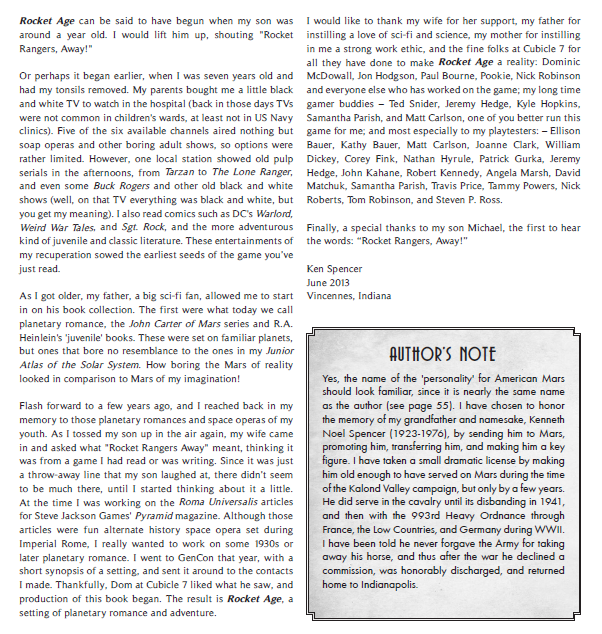Rocket Age by Hostile V
Teaser
Original SA post Rocket Age .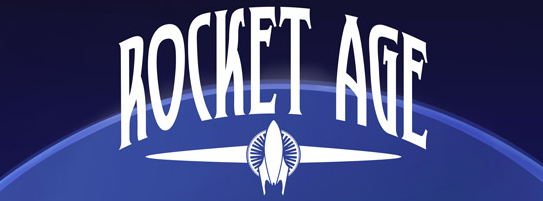
ROCKET AGE is an atomic pulp sci-fi tabletop RPG by Cubicle 7 games that runs on the Vortex System (also used by their Doctor Who game). Vortex uses point-buy character building and d6 dice and emphasizes talking and thinking before fighting and shooting (in true Doctor Who fashion). The setting is Pulp Adventure! with an influence from Burroughs, Heinlein, More, Brackett and Stark. The heroes are square jawed and will only kill if they have no choice, the villains are flawed (and may have a redeeming trait or two that might let them become good if given the chance) and everything is shiny and portable. The writers admit that unironic black-and-white morality might not be everyone's bag, but here's the thing I really like about Rocket Age: you're not just fighting "bad guys" to make the world better.
Rocket Age is set in the 1930s and the writers know it. The planetary colonies are run by nations and the ugly side of colonialism is in full force with humans enforcing/balancing national culture with native aliens and encroaching on land. Nazi Germany and the USSR are big players in space and we're talking Stalinist Russia. The book provides ethnic slurs for the alien races that you might hear a big-hearted asteroid miner drop casually in polite conversation. We brought the culture of Earth to space, including all the bad parts. We didn't mean to, but it's still on us. In Rocket Age, you fight to make the solar system a better place because it is the right thing to do . We may have opened Pandora's Box to the planets, but we can bring hope and make things better.
NEXT TIME, we'll get into just how mankind started to explore the stars, cursory glances of the planets of our solar system, the intelligent species (sophonts) of the stars and mankind's colonies.
RECENT HISTORY
Original SA post
RECENT HISTORY
The first manned spaceflight took to the skies on April 17th, 1931. The ship, The Eagle, was designed by Nikola Tesla, Albert Einstein and Robert H. Goddard. Einstein and Tesla were on the ship (it launched from Tesla's lab in New York) but Goddard was ill and was instead replaced by a young pilot named Ray Armstrong who took the controls. It took six months of travel (and lots of minute adjustments and learning moments along the way, such as the invention of the space suit and the space walk) but Einstein, Tesla and Armstrong were the first humans to walk on Mars outside of the city of Jilvar. The three astronauts took to learning Martian and were well received by the people of Jilvar and their Prince, Javos. Armstrong explored the city with the help of guides while the scientists were showed the most sacred of relics: ancient machinery created by the ancestors of the Martians. After three days of study, Tesla and Einstein made it more efficient and Earthling/Martian diplomacy was off to a grand start.
The three astronauts lived on Mars for six months, working with Javos to create the first trade agreements and accrue everything they could about Mars. After six months of travel back, the three were hailed as world heroes. Armstrong and Goddard opened a rocket company together, Tesla kept returning to Mars to study energy weaponry and Einstein would invent the first trans-relativistic drive for space ships, setting out in 1937 with a new ship to explore beyond Pluto.
That's all well and good for Tesla, Goddard, Einstein and Armstrong but what about the rest of the world and the planets?
Mars is the big point of interest in the stars for Earth's nations. Mars is known for being beautiful and exotic, an easy mark for people who want to make big money. America, Britain, France, Italy, Nazi Germany and the USSR all have colonies on Mars and there's problems balancing mankind's interests with the fact that Mars has its own culture, its own people.
Venus is a tropical death world, lush and teeming with natural resources: diamonds, gold, radium. The jungles are full of primeval thunder lizards, giant insects, deadly pockets of gas, disease and the native Venusians, a species of ape-people.
Jupiter is home to the Europans, a race of psychic humanoids who claim themselves to be lords and masters of the solar system. The Europans can back up those claims, possessing technology that blows the old weapons of Mars out of the water. Tensions between Earth and Europa are frosty to say the least and until recently were barely allowed to go past Mars' asteroid belt without taking a warning shot from a Europan ship.
As for Earth? Well, the technology boom is spreading across the world, the big kicker being the invention of nuclear power. Radium is the rock of choice, doing everything from helping power ships to make flamethrowers burn brighter but this isn't Fallout: radium is still dangerous and will not give you super powers. Radar has already been invented, radio is the big form of communication, computers are still the size of a house, vacuum tubes might be on their way out, Tesla has officially invented the RAY gun and every nation worth its salt can offer either cleaner industrialization or rocket weaponry, jet planes, machine guns or big bombs. The major nations are the USA, the Empire of Japan, Italy, France, Germany, the British Empire and the USSR. Despite some nominal divisions (pre-WWII style, it's USA, France, England and the USSR vs. Japan, Italy and Germany), every power is stepping on the other to stake a claim in the stars. Mankind is directly engaged in colonization of Mars, Ganymede and Venus and there's still so much more out there with ships only going so fast. Publically, they don't even know what to do with the Europans. This isn't even counting "lesser" nations that want to join the others as a big power.
Sophonts and You: Intelligent Beings of the Solar System
The discovery of alien intelligence has not been well received by the public at large. Yes, many good men and women of Earth are willing to accept that Martians are sapient beings. There are also people who believe that mankind must unite as one to stand up to the alien menace or believe the aliens to be lesser beings. The biggest thing that changes people's minds is, of course, to live and work alongside another sapient species. The US Rocket Corps and the Rocket Rangers are space rangers who have become excellent friends with species across the solar system and are essentially leading the charge to accept them. The USSR is happy to teach aliens about Communism, the Catholic church is charging theologians with debating the topic, there are Methodists and Unitarians spreading the word on Venus and Mars and some governments and religions just remain mum or pro-human on the subject. Aside from those examples? Well, it comes down to individual belief, but the game assumes that the player characters are the sort of people to be open-minded and accepting (plus you can play as alien beings). Let's take a look at the sophonts:
Earthlings: Officially we go by Earthlings. I like the name Terran more, but Earthlings works fine.
Europans: Europans all have an aptitude for psychic powers and a generally condescending attitude. Those are stereotypes, mind; what's definitely known is that they want to know more about mankind and Europans are sending out emissaries in the forms of doctors, teacher, scientists to spend time with us and learn. Europan biology is complicated and not really well understood by us (especially because it's the 1930s) but they have roughly five genders.
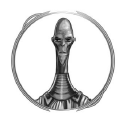
A Europan.
Ganymedians: Ganymedians aren't particularly advanced and that kind of puts them in a weird position with mankind on their planet. They're symbiotic organisms made up plant and fungal species working together.
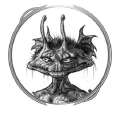
A Ganymedian. If you thought I was describing an Ork, you're sorely mistaken.
Ioites: Io used to be a civilization on par with the Europans until the Europans nuked them back to the stone age (for reasons not entirely clear). They were once a humanoid species like Earthlings or Martians but now they've been afflicted with mutations and damage, walking with a hunch and marked with irregularities. But make no mistake: the people of Io are survivors.
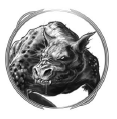
An average Ioite.
Venusians: Venusians are the apex species of Venus and the only mammals, a hardy and strong race of ape-like humanoids. They may seem primitive, but Venusians have a rich oratory history and a love for philosophy and logical debate. Plus if you call them primitive it's a good way to get your skull beat in.
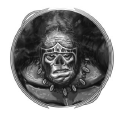
Portait of a Venusian.
Martians: Martians are different than the others. If the Europans are Elves in attitude, then the Martians are Elves in sub-species. Millennia ago, a near-extinction event on Mars resulted in the creation of the Martian caste system. This involved the creation of actual subspecies of Martian divided by caste, only fertile within their own caste. They all lay claim to the name "Martian" but there's more to them than that. There's more specific nuance to it all because there's quite a bit about Martian politics and bureaucracy but the seven types of Martian are:
- Chanari: The Chanari live outside of the caste system, roaming the deserts in a nomadic lifestyle. The arrival of the Earthlings hasn't changed their lives much, now they just have new strangers to deal with.
- Julandri: The Julandri have two main sub-castes, the Laborers and the Courtesans. As a whole, Julandri fill niche roles in Martian society. The Laborers lift, carry and work long hours doing repetitive things. The Courtesans fill the same roles as Geisha, being intelligent and beautiful men and women trained to entertain and converse.
- Kastari: The Kastari are the priests of Mars, tied to minor sects, important sects or big sects like the Orthodox Fellowship or Order of the Sacred Hamaxe. Kastari generally live well (especially if they're in a good sect) and are the only caste that allows promotion between the sub-castes/sects.
- Maduri: The Maduri are the warrior castes, known for being brave and ferocious. They live nicer lives and are counted as an upper caste because the upper castes know if the Maduri were to be mistreated, they would turn on Mars and wreck things for everyone. In practice, they just enjoy the privileges of being upper caste without any of the niceties because they don't want to go soft.
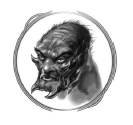
A Maduri Martian.
- Pilthuri: On paper, the Pilthuri are the merchant class. In execution, they're the diplomats, the salesmen, the administrators that travel Mars to get things done.
- Silthuri: The Silthuri are the noble caste with the upper sub-castes acting as princes and rulers and the lower sub-castes being relegated to bureaucracy and making sure Mars keeps running. In theory, they're princes and nobles. In execution, they're generally tyrants.
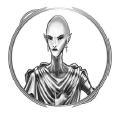
A Silthuri Martian.
- Talandri: The Talandri are craftsmen and the nature of Mars' focus on tradition means they've been confined to making the same things for centuries. The arrival of Earthlings might be the best thing to ever happen to them.
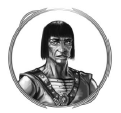
A Talandri Martian.
A note about the setting: there's a lot that's happened between 1931 and 1938. This may be too many changes too soon for some people or it may not. Adjust the timeline as you see fit; maybe you want to set it in the 40s or 50s. That's up to you. For the review, we're going to keep the clock on 1938.
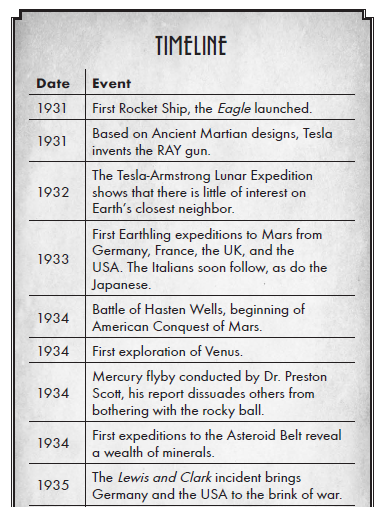
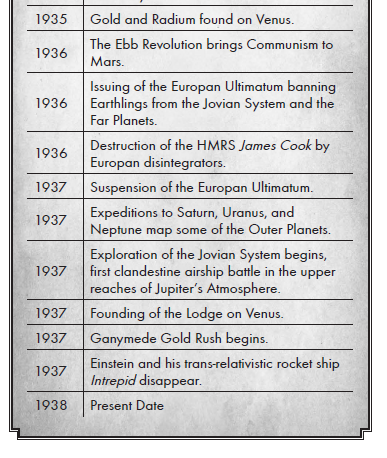
NEXT TIME: Welcome to Mercury and Venus and Luna.
TOUR OF THE SOLAR SYSTEM: MERCURY, VENUS, LUNA
Original SA post
TOUR OF THE SOLAR SYSTEM
MERCURY
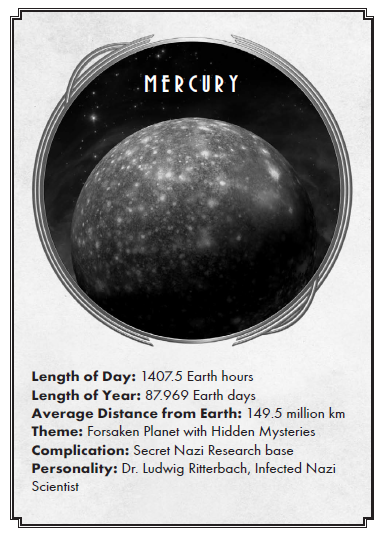
Mercury is not a fun place to live. The side that faces the sun is boiling hot all the time, the side that faces away is a frozen nightmare. The atmosphere is nonexistent, the gravity is light. None of the flyby expeditions of Mercury have picked up anything of interest; it's not even worth trying to mine there. People would rather try to mine Venus than Mercury.
This is perfect for the Nazis, who've built a base called Festung Sieg on the dark side of Mercury beneath the ice and rock. Festung Sieg is a gigantic stockpile of Nazi technology, gasoline, food for a decade of constant war. SS supertroops are being trained and kept in constant circulation and Nazi scientists are working around the clock on reverse-engineering even more Ancient Martian technology, testing it and training the SS and Wehrmacht in its use. The fortress is the supply base for the Nazi's efforts, providing their supplies and resources for battle on Mars. They could wage World War II using the fortress' supplies alone and still have plenty saved on Earth and Mars.
In addition to the Nazi war machine, there's the sinister Nazi science labs. The doctors are working on three main projects. The first is testing weapons and materials on captured subjects, making them test experimental implants and grafts before using them on their own soldiers. Second, and the biggest project by far, is the raising of Aryan ubersoldaten in isolation except for Party ideology and training to make them reach the pinnacle of human perfection. Third, and related to the Aryan project, is research into cloning technology to create artificial Aryan soldiers without needing a human mother, only a mechanical womb. Out of the three projects, the second has borne the most fruit; the oldest Aryan supersoldier is...five years old. Then there's the worst of it all: Lab 8, home of the Nazis' genetic engineering programs. The scientists of Lab 8 are the most dangerous/most loyal scientists the Reich has and take orders only from Hitler. Their mission is to try to hybridize alien races and mankind or transfer genetic traits. So far, hybridized insemination hasn't succeeded in creating a Venusian/Earthling or Martian/Earthling and the only experiments who've survived splicing make a terrible menagerie of monstrous, deformed or insane captives. For the sake of the solar system, they have not succeeded.
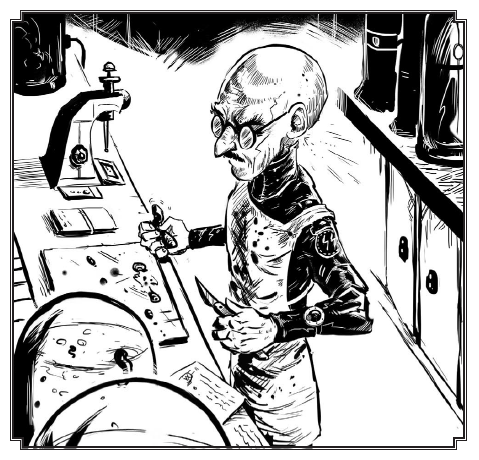
Doctor Ritterbach, Nazi madman/scientist.
The head of Lab 8 is Doctor Ludwig Ritterbach, a true believer in the Reich and complete sadist. The doctor is constantly calm in the face of the horrors of Lab 8, and this scares the other scientists; they're either in awe of the strength of his mind or convinced he's a shell of a man about to snap). The fact of the matter is that Ritterbach is probably the Nazis' biggest problem but they don't know it yet. One of the subjects from Venus, a parasitic species of slugs, was far more intelligent than he expected and it burrowed into his spine one night after escaping captivity. Ritterbach is a walking body providing knowledge and mobility for the slug who is actively sabotaging the doctor's programs for its own purpose: to reproduce. The slug hasn't had any success yet (what it wants to do is alter the doctor's biology so it can reproduce biologically through a human host that way) but it's working on it and there's plenty of new hosts in Festung Sieg.
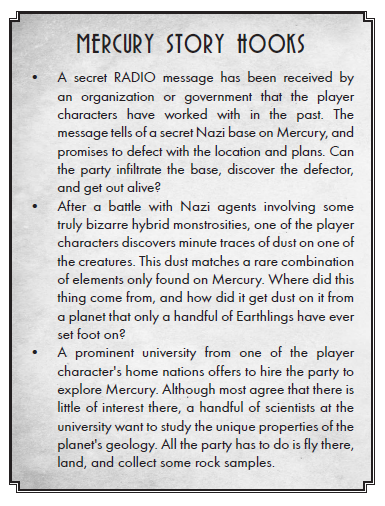
VENUS
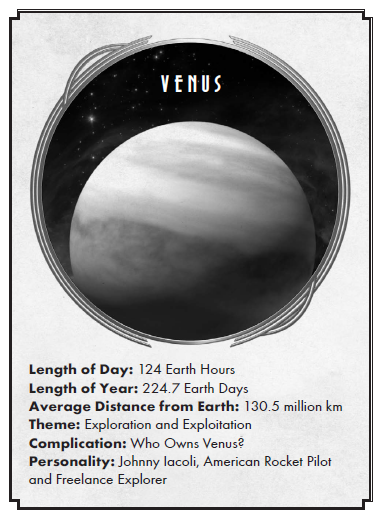
Beautiful and deadly go hand in hand on Venus. The temperature swings from 24 to 41 Celsius from morning to noon to night with constant humidity. The planet is full of jungle mountains (highlands) and valleys (lowlands) with only the mountains being safe for humans to explore; the lowlands are shrouded in a fog with temperature and air pressure increasingly dangerously the further one goes. Nobody has gone below the fog and returned. The wildlife is dangerous, most of the fruits are poisonous, it's constantly hot and muggy on Venus and the Concordats (tribes/clans) of Venusians are of mixed opinion about the presence of humans.
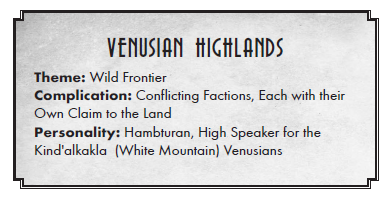
The Highlands are the main focal area of Venus and so the main areas are laid out around the Highlands, especially focused on Ishtar Range. The Range is home to the Kind'alkakla (White Mountain) Concordat, a clan of Venusians who are mostly tolerant of human presence. The presence of corporations and nations of Venus are responsible for the colonization of the planet and bring most of the people (and problems). The main places of interest on Venus are Fort Washington, Roosevelt Station, Livingstone Lodge, the Ore Fields, Algontawanala and the Grand Crater. I like how the book starts with the places most important to the Venusians because it's their planet.
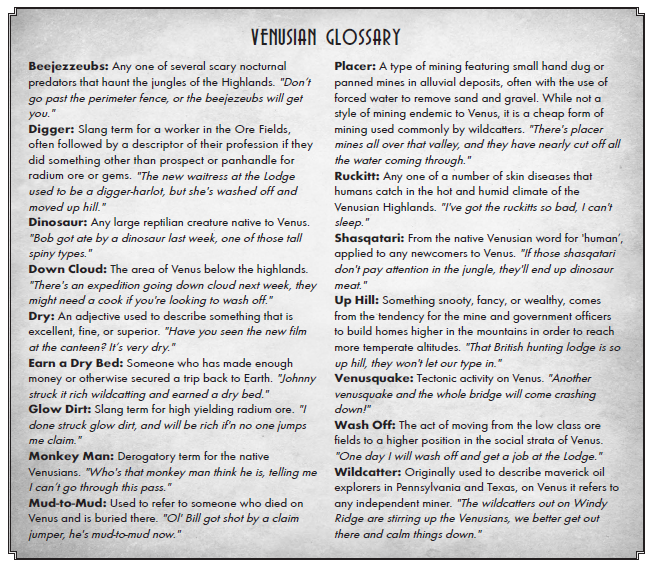
Normally I'm not one for slang in tabletop RPGs but oh goodness Rocket Age does it well and does it believably.
Algontawanala is Venusian for "Tower of the People", a holy site on top of an extinct volcano in a caldera made of concentric blossoming rings like a ripple in a pond. The Tower (let's call it that for the sake of brevity) has nine rings with the ninth being the outmost and the first ring containing a giant stone tower. The Tower has two purposes. First, it's a place of gathering where the Speakers can come and address the Kind'alkakla or engage in religious rituals of dance and scarification. Second, it's a shelter from natural environments and war, each ring of the caldera holding supplies and living quarters and defense. Both reasons are why you can live on the Tower; Venusian meetings can last for weeks.
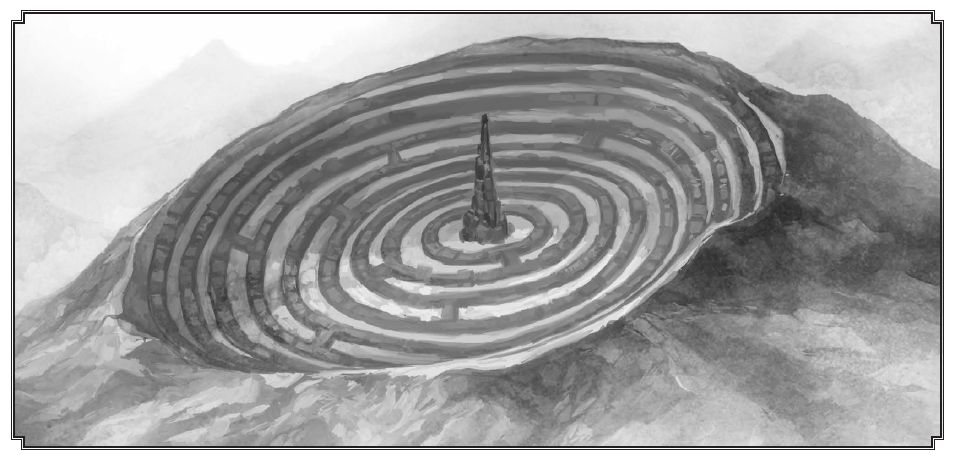
Algontawanala, sacred Kind'alkakla site.
There's a big problem with the Tower, though: it's on top of a massive radium deposit (which has health effects on the Venusians but that's not why it's an issue). The Allied nations (USA, Britain, France) won't bother with trying to get access to Tower because they have the Ore Fields. Nations who aren't mining the Fields (specifically Japan and Germany) are trying to pressure the Kind'alkakla into giving them access. They're refusing, naturally, and Japan is preparing to try and take it by force. Which brings us to the secret alliance that the Kind'alkakla have forged with the USSR. The Venusians get guns and weapons to help defend themselves (and provide a nasty surprise) and in exchange some of their warriors will act as shock troops for Soviet activities. If the Japanese push their luck, things will quickly get out of hand.
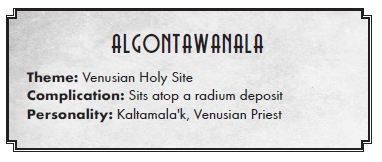
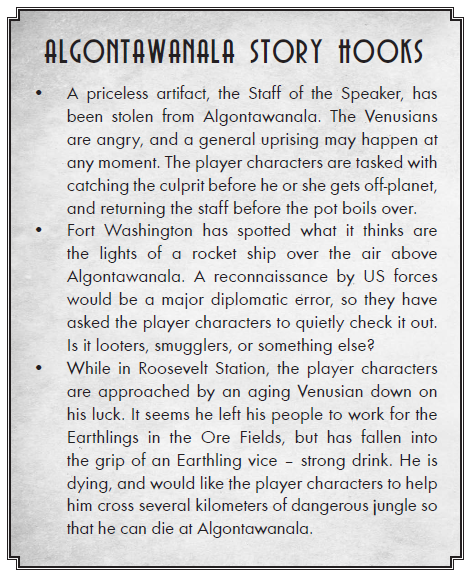
The Grand Crater is the result of an ancient meteor strike. Its depths are unknown, going far into the lowlands and with an odd curve to the impact that makes it look like the meteor bounced and rolled. This mystery is exacerbated by the fact that the crater is littered with ancient machines that don't match any known alien inventions. Any attempt to use them has killed the explorer or done nothing, but the place is considered to be a treasure trove of research. The Crater has its own issues, though. First, it's at least a month away from the civilization of the Ishtar Range and there's nowhere for aircraft to land. Second, it's held in awe by the Venusians. It's not as important to the Kind'alkakla, and they're not particularly happy with explorers and scientists poking around (though "not as important" is still pretty damn important). However, it's on the edge of the Kind'alkakla territory. The other tribes it neighbors, the Jill'yalla and Bwaht'analk, have no contact or relationship with humans and it's up in the air how they'll react to people trespassing.
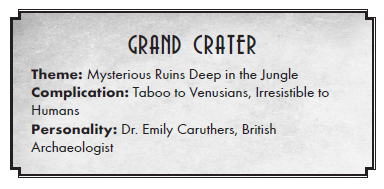
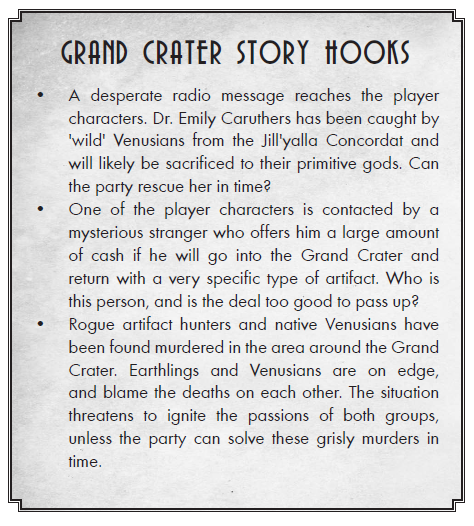
Fort Washington is home to the USA's 33rd Rocket Squadron and the "Flying Leather Heads", the 3rd Platoon of Company A of the First Rocket Rangers Battalion. Everything in Fort Washington is made of aluminum prefab huts with big fans; it sucks for heat but it's rust and corrosion resistant. Fort Washington is run by Captain Luther Running-Tree and his men and women are "misfits"; soldiers not 'fit to serve' or considered an embarrassment are shipped off to Fort Washington where Running-Tree and the other soldiers can get them into shape without worrying about army politics or bureaucracy. Fort Washington functions as the center for US, English and French expeditions and the soldiers are the closest thing to law enforcement the planet has. However, there's only so many of them. They do the absolute best they can to rescue people, repel creature attacks and deal with hostile Venusian Concordats. They're brave and heroic people, they just need some more soldiers. A lot more.
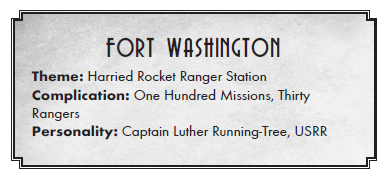
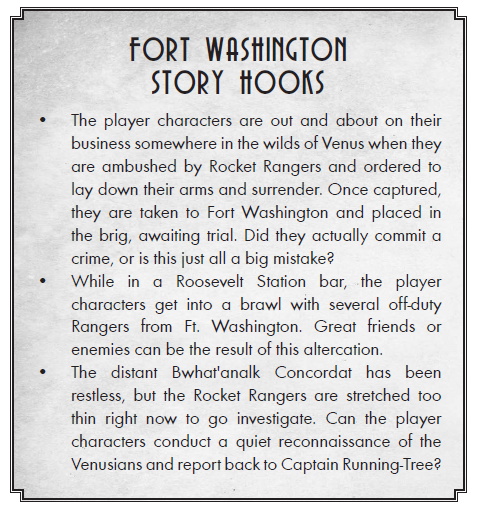
Roosevelt Station (named for Teddy) is the main port for rockets and travel on Venus. That sounds cool, but keep in mind this is the 1930s and on Venus. The landing pad is a dirt field with aluminum huts containing tools and personnel. Blossoming outwards from the pad is a shanty town of rotting houses, rotting tents and stone buildings. This is where the colonists of Venus live, divided by national lines into neighborhoods of Brazilian, British, French, German and American. There are even neighborhoods of Venusians who have fallen prey to the exotic drugs of alcohol and opium. Roosevelt Station is a frontier town, where people live and drink when they're not preparing for expeditions, weighing their finds or loading ore onto freighter ships. It's not nice and it doesn't help that the station itself is underfunded, underequipped and overworked. But they're all making do, working and surviving as best as they can.
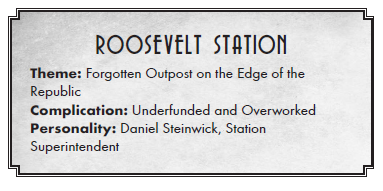
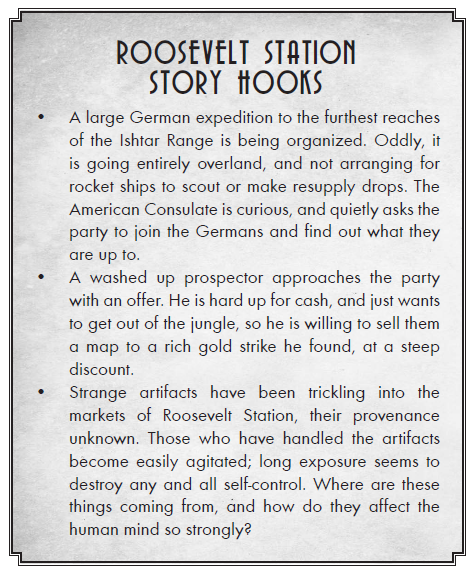
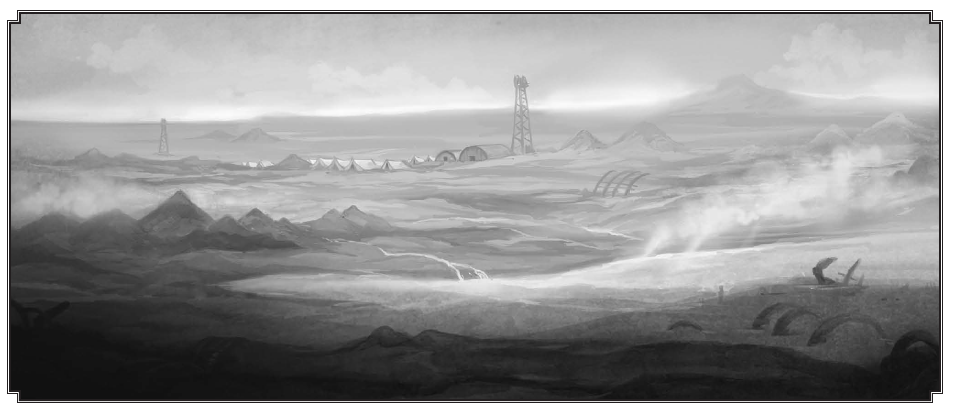
The Ore Fields.
The Ore Fields are where the people of Roosevelt Station don't want to end up. What was a couple of square kilos of lush, mineral-rich jungle have been turned into a muddy mining pit flanked by tent cities and factories. The pollution of the trucks, the smelters and chemicals make it rain constantly, dying the mud red, indigo, purple. Nobody claims the Ore Fields except the companies that hire miners to work for them and because it's not Earth...mining or labor regulations don't apply. Workers are seduced with the promise of a free trip to Venus, free lodging, free meals and medical care in exchange for work. In practice, the Ore Fields are a company town. The workers are paid in scrip and are in debt from their transportation and contract, the prices of all that held against them. As contract employees, they can't quit without paying their debt but their hauls are often undervalued. The only miners on Venus who make a profit are the wildcatters (who the corporations are gunning for). This isn't even mentioning the fact that the Venusians really aren't happy with how rampant industrialization is stripping the land of the Ore Fields.
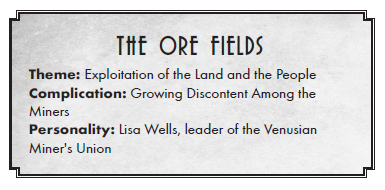
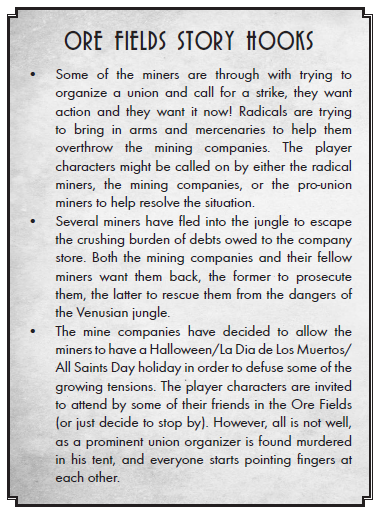
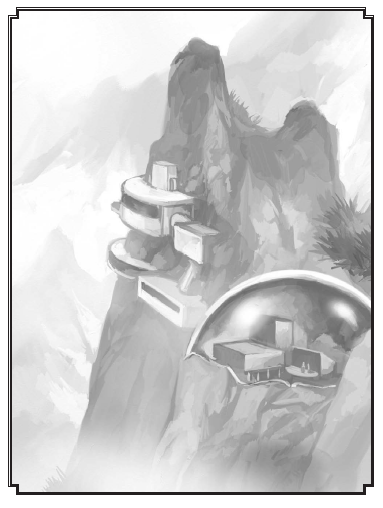
Livingstone Lodge.
Livingstone Lodge is probably the nicest place on Venus and that fact is often used to disparage the Lodge. Made of stone and wood, the Lodge is the premiere place for people to come and kill things on Venus. Run by the British, the Lodge offers the top meals from Venusian fruit and meat, hunts of the highlands and nature walks. It also offers bald-faced British Imperial racism. The entire place is like an African hunting lodge with bellhops and servants tending the guests' whims; the handful of Venusians on staff are mostly there to perform floor shows of their Concordat's dancing and rituals. It's a nice place, sure, but beneath the glamour and niceties, Venus is still a dangerous place and people don't like being taken advantage of.
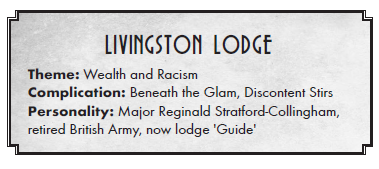
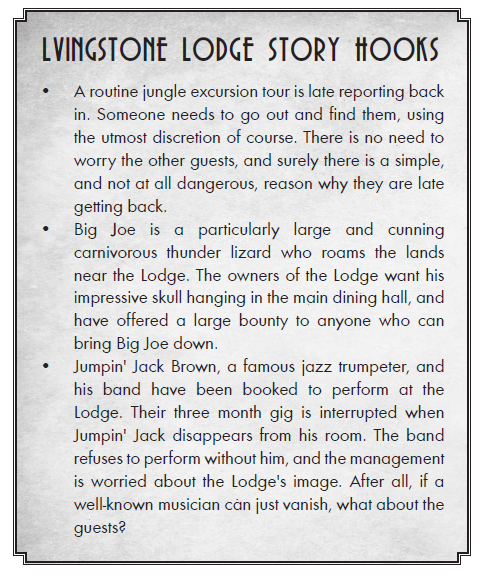
PERSONALITIES OF VENUS
Hambtruan is the High Speaker of the Kind'alkakla, a mighty warrior and leader of his people. On his sixtieth birthday, with his fur a gleaming silver, he cast aside the choice of leaving for one last Long Hunt or retiring to meditation in order to become High Speaker. On the day of his election on Algontawanala, the humans landed. Since then, Hambtruan has been the biggest proponent of letting the humans stay and treating them with respect, acting as a direct diplomat from his Concordat to nations of the world. This angers the warriors immensely but not the other Speakers, for they know Hambtruan's true plan. Once the Kind'alkakla have knowledge of mankind's secrets, strengths, weaknesses and technology, they plan to use our own technology against us and get us the fuck off of Venus for good. Not even the Soviets will be spared, and the secret alliance is actually playing right into Hambtruan's hands by getting his people the knowledge of the weapons man uses.
Kaltamala'k is a Venusian priest. Despite his withered and useless arm, he mastered the Thirty-Three Truths of the Venusian religion and proved himself to shrewd and intelligent. On the day of his coming of age, he impressed the elders by reciting the Thirty-Three Truths, the entire history of the Kind'alkakla and the Hashturik, a six-thousand line epic poem dedicated to their gods. He was elected to position of Speaker at the age of 19 and has remained Speaker since. Kaltamala'k originally supported Hambtruan's call to peace, but after watching how mankind treats itself and the environment he can barely stomach their presence anymore. He was the one who formed an alliance with Oleg Akhmerov of the USSR and found much in common with Communism and the Venusian way of life, and is now spreading the word that the time of waiting is drawing to a close; soon they rise and prevent mankind from taking Venus.
Luther Running-Tree is Lakota Sioux and left the reservation to fight in the Great War. He stayed with the army after the war and was later transferred into the Rocket Corps in 1934 of his own decision. Venus is a punishment to some, but he has the strong hand the Rocket Rangers need to be the best they can be on Venus. He's getting up in years but remaining sharp, guiding from his heart. He has empathy for the Venusians and realizes how complex the situation is, and hasn't been afraid to go against mankind or the USA to do what he feels is right. Luther is a good man, a reasonable man, and a good ally to have on Venus.
Daniel Steinwick was sent to Roosevelt Station to run it when the USRC couldn't actually prove he was stealing/misusing supplies on Edison Station, Mars. His help is bottom of the barrel, he is underfunded and he's expected to keep the station running. Despite all this, plus the harsh environment, Steinwick is succeeding. He's not afraid to get his hands dirty through theft or "accidental" misplacing of supplies and mixing that with ingenuity is getting the job done; it's making him feel good about himself, making him feel pride in his work for once.
Johnny Iacoli is a first generation American from immigrant parents who served on Mars with the Rocket Corps as a pilot. He was discharged and joined a French expedition and made gigantic profit exploring the South polar regions at the cost of making enemies with the native Martians. Now Johnny lives on Venus with his own rocket ship, acting as a pilot for hire for people who need someone reckless and daring.
Major Reginald Stratford-Collingham fought in India, France and Palestine. He's 63 year years old and still sees himself as a dashing young man. Before Venus, he turned what little money he had left from war/inheritance into big game hunting expeditions in Africa where he turned it into a business for himself. However, the Major was bad with money and leading expeditions grew boring until he was approached by the businessmen who built the Lodge to live there as a guide and fixture. Venus...is not good for him. In the year and a half since, he has rarely been sober, using quinine gin and tonic to control his malaria. The food and drinking has made him heavy, bloated, gouty and jaundiced. But hey, he's the real deal and that's still impressive to visitors.
Emily Caruthers graduated from Cambridge as an archaeologist and went to the Middle East, working alongside T.E. Lawrence and Gertrude Bell and playing second fiddle in their adventures. She managed to escape Egypt in the Great War with Lawrence's help (and a shepherd boy disguise) and kept working in the Middle East and China after the war. When Lawrence visited Venus, she came along again and became infatuated with the treasures of the Grand Crater. She's gone three times and has been planning for a fourth, but her willingness to violate the territory of the Kind'alkakla is something the US, England and France don't care for and has seen her deported from Venus or held in Fort Washington.
Lisa Wells lost her parents in the Ludlow Massacre in Colorado (real thing, look it up) when she was six. The Unions took her in, paid for her education and used her as a speaker for change. When they sent her to college (for philosophy), she was seduced by radical American Communists and helped them bomb and steal for the cause. She's on Venus under an alias to escape the FBI and is more or less trapped in the Ore Fields on her contract. That's fine with her, though. She's been hard at work organizing the miners and flying under the radar of the mine owners. She's also been preventing the few Soviet agents she's encountered from getting a foothold; Lisa Wells may be a Communist, but she doesn't trust the USSR's own brand.
THE MOON
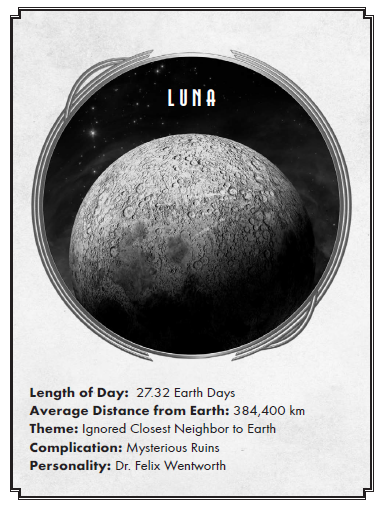
There's not much to the Moon besides the ruins. The native Lunans are all dead, leaving behind humanoid skeletons with strong back and shoulders, possible mounts for gliding membranes, elongated head crests, jaw/elbow/knee spikes, six-fingered hands with thumbs and three-toed feet with heel-thumbs. There's traces of water on the Moon and the air is so thin that you can't survive longer than twelve hours unprotected without health problems. There are roads but there's no writing, there are empty frames and glass surfaces mounted on poles but nothing more advanced that furniture and tools. What has been found are small metal cases with black glass and thumb-sized plastic sticks in colors and shapes. Theoretically they go together and require power, but any attempt at using them attached to a power source has made them short out or explode.
Doctor Felix Wentworth is a bit of a crackpot but he's still the leading British scientist in study of the Lunan ruins. He personally believes that the Lunans evolved from the dinosaurs and built rockets to flee to the Moon. His ties and connections make it easy for him to stay well funded and sabotage others, so despite his weird theories he has few critics and mostly just whiles away the hours studying the ruins.
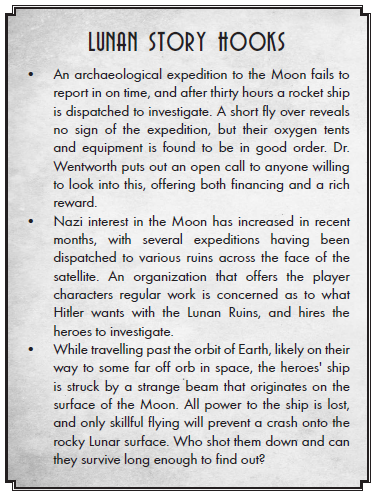
NEXT TIME: Mars, part one. There is a lot to Mars. A lot to Mars. This is gonna take a while.
MARS, PART ONE
Original SA post
MARS, PART ONE
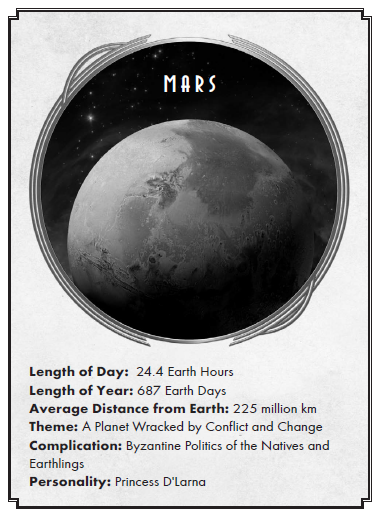
One would allege that Mars is not the kind of place to raise your kids, that it's far too cold for human life. The native Martians would beg to differ; it's an arid, dying planet but the tools the Ancients put in place help them survive. This part of the review will be split into two parts: Martian history, society and technology is part one and part two will be the effects of human presence.
Mars was originally cool and wet, teeming with plant life. The Ancient Martians had figured out how to safely harness atomic power and undertook a scientific revolution, creating a paradise for their people. The average Martian was functionally immortal (with immunity to disease) and relied on machines for water, food, service and entertainment. The exception was the Ancient scientists and engineers, a cadre of bright minds who wanted more than a perfect life and devoted their time to the upkeep of Mars' machines. So naturally after centuries of immortality, the Ancient Martians grew decadent, lazy and stodgy with fewer and fewer becoming scientists and artists. Two problems spelled doom for the Ancient Martians besides their decadence and laziness: they had hyper-efficient recycling but no new resources, and also there was the minor problem of the intelligent species of planet Eris invading to conquer them.
The Erisians were warriors and by the time the Ancients got around to figuring out what to do with them, they had already invaded Mars. Mars had not seen war for ten thousand years (save the occasional murder) and had no defenses, no weapons. The Erisians would have completely wiped out Mars if a group of top scientists didn't develop two planet-busting rockets. They stopped the invasion by blowing up Eris with one, which had some long-lasting effects. First, the destruction of Eris created the asteroid fields between Mars and Jupiter. Second, not all of the Erisians were killed. There were still some rockets in transit which fled across the solar system (or landed on Mars where they were destroyed). They also landed on Earth (where they failed to thrive) and Venus (hmm...). Third and most importantly, the act of blowing up a planet adjusted Mars' orbit and axis. Mars was starting to die, wracked by natural disasters, storms, earthquakes. By the time the Martians figured out a course of action, it was too late.
The main transportation across Mars was destroyed, most of their advanced technology networks were interrupted or broken and the planet was turning to desert. The Ancients had to work and struggle for the first time or die. The nations of Mars were cut off except for radio networks, and that's how the Ancient Martian scientists came up with plans to save Mars. First was stratifying people by what they could do (the caste system), second was to dig the canals of Mars to let the ice caps melt and bring water like an artificial stream. Both ended up working (around 9000 years ago) but it didn't fix Mars or bring back the green. What actually happened was that every Martian city state was unable to think above their local needs, creating pockets of civilization in the red deserts. The Ancients also used their genetic engineering tech to create the Warriors and Laborers and diversify the other castes so they can't interbreed.
At the end of it, a religious movement of ancestor worship began where the Ancients were exalted for building the canals and saving Mars with a focus on building up perfection and unity to get to heaven. The entire thing was promptly hijacked by early Princes and Nobles, claiming that they were descended directly from the Ancients.
Modern Mars is...stagnant. The machines don't work like they should anymore, the planet is still slowly circling the drain and life is rigid and stratified. The arrival of mankind is the best and worst thing to happen to Mars in two thousand years.
Life on Mars
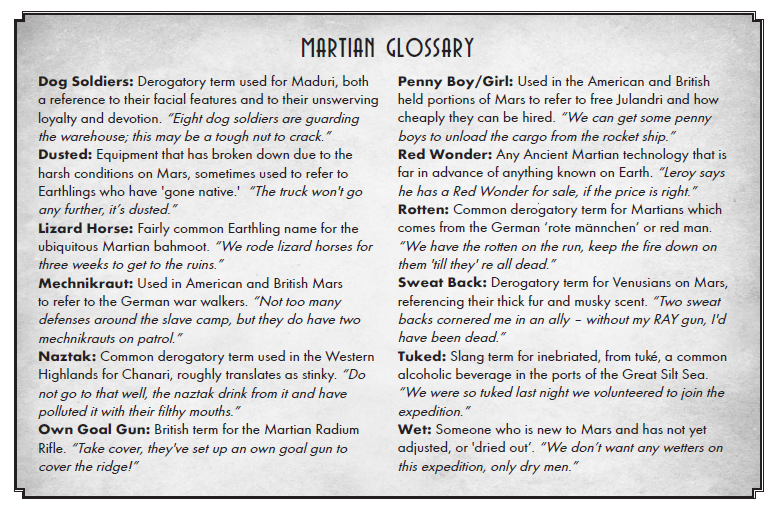
Martian cities are principalities under control of the Nobles, the Priesthood or an Earthling power. There's a couple hundred principalities that range from small areas to big sweeping swathes. Principalities under Martian control have the Prince/Princess/whatever title the Noble feels like using on top (never king or queen because they're servants of the Ancestors, a bit like how Kim Il Sung is still the actual ruler of North Korea). Below them is the Grand Vizier, followed by the head of each Caste, the Masters (of Slaves, Crafts, etc). Underneath the Masters are the lesser Nobles who act like bureaucrats and daily managers of the principality, the Priests and the Warrior castes. Under that is everyone else: the Laborers, the Craftsmen, the Merchants. The Prince/Princess owns everything in the principality and Martian economics works trickle-down style, distributing things by Caste strength to meet quotas. A lot of this info or requirements are outdated and corruption/bribery is the best way to fix that. These black market deals and bribes are managed by the lesser Nobles with the implicit acceptance of such by the Prince. If you want to trade with another principality, you need a Merchant.
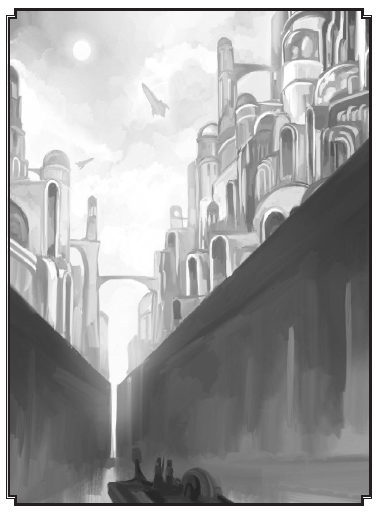
Earth has introduced more economic systems to Mars. Soviet colonies are a bit like Martian principalities, where one group owns the means of production and distributes by census data. It's an easy pill to swallow for Martians because Soviet economics means that they don't give a shit about the Castes. America has brought free market capitalism to Mars, which is generally baffling to Martians except for the ones who run black market deals and understand barter. It's a mostly good system (especially for the Laborers and Craftsmen) but poverty is starting to develop on Mars (especially for Laborers and Craftsmen). Finally, there's Fascist economics brought by the Nazis and Italy, which is very simple: strip Mars for everything of worth to Earth then do it again, the lives of the Martians are a secondary concern as is their survival.
Want to get around Mars? Walk. You can also ride a Bahmoot (aka the "Lizard Horse"), ride a cart pulled by a Bahmoot or ride a canal boat/barge. Rickshaws pulled by Laborers are also entering popular use. Some principalities still have running transit which take the form of electronic mag-lev trains used to carry people and cargo. On the Earth side of things, our technology has a big limitation: there's no oil on Mars, not a drop. Cars are impractical because oil needs to be shipped to Mars from Earth and while this is done, the price is ridiculous. Mars does have radium, though, and since radium powers rockets it's used for rocket sleds, rocket cars and more.
Martian communications consists of either paying a messenger to memorize and marathon or carry a letter for you. As a result, Martians have trouble spreading news around but communications festivals and rituals are common. This has also had the effect of making some principalities ignorant of the presence of Earthlings. Ancient technology is also used (mostly by Nobles) and comes in the forms of a microwave transmitter that beams info and energy to towers and receivers, beam transmissions that carry information, or a jury-rigged microwave transmitter turned into a switchboard phone system. The Laborer Caste powers pretty much everything where Ancient technology has broken down, literally powering infrastructure with hand cranks, bicycle generators or treadmills. Laborers are required to maintain the Martian standard of life: running water, unclogged sewers (waste and sand, mostly), a few hours of electricity a day.
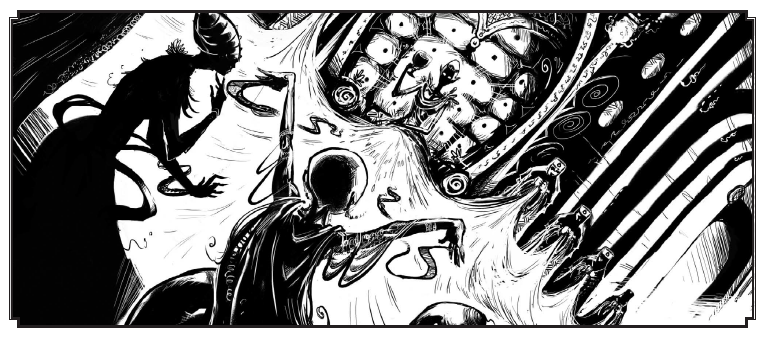
Arts and entertainment on Mars is a business in itself. Craftsmen may not need to make their items so instead they may be told to decorate what they've made. They're used to paint, etch, sculpt and much of a Martian principality is just covered by all kinds of hand-made art. The greatest kind of art is the sand painting, with cleaned sand dyed and laid grain by grain (sometimes wetted) to create paintings or 3D sculptures that will one day blow away. Every Prince is required to have at least one they've managed to preserve. As for other art, music and dance is divided by Caste lines. What this means is that most Castes don't see or appreciate another's display with some exceptions: Nobles and Merchants don't have any artistic traditions but appreciate watching the Priest Caste's rituals, and everyone likes watching a Courtesan's dancing or harp-lute playing.
- Craftsmen don't dance but they sing and they play percussion. When working, the songs are nonsense vocalizations and percussion, all of it freeform. When at home, they sing songs of home life, of food and love and family. Craftsmen enjoy jazz and identify a lot with it and in free states their home songs are used to hide rebellious messages.
- Laborers chant/sing to coordinate their efforts and drown out the boring nature of their work. When off duty or celebrating, they stick to ritual dances and happy chants.
- Warriors drill when they dance, they sing to march and coordinate. Dance is an important part of exercise and practice and it's not uncommon for cavalry riders to dance with their mounts. They also divide their songs and dances by gender.
- Priests have religious hymns and choir songs for public. In private, there are forbidden/heretical songs they sing in whispers to give themselves breaks from being devoted to religion, these hidden songs wrapped up in metaphor and innuendo.
- Wild Martians (the Chanari) do whatever they want, but they perform an art that no other Martian castes have: drama and plays. Chanari plays are generally one-person shows with pantomime and second person narration.
Food on Mars is a lot like food in Alpha Complex. The lower castes eat spiced bread and spiced porridge (or reconstituted food product dispensed by Ancient food machines). The higher castes get fruit, veggies and meat. A lot of Priest sub-castes are vegetarian and Warriors get the best food always because they need fuel and nutrients. Healthcare and education aren't much better. Education is generally taught by other members of your Caste or teacher, and healthcare ranges from Ancient auto-docs to black market medicine to Earth-style care to superstition and guessing.
War is probably the greatest ritual Mars engages in. I'm not talking about coups, which happen. Martian war is a multi-step process that begins with a formal declaration of hostilities along with open goals for all parties and what they wager if they lose, negotiated by each principality's merchants.
- While each principality holds symbolic parades of their Warriors, Merchants are dispatch to the courts of the other participants with a jar of water and a jar of sand. If they can successfully negotiate out of a war or conflict, the Prince will accept the jar of sand as a symbolic gift. If they can't, the jar of water is poured out onto the ground in public.
- When the Merchants return home and war is certain, more Merchants will be dispatched to each Prince's court for a ritual of insults and hostage taking. Hostages should defend themselves or be taken by force but if any Priest or Noble blood is spilled, the war gets worse from that faux pas.
- If that goes off successfully, each side picks a symbolic base/canal/hill/etc. (not too far away from each other) to defend. The point of the war is simple: if you lose your point of defense, you have lost the war. Kills don't matter, only giving the victors what they're owed.
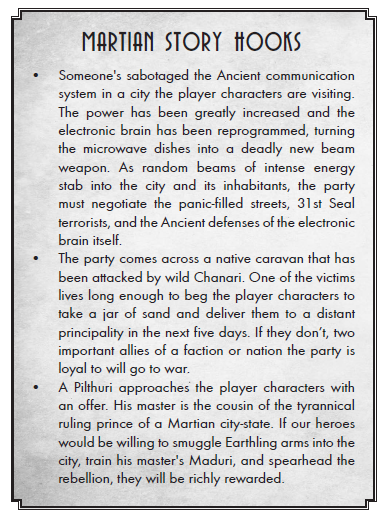
Wild Mars
Outside of the principalities, Mars is home to the Chanari and whatever wild species have managed to make a home for themselves. The land isn't empty, just sparse, and the biggest danger is the lack of regular food and water. More enterprising explorers focus on open Mars because they have to worry less about politics. As a whole, the planet has five different types of ecosystems.
Silt Seas are what happened when sand gets into the dry oceans and rivers of Mars after the destruction of Eris. A thick, fine layer of silt floats above dry beds and dirt kicked up from nature, creating something not as buoyant as water but something you definitely can't swim in. Crossing the silt seas requires a special ship that is made of wood and goes fast enough to skip. Because wood is so precious on Mars, the Chanari make a living salvaging old ships and it's considered an unspeakable crime to destroy a ship when you can just board one. The other way to get around over the silt seas is to use ancient highways built by thousands of years ago. They're crumbling, they're not all connected and they're really high off the ground but they're a safe way to haul cargo.
Deep Desert is your standard Martian desert, a sun-baked land of rock and sand. Anything living in the desert is often dangerous to approach, especially Chanari that have managed to survive there. The safest way to avoid sunstroke, dehydration, starvation and sand storms is to stick to old trade routes and possibly hire a Chanari caravan guide (who might turn on you).
Salt Plains are what remains of old oceans that didn't fill with silt and dirt. There's less salt plains than silt seas but their rarity brings better access to Ancient ruins. Most of the water just evaporated and left behind old towns and structured abandoned along the dried coasts, but there are still some machines damaged by salt and time. Your average Martian considers the salt plains to be cursed and forbidden, old graveyards that should not be disturbed.
Arid Highlands are the most forgiving places of Mars. They're dry but it rains, they're hot but there's shade from the trees. The highlands are home to most of Mars' flora and fauna and most Chanari live there too as herdsmen and forresters. Some of the highlands are too high and are inhospitable from thin air while others are in a sweet spot of being high enough to get the most water.
Dead Canal Valleys are artificial environments made by principalities abandoned when the water dried up, the machines stopped working or whatever reason. Chanari tribesmen make their homes in the canals and so do a good deal of animals, able to eke out a living or maybe finding a way to draw a reliable source of water. Renegade city Martians can also be found living there, escaping their homes or banished. The canal valleys are also a good place to explore and scavenge.
What is life like for a Chanari tribesman? Whatever they want it to be, but mostly focused on survival. They tell stories, they scavenge, they hunt, they dance and sing. They rarely think about the castes and principality life of Mars except when people pass through their territory. They live a Bronze Age/nomadic life and the presence of humans hasn't done much to change it (besides giving them access to guns).
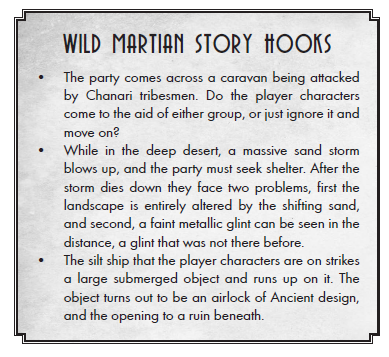
NEXT TIME: Human Occupation of Mars. Spoilers: we really could be doing a better job of it.
MARS PART TWO
Original SA post
MARS PART TWO
American Martian City States: America didn't really intend to conquer parts of Mars like the other players on the field. The original plan was to have trade agreements and diplomacy; some of the principalities they were allied with allowed them to have military bases or US government bases as a sign of goodwill. America ended up conquering when the Prince of Mircanok had every human captured and decapitated with their heads returned to the US as a sign that they would not be willing to tolerate a human presence. In response, General McArthur had US troops perform maneuvers near the Mircanok border. The Prince did the same and Martian forces ended up firing on Rocket Rangers performing scouting by the border, which lead to America conquering Mircanok in three weeks because McArthur wanted a fight and didn't want to wait for orders. A collection of Martian troops responded in kind and attacked Mircanok but American troops were bolstered by friendly Martians and British Colonial Marines. In the long run, America's hold on Mircanok stuck and General Patton relocated to Mars to help with defense. America's holdings have been growing with the same pattern; a principality attacks, America responds with overwhelming defensive force and takes their land then expands the trench defenses that border their land (McArthur is a big fan of emulating WWI trench warfare). The conquest boosts America's economy back home and gives them "fair" access to Martian technology and goods. The governmental/state departments aren't happy with it, though. They believe we're doing too much too soon to the Martians (who are having trouble adapting to democracy and free-market capitalism) and it also doesn't help that President FDR really isn't too on board with it either.
US Principalities
- Haviling was a small city state that lost most of its Warriors attacking the trench borders and skirmishes with American forces. The Prince, Prince Ghilascat, immediately surrendered when he had the chance. The US has allowed him to remain in power and Haviling is pretty peaceful, being inconsequential to American interests and away from the frontlines. Instead, the State Department has been more interested in Haviling, performing tests on the Martian civilians and using them for American interests. Now the fields of Haviling grow ethanol corn for the US' Martian vehicles, the Craftsmen are making goods for an American market and ore/minerals are being mined to be shipped to Earth in exchange for money from the government, private companies and assistance from doctors, technicians and researchers. It's doing well for itself, though society has been altered.
- Kostrast took advantage of the American/Mircanok war to steal up as much free land as they could to make the principality grow. Prince Tyriolik is firmly pro-America and has let Earthlings join his courts, explore his new lands and tinker with ancient Martian technology. Our arrival was the best thing that could have happened to him; he got to steal the land of his enemies and he's rich beyond his wildest dreams now. As a result, Kostrast is one of the top places for American interests to visit.
- L'Tang is the latest principality to be taken over. As a result, the military and state department are fighting over control. As a result, FDR has turned L'Tang into a test for an American Martian Administration; everything is now run by a committee of three state department diplomats, three staff officers and three Noble Martians (who can't actually vote). Nothing actually gets done or decided as a result, and the only reason the principality functions at all is because Martians without orders will just act according to tradition and because Americans will ignore orders if they feel like it.
- Mircanok has been reduced to just the city of Mir. Mir is the seat of American Martian government and General McArthur is its governor. Since he's a Martiaboo in this universe instead of being infatuated with Japan, let's pretend he likes to wear traditional Martian cloth robes while he rules. The army rules the city, but the Martians consider McArthur to be their new Prince, and things are relatively comfortable and stable. The Army Corp of Engineers has been hard at work replacing/repairing Ancient Martian technology.
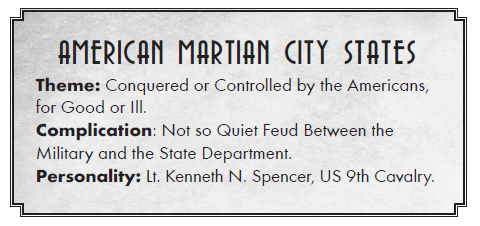

French Mars: France controls its Martian interests the same way it approaches Indochina, North Africa and its other interests. Diplomats and businessmen in employ of France do most of the work slowly squeezing its principalities dry the French way: promise military protection and trade Martian tech/treasure for our tech and knowledge. There's a single garrison of soldiers and unfortunately for France, its interests are very close to the territories Italy, Germany and the USSR control. They lack any power for an excursion beyond "defeat Martians" and if things get too hot, they'll be at a substantial disadvantage.
Kolpith was taken in the only display of French military power on Mars. Consisting of four cities in well-defended mountains, Kolpith had an intense dislike of the principality of Harkanith. The next time Kolpith's forces left the mountains to fight Harkanith, they were attacked by the French (who made a deal with Harkanith's prince for help. In the long run, Kolpith ended up solely under French rule (Harkanith's prince didn't really care about governing it, only defeating it) with Charles De Gaulle acting as military governor. Kolpith is doing well, blending French diplomacy and Martian bureaucracy to turn a profit.[/list]
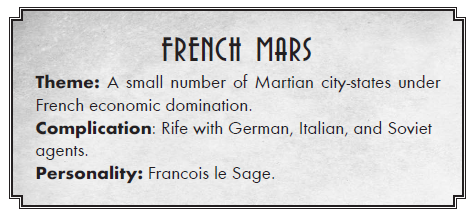
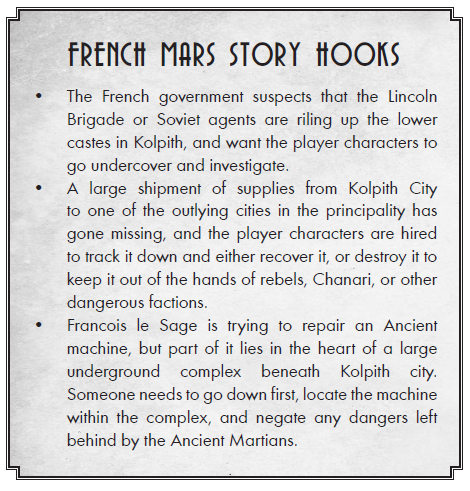
His Britannic Majesty's Martian Dominions: Britain is no stranger to what they're doing and they've made it abundantly clear that Mars is India II: Electric Boogaloo; it doesn't help that Britain is getting bored with the constant troubles with their other colonies. Britain controls 29 principalities, 9 of them directly with the rest as allies. They're controlled with military and politics but the big killer is economic control by enslaving the principalities to the British economy and putting them into debt through loans from the Crown. It really doesn't help that the Princes in debt to Britain have a habit of blowing the loan money on fancy Earth cars and planes and other neat Earth things.
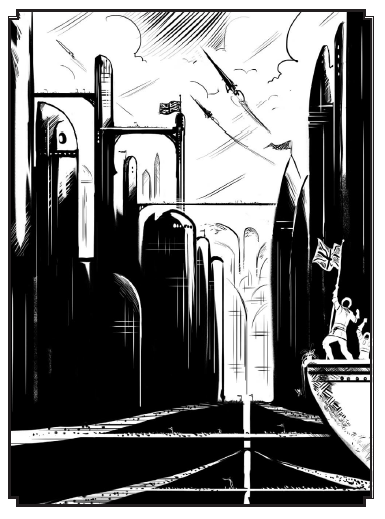
British Mars.
- Fathire is a good example of this debt. Fathire is rich in copper, gold and iron but it also has an Ancient machine that recycles ore and scrap into usable metal. The price of keeping the machine running and repaired made Prince Fathin CVI turn to borrowing money to pay a repair crew, but he kept taking out more loans and misusing the money for his own means. Now Fathire does whatever Britain wants, and what Britain wants is ore turned into ingots.
- Opalar was a principality nestled in the obsidian mountains of an old volcanic range. In spite of the natural defenses, the principality was taken over by the British army using artillery and bombers. Opalar would like to rebel but isn't really feeling it; not much has changed besides that their Prince lives on Earth and never visits because Britain wants Opalar just to have it, not to rule it.
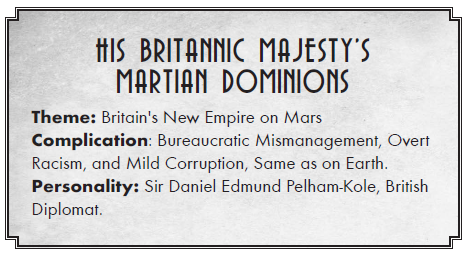
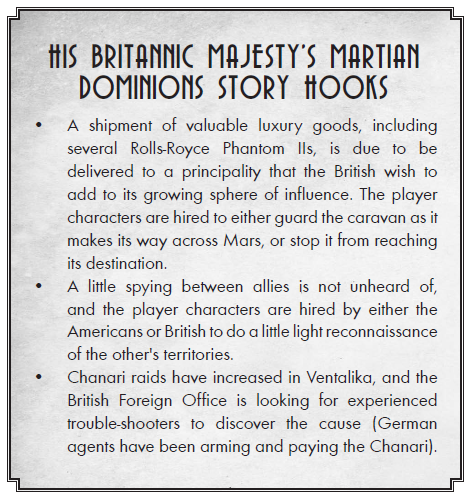
The Soviet Client States: The three Martian principalities of the G'Hascar Triangle (Sutinu, Taretnia and Uvalon) were infiltrated by Soviet agents spreading Communism. This resulted in the Warrior castes of all three principalities taking to the streets to force change by executing the Priests and Nobles. The combined military might of three principalities almost wasn't enough, but the Interplanetary Comintern of the USSR joined them in overthrowing their masters and establishing a base on Mars for Russia. Considering how the rebellion went down and how comfy the Russians have made themselves, they're not going anywhere soon.
Uvalon is allegedly the worker's paradise of Mars. Sure, the castes exist socially though they've been formally abolished. Sure, Soviet advisors dominate the collectives that answer to the Central Collective but they're supposed to be temporary. Sure, the USSR has basically just replaced the Noble caste but look how stable we are compared to those other principalities with humans. Nikita Khrushchev is the Chairman of Uvalon and he's interested in keeping everything stable, calm and productive if the facade of success ever wears off.
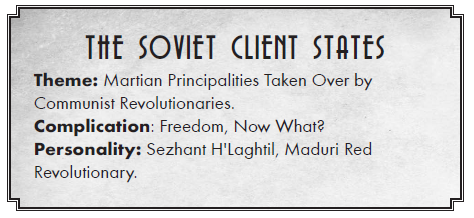
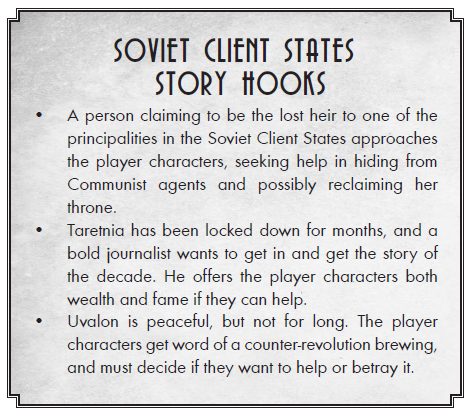
Italian Mars: Italian Mars controls three principalities and is right next to Germany's land. It really only owns them because of Germany's help getting to Mars. Italy is openly looting their principalities (not very well) and enslaving the native Martians. Frankly, Italian Mars is a lot like North Korea, carrying on and showing off what they're doing while Mussolini begs Hitler for assistance in putting down another revolt.
Nuova Roma was the principality of Jailkarv until the Italian army killed 70% of the population. The Priest, Noble and Warrior castes were completely killed while the others were kept in camps as the Italians looted/burned Jailkarv for a straight month. The principality is now known as Nuova Roma; the Martian art was destroyed/sold and replaced with pro-fascist art, the streets were renamed, the fields are worked by Martian slaves and the temples were destroyed and replaced with Catholic churches. It's essentially a crime to be Martian in Nuova Roma. The money in Nuova Roma stems from cheap factory-made Martian crafts, agriculture and tourism.
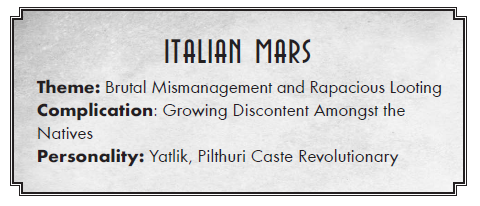
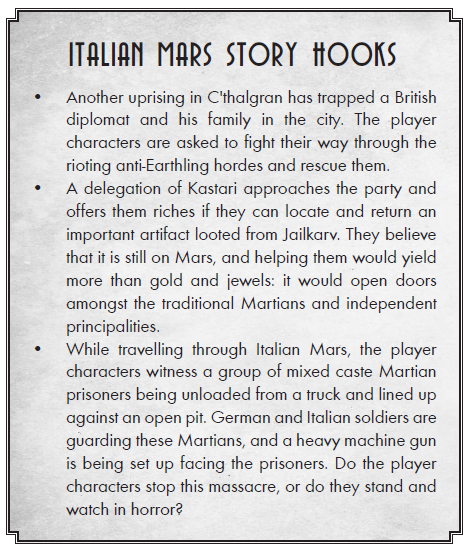
Nazi Occupied Mars: Originally, Germany was cut-off from the space race due to the Treaty of Versailles. When the other great powers re-evaluated the Treaty and allowed Germany to build rockets for scientific or exploration purposes, the Nazis quickly embarked on the scientific project of exploring Mars by taking it over. In an attempt to avert another World War (rimshot), the great powers let Hitler get away with it. Now Germany owns 39 principalities and is hungry for more, growing rich with bald-faced plunder of treasure and technology. Of all countries on Mars, Germany's exploration of Ancient technology has resulted in the most change. Nazi Mars has the Deutsche Marskorps, an army of soldiers utilizing the War Walkers (bipedal assault mechs that run on water) and are greedily ferrying technology back to Mercury for R&D. This isn't even mentioning that Nazis don't view Martians as sapient beings, openly executing them if they're not working them to death.
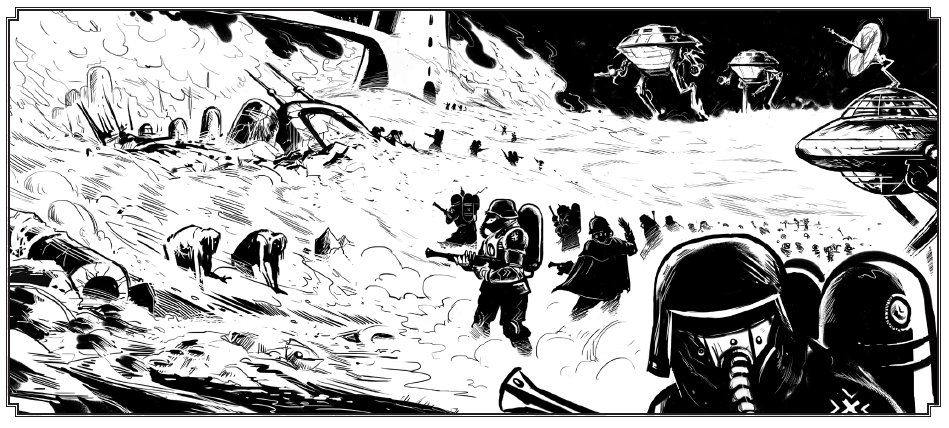
Deutsche Marskorps on the move.
Neu-Berlin is the capital of Nazi Mars, a sprawling production city of factories, farms, slave labor and weapon production. The Martians are kept as house slaves or used to do dangerous/manual/agricultural work, the Germans work the factories and the governmental offices. It's a lean, clean Nazi machine and it only grows stronger with every inch of Martian land taken.
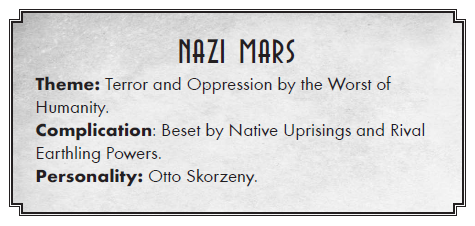
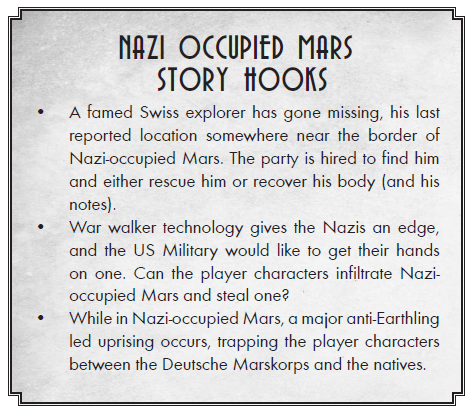
The Freebooter States: The Freebooter States are six scattered Martian principalities who have been overthrown or changed but not by a specific country.
- Emancipation was an attempt to teach the Martians democracy by American freebooters called the Abraham Lincoln Brigade. Formerly Yatharith, Emancipation was ruled by a dangerously inbred cult of Nobles whose Prince was the Martian Caligula. It was overthrown after a campaign of infiltration and revolution and renamed. A lot of Emancipation is better than it was (running water, electricity, banished caste system) but a blight has affected the crops and the elected government (of actual Martians) can't do much to stop the Priests that secretly preach doom of defying Mars' order and the displaced higher castes who don't want to take orders from people lesser than them.
- Herscal had a military that amounted to the palace guards and the Prince was more than happy to hire the Sons of Sol to help protect the principality. After about a month of service, the Sons took all of the Nobles hostage and made themselves rulers, spending two months drinking, partying, murdering and looting while Herscal's people watched. This lasted until a wandering Venusian named Ophali'kilf passed through and challenged the Sons to a duel and killed them all. The Priests "conveniently" found an old prophecy that foretold of a hairy prince and the people of Herscal have elected Ophali'kilf to the position of Prince. He means well, generally, but Venusians have no concept of monarchy and the way he treats his people (nicely) is seen as bizarre to them.
- New Jerusalem (formerly Sacaranon) was an attempt to rule a principality with a Martian-Earthling religious cult that resulted in religious violence and anarchy.
- J'lkarinie is ruled by a human swordsman who legitimately challenged the Prince in single combat, won and became the new Prince. He mostly does whatever and lets everything go on the way it previously did.
- Polintal has a Princess who married the Freebooter who saved her principality and they rule together quite happily with full blessings of their people.
- Sagran is ruled by a displaced Princess who decided "screw it, I'm gonna be a pirate" and fought her way into the palace through bloody war.
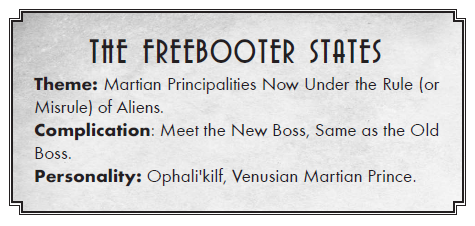
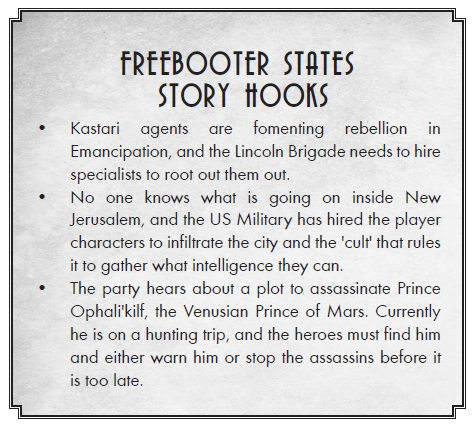
The Camps of the Warlords: The Warlords are west of Soviet lands and consist of Warriors who abandoned the Revolution rather than be beholden to Communism and the Soviets. The camps are made up of Warriors, Craftsmen, Merchants and Slaves who thought it would be better to live like the Chanari. The camps have only been growing, bolstered by runaway slaves, Chanari and dissenters from other principalities. The Warlords are:
- Tal-Matuth, who joined the revolution to get rich then promptly turned on the Soviets and fled to the deserts with his men where they enslaved a tribe of Chanari. Their warrior tribe is an active hindrance to the Soviet occupation and he enjoys looting, pillaging and marauding but has gotten away with it for now; there might be another country backing him to get at the Soviets.
- Jisiliasc, whose men killed their Soviet allies before the principalities were taken and declared him to be the High Prince of Mars. Jisiliasc ultimately does want to rule all of Mars, so for now he and his soldiers are covertly asking the other nations for help. They're well equipped with weapons (and they even have airplanes) but are waiting, gathering power until the right moment to strike at Soviet Mars.
- Hyscanthock, a corporal who rescued captive Priests from execution and fled to the western Highlands with them to help keep the Martian religion alive in the region.
- Laskat, who refused to rebel and instead looted Uvalon's stocks and armories before fleeing across the Great Silt Sea on silt skimmers to start his own pirate band.
- The survivors of a military junta who refused to give a city to the Soviets and became a roaming band of raiders when they lost the city after three months.
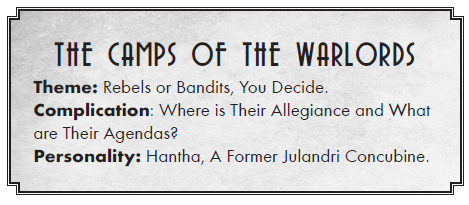
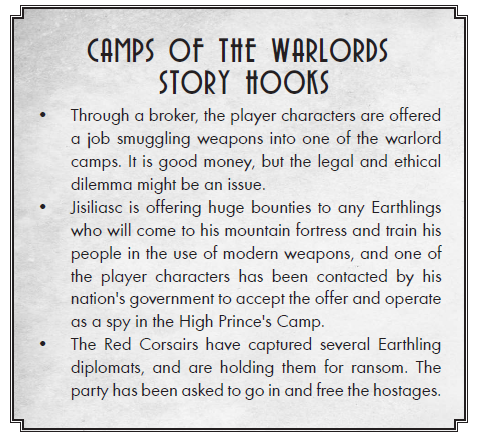
Ancient Mars: Ancient Mars consists of everywhere not colonized but full of Ancient ruins. Not much is known about the Ancient language, but that doesn't stop explorers from poking around ruins or old principalities to see what they can dig up. There are five big known sites, the biggest of which is Jastariv.
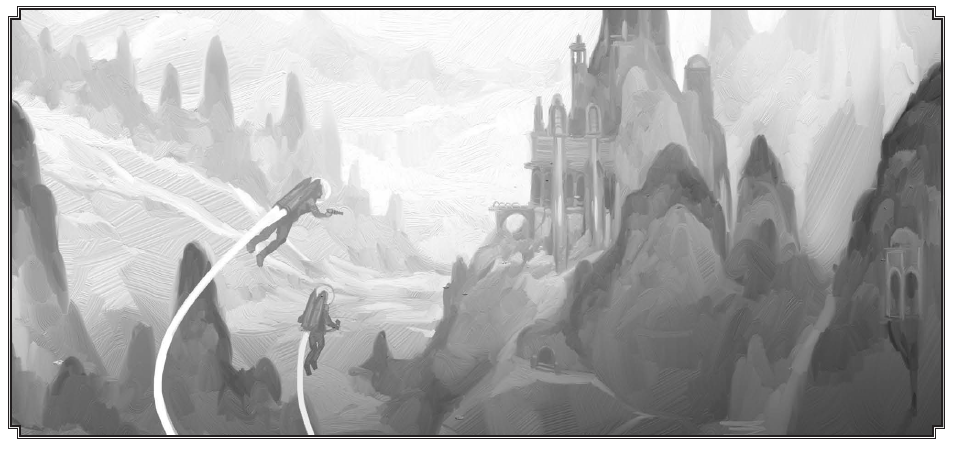
The outskirts of Jastariv.
Jastariv is where Tesla found plans for the RAY guns and other tools. Jastariv is where Hitler's scientists discovered plans for the War Walkers. These discoveries have made the ruins of Jastariv the focal point of most of Mars' archaeological efforts, the city surrounded by a sea of tents. Since nobody claims the city, there's no real law but there's a sense of it. America has two outposts (one State, one Army), Nazis and Soviet explorers often violate the peace of the city and other nations scramble for a stake. The unaffiliated archaeologists run the spectrum of "actually trained" to "looter" with many countries paying them to sabotage other jobs or bring back a claim's bounty.
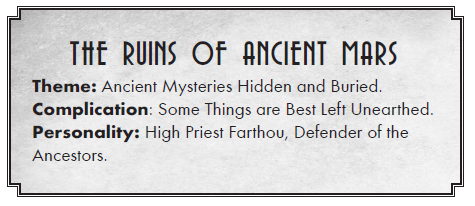
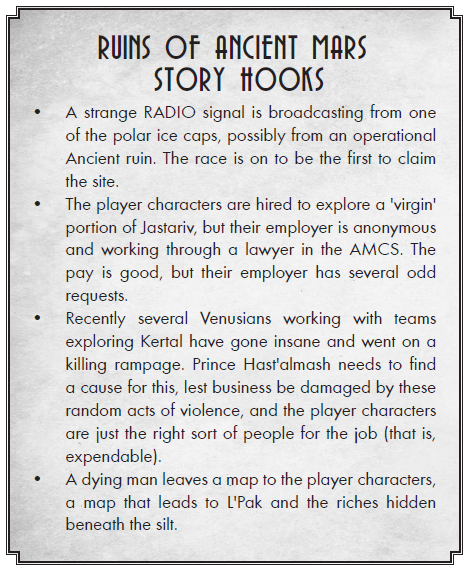
Independent Mars: There are principalities that have never seen a human or don't know anything about what's been going on in other principalities. Mars, for the most part, abides and just keeps on doing its own thing. G'Pak is the sample principality of Independent Mars, an oasis in the middle of the Great Silt Sea. Because everything needs to be imported and it's one of the few safe places to stop when traveling, the true power of G'Pak lies in the populous Merchant caste's ability to run everything and get everything. It's the Martian equivalent of Hong Kong; you can get anything you need for a small tariff and you can sell anything.
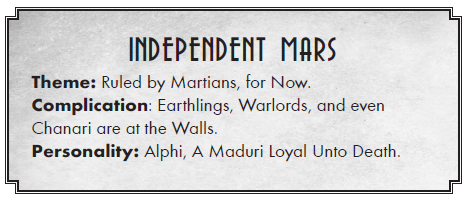
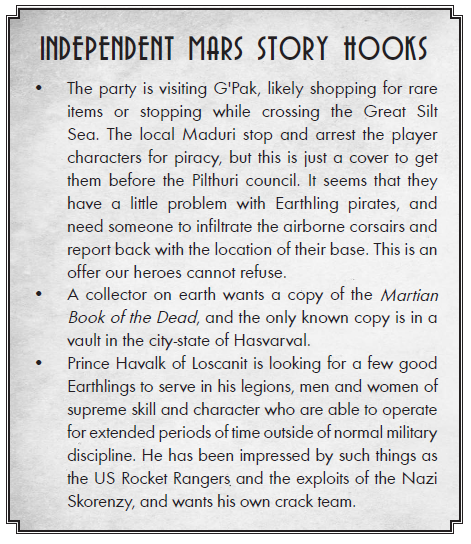
PERSONALITIES OF MARS
Princess D'Larna came to power the same year Einstein, Tesla and Armstrong arrived to her principality of U'Lavik. She became the public face of Mars and many admirers and diplomats came to beg her favor. But she was unsure who to trust or if the humans were trustworthy and had a ship built to take her to Earth, becoming the only Princess/Noble to ever visit Earth. When she traveled the Earth, she was accepted into every capitol and came to a conclusion about us. We were creative, we were inventive and honorable as much as we were bigoted, greedy, chaotic and violent. D'Larna returned to her home and banished all Earthlings from her court except for the ones she felt exemplified the human spirit's greatness. She's not planning for a war; she's planning for whichever nation casts eyes on her land, making sure it's technologically and socially prepared with the help of her human advisors.
High Priest Farthou is sick and tired of Earthling exploitation of Ancient technology. Using his ties in the Sacred Order of the Hamaxe and the help of the lower castes, he has started a resistance movement consisting of guerilla warbands. Small archeological expeditions can be attacked and killed while bigger ones should be sabotaged or rigged or have accidents/incidents blamed on the Chanari. Not everyone supports him, but he has his followers.
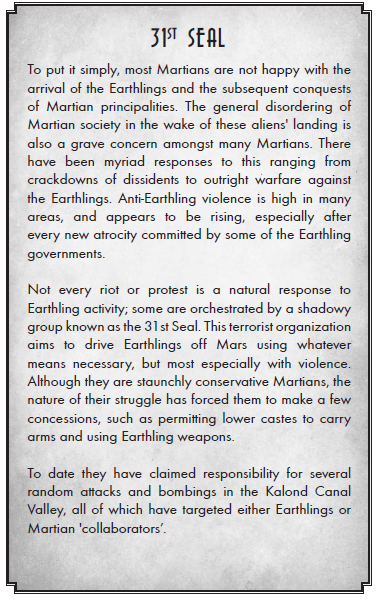
Not related to Farthou but relevant to Martian resistance.
Alphi was a Warrior palace guard who managed to escape a Freebooter revolution-turned-Noble coup. He was tasked with guarding the heir apparent to the throne, a six-month-old Noble girl. He brought her with him and almost lost his life to another group of Freebooters but was saved by her cries and their mercy. They have since pledged loyalty to the baby Princess and are helping Alphi prepare for a war to retake the throne of Tasmanip but they need more manpower.
Hantha was the courtesan to a cruel, violent Prince who let Tal-Matuth into the palace as part of the Soviet's coup. She's the brains to Tal-Matuth's Warrior might, her courtesan training giving her diplomatic skills. As such, she's the one that actually runs the Warlord's camp and juggles the factions. She can't do this forever, though. All things fall.
Yatlik was a Merchant who lived for the days of traveling the open sands of Mars. Now he's a slave under Italian oppression, forced to give up everything he knows for menial toil (and worship of Catholicism, which is amusingly referred to as "The Three-Pronged Ancestor God and his Living Prince on Earth"). He's completely on board with revolution in Nuova Roma but he also realizes that if they're not careful, the next revolution will fail. As such, he's taken it upon himself to mastermind the next one and is slowly spinning a web of intrigue.
Sezhant H'Laghtil was disillusioned with the state of the Warrior caste, wanting to rise higher than his current rank. He turned to Communism when he had the chance, eager to join the other Warriors replace the Nobles that ruled them, but his promotion never came. The political officer he talks to says he's not ideologically pure enough; perhaps if he can turn these Craftsmen, Slaves and Merchants into soldiers, he might be able to prove his loyalty.
Opali'kilf treats his Martian subjects the way he'd want to be treated. He's polite, he considers their opinions regardless of caste, he treats them like equals. But they won't change for him, not really. He hates the ceremony of the whole thing, he hates that he feels like they treat him like a child, a figurehead. His only respite from being Prince is his hunting trips. His trips are taking longer, though, and there's whispers of unrest.
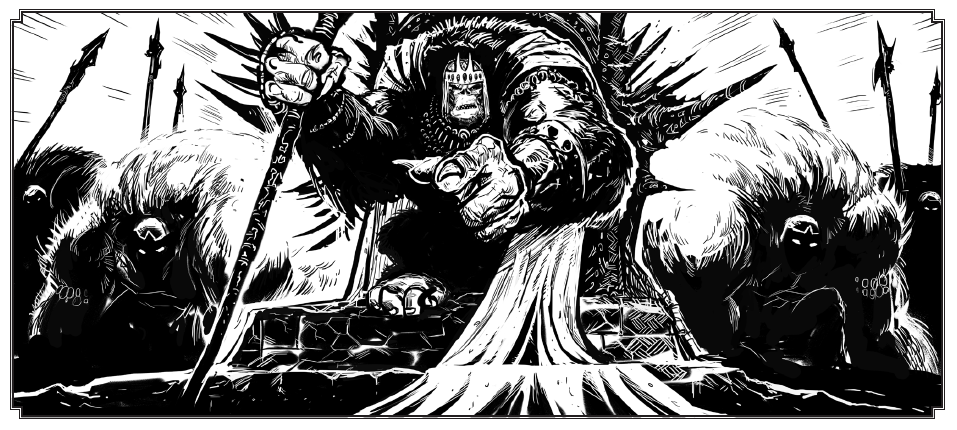
Opali'kif, Venusian Prince of Mars.
Lt. Kenneth Spencer is a white officer of the black Buffalo Soldiers cavalry (yup, it's the 30s) and went to Mars with his men when Patton relocated them. At least he comes from a lineage of abolitionists. He's been with Patton and McArthur for the long haul: fighting in campaigns against attackers, helping stop rebellions, clandestine operations. He's a typical cowboy cavalryman with a saber, ivory-handled RAY gun pistols and a horse on Martian soil.
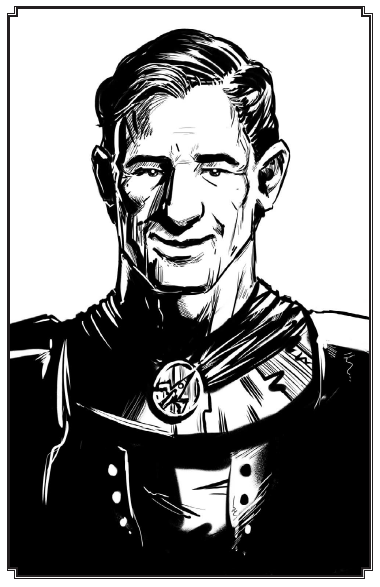
Lt. Spencer.
Francois le Sage is a genius when it comes to Ancient technology but will only work where France allows him to. The country uses him as a bargaining tool: accept our terms and he might look at your technology. For his part, le Sage prefers to operate autonomously and conduct his own business and repairs as he sees fit. He won't take every job, but the ones he does take tend to make things much better for the Martians and French.
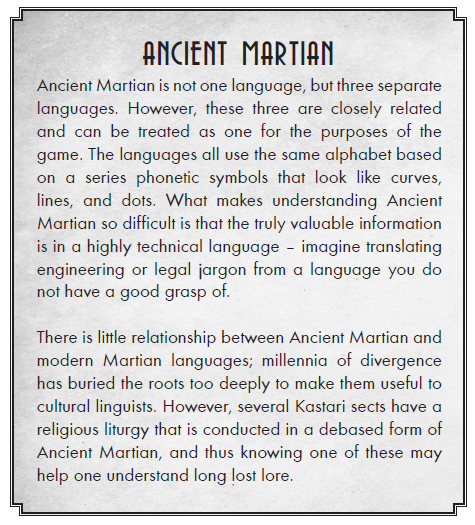
A spot of info on the languages of Ancient Mars.
Sir Daniel Edmund Pelham-Kole is not the real Sir Daniel Edmund Pelham-Kole. He is actually his batman, an orphan named Daniel Kirby, and was injured in the Battle of the Somme while the real one was killed. He took his identity and papers and ring to survive in a German hospital rather than a prison camp and was released when the war ended. He took Sir Daniel's life thanks to his facial injuries, knowledge of his life and the fact that Sir Daniel's family died in the war from war, disease and age and is now the shrewdest diplomat from England, responsible for getting England on Mars. He's even introduced the Martians to cricket and polo.
Otto Skorzeny is the real Otto Skorzeny. He's tough, strong, cunning and honorable and is responsible for espionage all over Mars on Germany's behalf. He works directly under Rommel, but as history as shown about him, he's not necessarily going to engage in the atrocities the Nazis want him to do.
NEXT TIME: the Asteroid Belt and beyond!
TOUR OF THE SOLAR SYSTEM: FINALE
Original SA post
TOUR OF THE SOLAR SYSTEM: FINALE
THE ASTEROID FIELD
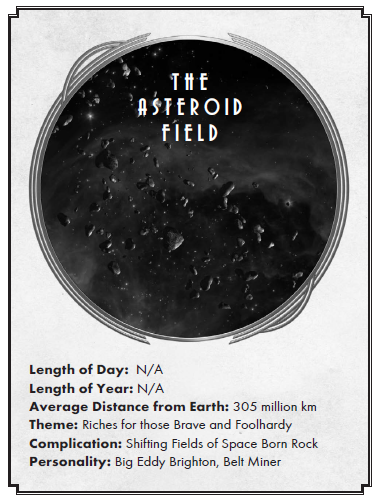
The asteroid field is all that remains of Planet Eris. All that remains are giant chunks of rock dividing the border between Mars and Jupiter. High mineral content (radium, iron, gold) and scattered, half-broken remains of Erisian ruins are the biggest draws of the belt. The risks are too high for corporations to chance, though; the big ones are perfectly fine exploiting the Ore Fields of Venus. Your average denizens of the asteroid belt are wildcatter miners (or a company) with armored space suits living on ships or scientists/explorers studying the ruins and recovering artifacts. Now, from an ethical standpoint, exploring and mining the belt are much better morally than the work done on Venus (plus all that ancient technology on Venus in and around the Crater is actually Erisian tech). Ethics don’t pay the bills though and the belt is much more dangerous with a high miner mortality rate from suit damage and getting knocked off into the void. In addition, there is absolutely no civilization or living presence besides whoever is camping out there in a ship.
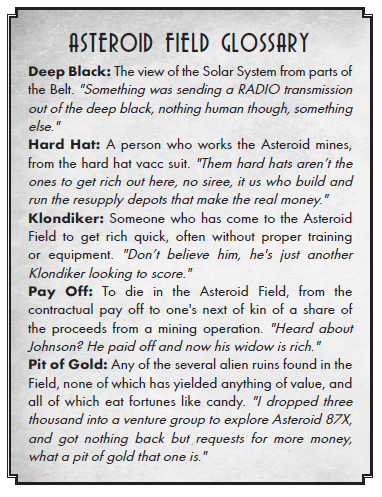
Big Eddy Brighton is an Australian miner who lost an arm in Gallipoli. He and his crew are the absolute best miners in the belt, operating for three years without losing a single soul. If you need to do work in the belt and need an ally, look up Big Eddy; he might be able to lend you a deluxe armored suit of his own design, nearly unbreakable and the safest around.
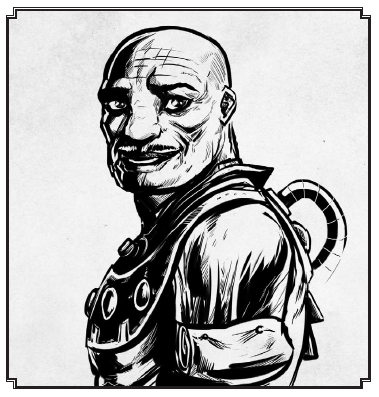
Big Eddy Brighton.
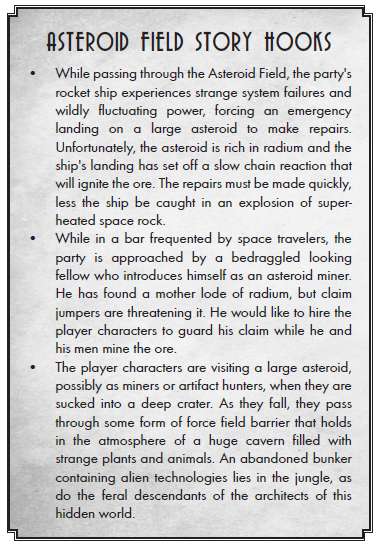
JUPITER AND THE JOVIAN MOONS
The Europan System (so named because the Europans named it after themselves) consists of Europe, Jupiter, Io, Ganymede and Callisto. Access to Jupiter and its moons was forbidden for a few years by the Europans because they didn’t trust mankind’s appetite for expansion (plus they have the guns to back up their threats). Eventually the Europans negotiated with the League of Nations and now countries of the League, Nazi Germany and the USSR can explore certain moons and certain parts of Jupiter as long as the Europans feel like it. Mankind’s presence in Jupiter is barely tolerated and we only are allowed there so long as we don’t offend the Europans. It really doesn’t help that the mouthpiece of the Europans (a human man by the name of Grand Admiral of Jupiter Sebastian Alexander Leopold von Hapsburg I) keeps issuing edicts about what people can or can’t do.
Jupiter
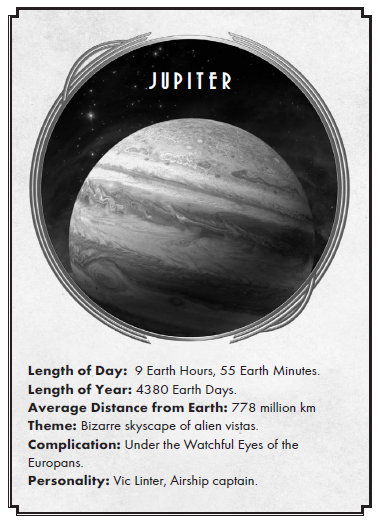
Jupiter’s still a gas giant, and because it’s made of different gasses (especially flammable ones, like methane) the safest form of transportation/habitation is airship. An airship is simply a modified rocket with an inflatable balloon attached to the hull and moved with propellers powered by the ship’s radium engine (which, being inside the ship, won’t ignite the atmosphere). The entire planet is like an air ocean with intense and dangerous pressures the deeper down you go. All throughout Jupiter are chunks of flying land (that run the risk of being sucked into deeper gravity wells and aren’t necessarily stable to walk on) and strange life forms that fly through the sky or live on land with nimble, careful steps. Microorganisms fly through the sky in massive packs, hunted by gasbags or leviathans while other predators fight over food and resources. The creatures that live on the pockets of land are long-legged, light critters that live in a constant frenzy of hunting, mating and dying. Nothing on Jupiter is sapient (as far as we know) but most of it is dangerous with a short lifespan.
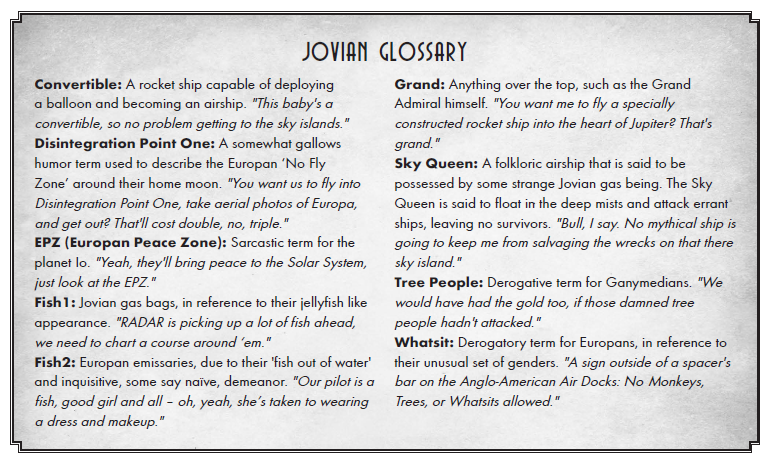
So why even bother with Jupiter? The Europans have essentially turned the planet into a source of entertainment by claiming they want to see humans behave more adventurous and more daring, wanting to watch us explore. Since most of the nations exploring the Europan system don’t want to be on the business end of a disintegrator, airship captains are going on adventurers and engaging in dogfights while the USA, USSR and Germany maintain large floating airship docks in safe atmospheres. The USA shares its docks with England, Mexico, Canada, France and Italy and run the safest public ports. Germany has a base far away from the others, Festung Jupiter, and they don’t let any foreign ships approach. The Russians are stationed above the North Pole at Belgarski Stalin and they’re not fond of visitors either.
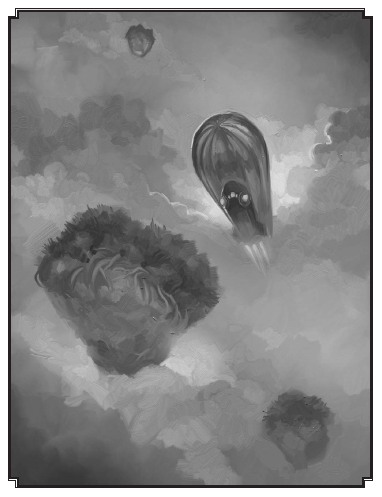
Vic Linter was a rich idiot with no day job, preferring to schmooze with women and race vehicles around New York. His parents gave him a sizable fortune and allowance as a bribe to go away and stop embarrassing the family. Now he’s a hot-shot airship pilot, exploring and smuggling and helping people when he’s not throwing one back at the Crash and Burn at the American docks.
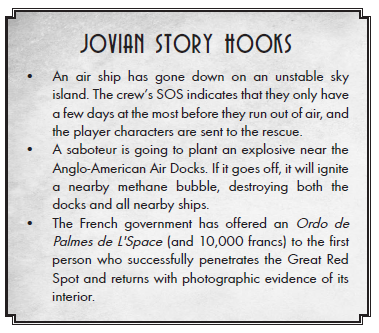
Europa
Humans are forbidden to go to Europa so basically everything anyone knows about Europa was gathered from telescopic monitoring or talking to Grand Admiral of Jupiter Sebastian Alexander Leopold von Hapsburg I (henceforth called Grand Admiral). Europa is 85% salt water with the sole land in a long, thin strip a bit above the equator with canals and rivers running through it. There are cities and docks but no telescope has seen a vehicle and no radios have ever picked up transmissions from Europa. The entire planet is orbited by 24 asteroids turned into beacons (1 furthest, 24 closest) with any trespassers going past 1 vaporized for intruding on Europan airspace. Demarcation Point One is basically a domed Earthling embassy on a massive asteroid with nations of the world keeping delegates and diplomats there to talk to the Grand Admiral (and Europans by proxy). The luxury and technology of DPO is beyond belief, but the politics leave something to be desired. On the one hand, beautiful grounds, excellent food, luxury out the ass. On the other hand, the Grand Admiral never tips his hand unless you’re in front of him and every delegate is trying to make the other look bad for the Europans to look favorably on them. DPO might just be another source of entertainment to them.
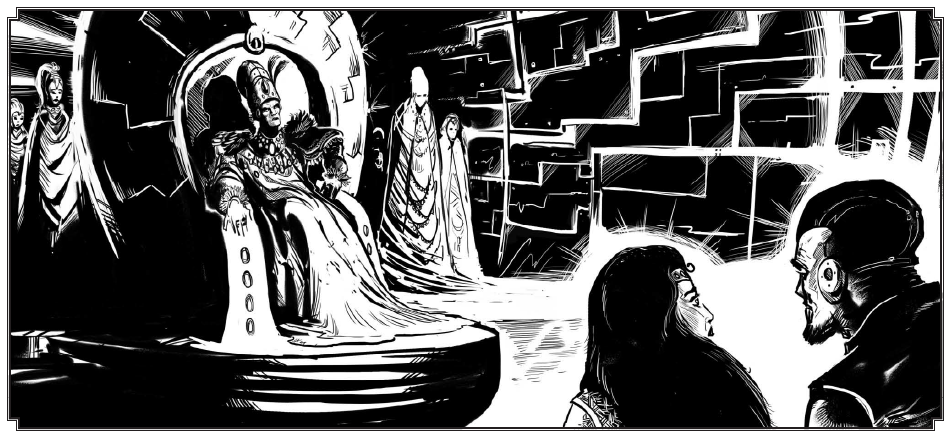
The Grand Admiral, probably yelling at these people.
Grand Admiral of Jupiter Sebastian Alexander Leopold von Hapsburg I is…all of that. The man’s history and attitudes are unreadable, loving pomp and bling (man has a golden throne encrusted with gems and little rockets made of platinum) as much as he loves being a condescending ass and making threats when he’s too busy to pretend to be listening. How the hell the Europans picked him to be Grand Admiral? Where did he come from? The universe will never know, considering how he’s tanned with blue eyes and brown hair, has an accent suggesting a heritage somewhere in the small country of Most Of Europe and speaks fluent English, French, Russian, German, Spanish and Venusian. My personal guess is that a bunch of Europan scientists cooked him up in a lab and loaded whatever they thought would be funny into his brain.
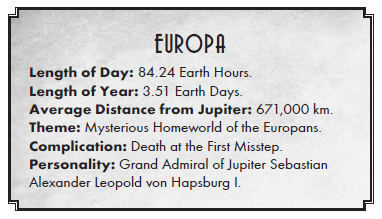
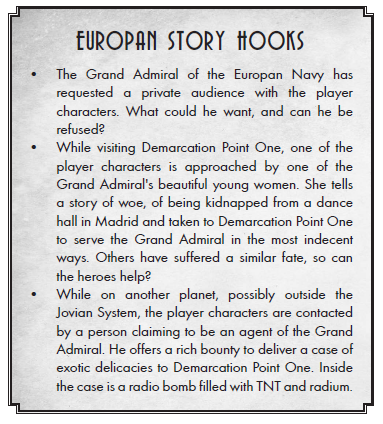
Callisto
Callisto is an ice ball of a moon, frosted over except where there are patches of water. No life forms foreign to Callisto can survive, forcing any visiting scientists to be careful. There are no reasons to visit Callisto except to study the wildlife, so people rarely go there. The wildlife is interesting, Arctic to the extreme, with the most famous species being the Callisto Yeti, a horned hominid that is covered in shaggy fur and muscle and stands three meters tall. Callisto Yetis are infamously violent and famous for killing members of the first scientific expedition to the planet that found life. Naturally, big game hunters would love to travel to Callisto and three Callisto Yetis are now at the Bronx Zoo in a special enclosure. A male and a female were captured by the Nazis as well and were meant to be brought to the Oslo Zoo through Berlin but there’s teensy problem of them escaping and currently being loose in Germany.
Dr. Francesca Santo is one of the solar system’s top exobiologists, specializing in the creatures of Jupiter and its moons. She’s been studying the seal-like life of Callisto for over four months now and the last time supplies were sent out…they couldn’t find her or her crew. Their camp was destroyed and surrounded by footprints of the Callisto Yeti and humans in heavy boots. There’s currently a reward for anyone who can bring Dr. Santo home safely (or at the very least, find out what happened to her).
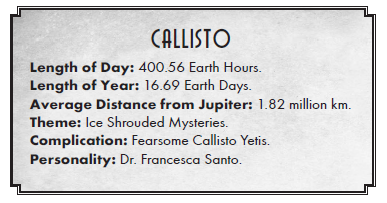
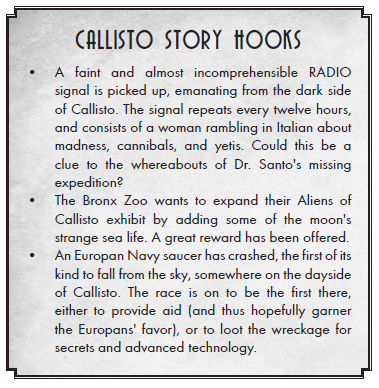
Ganymede
Ganymede is a lush tropical jungle of a planet, not nearly as hot as Venus but enough to make a regular Earthling from a cooler climate uncomfortable. Ganymede is safest place in the solar system to mine for gold and silver: no companies to deal with like Venus, no Martian politics, plenty of air unlike the belt. There’s no government on Ganymede, no corporations, nothing but hundreds of tents and wildcatter claims. This has two problems, though. First, no formal government means the place is full of people who solve their problems and squabbles with gunfire. There are vigilante mobs, sure, but cross them and you’re screwed. The other issue is the natives of Ganymede, the previously-discussed plant people with a symbiotic relationship with fungus. They’re shy but they’re stealthy and they may be packing Stone Age weapons but attacks on camps are common and they’re vicious guerilla fighters. The big thing standing between Ganymede and Earth is the lack of a common language.
Chan-la-lee is a Ganymedian warrior whose tribe strikes first to protect their planet. They figured out that guns and human weapons were even more effective against us and they began to collect them from dead miners. Up until recently, they were limited to whatever guns and ammo they could scavenge. But then Chan-la-lee was approached by humans waving white flags looking to trade. In exchange for those useless yellow rocks, the humans are supplying Chan-la-lee’s warbands with weapons and ammo. The question is, who is turning the Ganymedians into an armed fighting force and why?
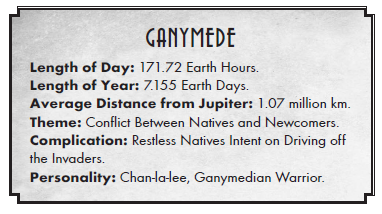
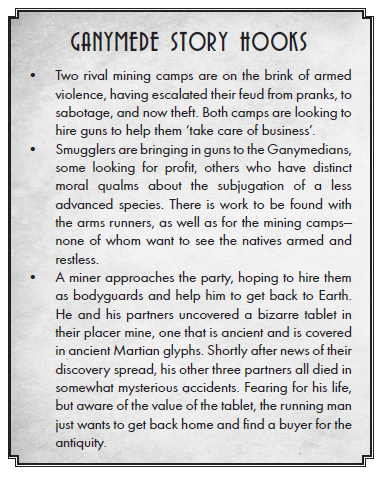
Io
Humans were only allowed to visit Io for three months before the Europans closed travel. Now, it’s a forbidden, desolate planet ravaged by Europan bombing. Why it was bombed? Nobody on Io can tell you and Europans will just shrug and say they had it coming. The only reason people could visit Io were to see what the Europans were capable of if they feel you warrant it. They say that Io was a beautiful planet with a beautiful people, a race of fair-skinned humanoids who put Martian Courtesans to shame. Now the planet is like Cormac McCarthy’s The Road, a dusty planet where the largest land mammal is a capybara-sized rodent and plants amount to weedy grass, mosses, lichens and protected shrubs. The cities of Io are broken ruins that glow in the dark from centuries-old radiation; the natives don’t stay there, they roam the planet in packs. The people of Io themselves are heavily altered from radiation, stunted into a grey-skinned, hunched species of sapient with skin conditions or other ailments from deeply-ingrained genetic damage. There’s nothing that interests Earthlings about Io except for the ruins and their people, some crews bringing them on board to give them a chance at survival.
Jan San Jan watched the explorers from Earth from a distance. When they left, he took everything they left behind as relics of a species of gods. Jan runs a cult that worships Earthlings, viewing them as a benevolent race that will use their science and wisdom to save his people. He has an altar made of human items his faithful worship at (made of trash and things discarded) and his followers scavenge for items they hope they can trade to us for tools or food.
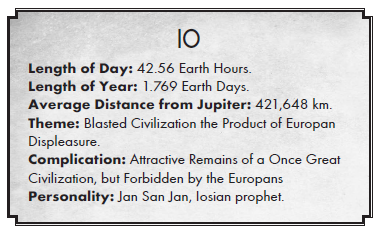
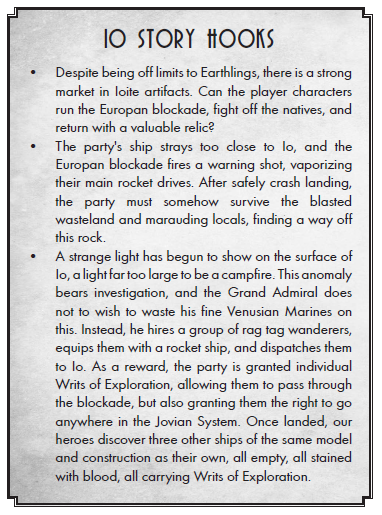
Moonlets
The moonlets are all of the other bodies that orbit Jupiter that are too small to be proper planets. The four important moonlets are Adrastea, Amalthea, Metis and Thebe. Metis was shaped into a football by Jupiter’s pull and has a dark side and a near side. The dark side is permanently night, covered in a fungus that feels like grass. The near side is a steamy, lush jungle. Both sides have issues with volcanoes and earthquakes. Adrastea is an ocean moon that has weird tides due to Jupiter’s pull and is a magnet for things that fall from Jupiter’s rings. Amalthea is a desert planet that travels a path of dust kicked up by its own storms, constantly picking up the trail and dumping it behind it in a circle. Finally, Thebe is a dead planet of dust and sand that scientists believe was part of Amalthea at one point. There’s not a lot to these planets because they really haven’t been explored yet, but that could change.
Morty Fletcher (aka Mort the Goat, Marvin Hayes, Dr. Martian and Professor Morthume Hildegard) is a notorious snake oil salesman and con-man. Not content to scam Earthlings, Morty sold non-existent weapons to Martian Princes and fake Martian healing technology to Venusians. He’s pulling his next jobs on and around Jupiter’s planets by writing fake exploration warrants and writs of colonization by the Grand Admiral. He’s also writing false certificates claiming that some moonlets are rich in ores and gems. How’s he getting away with this under the noses of the Europans?
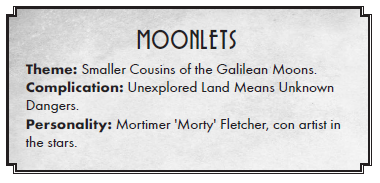
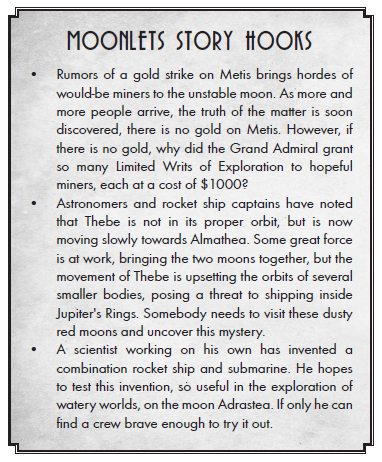
Lesser Bodies
The lesser bodies are things too small to be planetoids; asteroids, ice balls, space junk. They only have to offer ore and minerals and occasionally some of them have circumstances that allow a very strange form of life to emerge. The latter is really the only interesting thing about them, considering that the only ones that allow life are completely sealed from the vacuum and are little caves or little balls of rock and ice with alien creatures inside. There’s really nothing else to the lesser bodies and as a result most people don’t bother with anything but scientific exploration. It’s much safer to mine the belt because digging around in the lesser bodies of Jupiter might draw the wrath of the Europans.
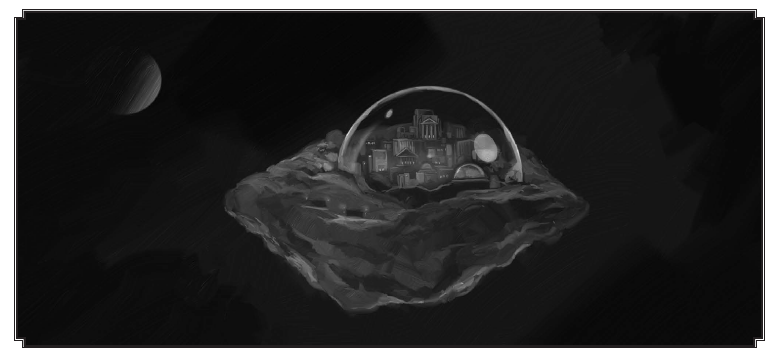
Chateau de Bubble.
Baron Nikolai Pahlen escaped the Communist pogroms of the October Revolution to end up chasing a bunch of bad deals in the Honduras, Paris or Africa. A ladies man and adventurer, he made a small fortune in African diamonds up until he found out that the land he thought he bought mining rights to wasn’t his. He used the last of his diamond money to buy a rocket ship and crew and is now chasing what’s probably another bad deal: mining and exploring the lesser bodies.
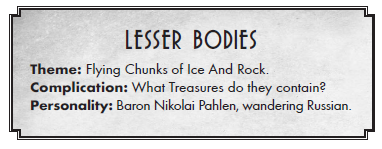
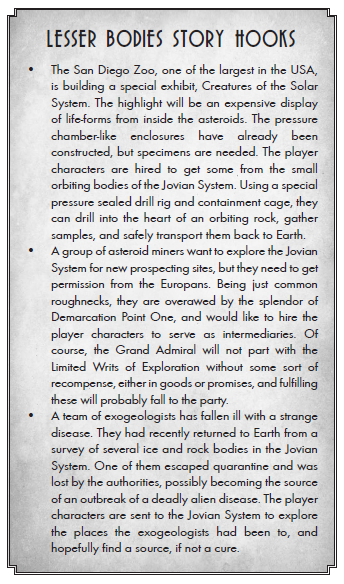
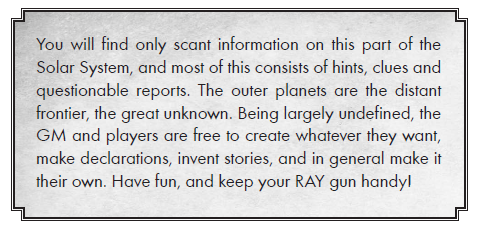

SATURN
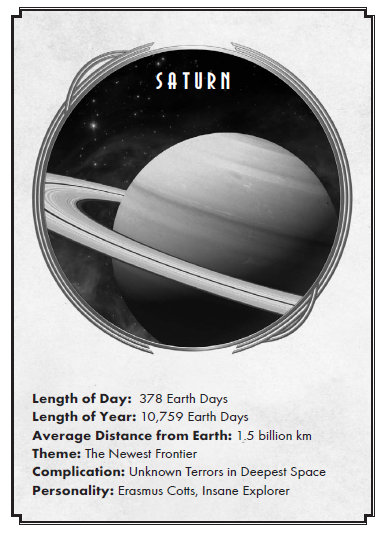
Saturn is a lot like Jupiter, what with both being gas giants orbited by moons. People don’t bother much with Saturn due to it having many similarities with Jupiter (down to the creatures living in the atmosphere). People are much more interested in the moons of Jupiter, especially Titan. Titan is an ocean planet with just one continent and a sprinkling of islands. The water glows at night thanks to a water soluble radium isotope and sparkles in the day due to dissolved gold. Titan is home to many predatory species of creatures that resemble dolphins or whales or sharks, all of them able to survive the dangerous, constant storms. Aside from the exotic sea life, there are sapient beings on Titan. The H’ykar are amphibious humanoids that make use of the land, socially and technologically progressed to the point that they’ve figured out agriculture. The Sivaan, on the other hand, are amphibious starfish that communicate telepathically in any language to ask for a ride to stay out of the storms. When not speaking telepathically, the Sivaan enjoy eating, mating, burrowing and philosophy. The H’ykar worship the Sivaan who are considering manipulating them for a symbiotic (or parasitic) evolution. Other than Titan, who knows what else can be found on the moons of Jupiter? There’s no Europans to worry about out here.
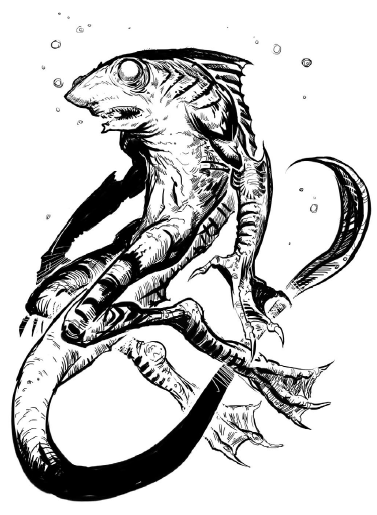
A H'ykar specimen.
Erasmus Cotts went too far out in space and he did it alone. He set many records for solo flight and furthest distance, but he crashed on a moonlet of Saturn when he tried to explore the moons. Erasmus lived off fungus and water for nine months on a moonlet with barely enough air as he tried to rebuild his rocket. By that point, unfortunately, isolation and nutritional deprivation set in and Erasmus lost his mind. By grace of a miracle he found an alien ship and used it to rebuild his own rocket, but he hasn’t left Saturn. Now Erasmus Cotts is a madman at the helm of a hybrid ship armed with lost alien technology hunting anyone who dares enter his realm, secretly praying for death with every fight he starts.
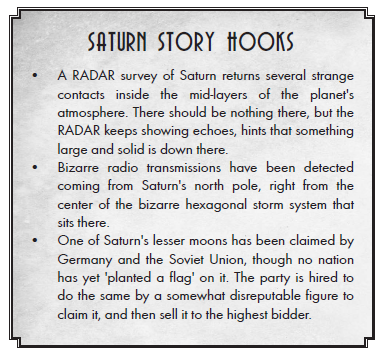
URANUS
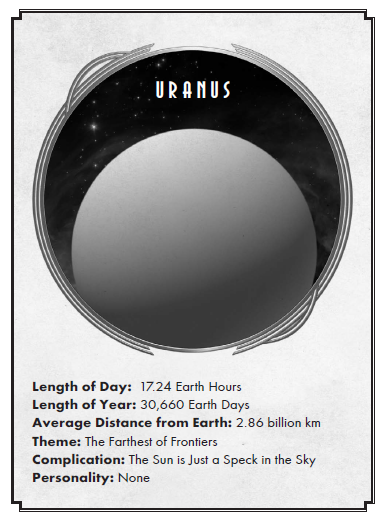
Nobody has gone to Uranus and come back alive. Everything that explorers and scientists have to go on is either from telescopic observations or recorded radio transmissions from doomed explorations. Uranus itself is a sub-Arctic gas giant with no observable life (although one expedition claimed that something big had grabbed hold of the ship before their transmission was lost). The two notable moons, Titania and Oberon, are the only places big enough to land on but there was only one exploration to Oberon. Every inch of Oberon is covered in a thick red moss that glows green at night. The moss is impervious to flame, tough to cut and grows rapidly in hours, requiring the scientists to constantly keep it off the rocket. The sole expedition to Oberon didn’t end well either; the engines of the rocket exploded when it tried to take off and escape the moss.
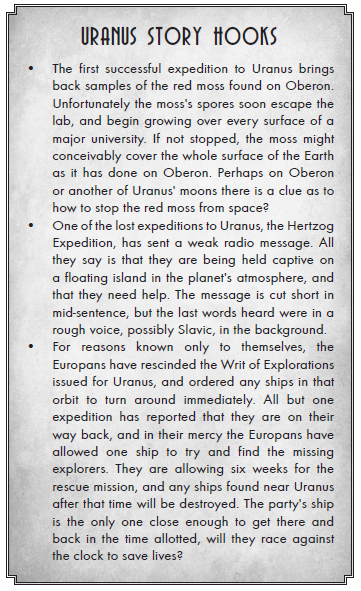
NEPTUNE
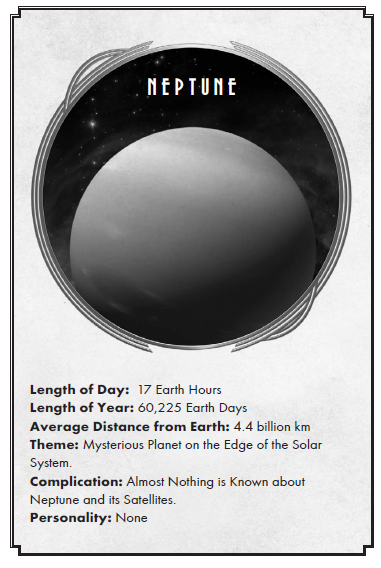
Few people have gone to Neptune and less of them have returned. The reports of survivors and radio transmissions have told scientists that Neptune is a gas giant, but that’s it. Neptune is a mystery, almost completely unexplored and untapped. But why would you bother when it’s so far away? Neptune has no story hooks, that's all on the GM and players to figure out.
PLUTO
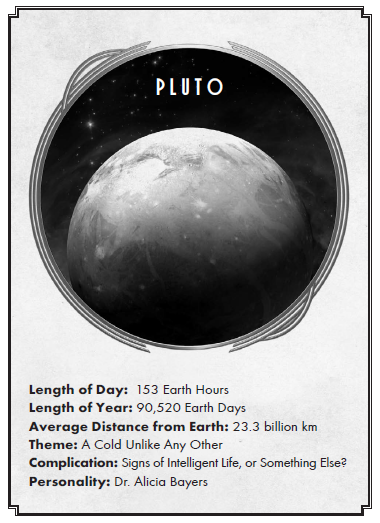
Nobody has gone to Pluto. The closest anyone got to the planet was Einstein and that’s just because he engaged his experimental warp drive and took off into the unknown from there. Everything known about Pluto is known from remote observation, namely that it’s ungodly cold and unnaturally strange. Shapes appear in the snow sometimes, shapes scientist claim resemble howling, snarled faces hundreds of kilometers wide and long. No two faces are the same, but they all have common characteristics: man-beasts with long predator teeth and heavy brows. Are they hand-made structures crafted by the native Plutonians like the Nazca lines and American Indian mound sculptures? Are they something weirder, something alien living in the snow as snow? Are they just projections of the human mind’s tendencies to look for familiar patterns like shapes in clouds? You’d have to go to Pluto to find out.
Dr. Alicia Bayers would like to go to Pluto to find out. She firmly believes that faces of Pluto are constructed by hand by an intelligent native species. However, her fellow scientists don’t believe her and she’s been applying to every grant and opportunity in the US to get to Pluto and find out. Her obsession with the planet and her zeal has given her a label as a crackpot and she’s been fired from teaching at universities over it (MIT and more). She is the world’s foremost scientist on Pluto, but her patience is running out and she might do something stupid to fund her dreams.
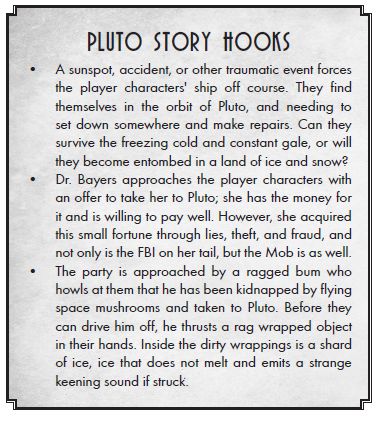
The book is designed so we’d jump right into character creation but before that, I’d like to skip ahead to more specifics about the playable races. This way, we can get a better handle on who they are and what they’re like rather than just what their worlds are like. So NEXT TIME, let’s look at the Sophonts of the Solar System.
SOPHONTS OF THE SOLAR SYSTEM
Original SA post
SOPHONTS OF THE SOLAR SYSTEM
A sophont is defined as a species of intelligent creature with sapience equal to or greater than mankind's. The game admits that some of the races might present a challenge to roleplay (namely Europans) but the challenge might be part of the fun. They expect most of your party to be human because most people who play this game will be comfortable as playing a human, but don't limit yourself creatively; play an alien race because you think it'll be fun.
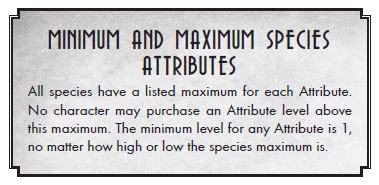
EARTHLINGS
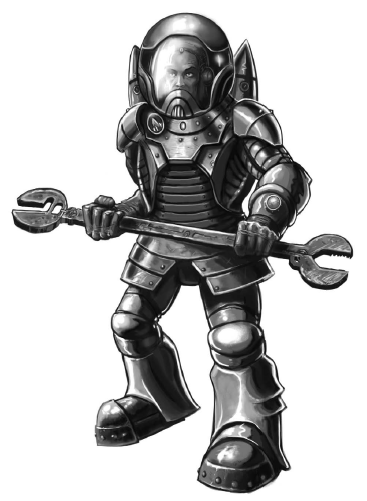
Yeah, it's our Solar System now, no matter what anyone else says.
Earth of the 1930s has a lot of similarities to our current day but it's still got its own issues. The cultural/technological gap between nations is massive with some humans packing RAY guns and jetpacks and others still living day-by-day with spears and nets. The big thing that separates us from the aliens (besides living on a Goldilocks planet) is that we persevere and we're a bunch of lucky knuckleheads. Only the Warrior Castes of Mars like crazy lost causes like we do but no other race would jump into the unknown unprepared like we do.
Humans can have up to a 6 in Awareness, Coordination, Ingenuity, Presence, Resolve and Strength. Psychic powers are rare for us, we generally require a focus on them or training. Humans also get the Trait Friends (Minor Good) for free. A human character costs 1 point to play.
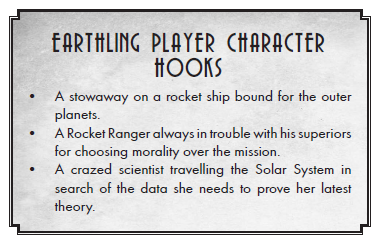
EUROPANS
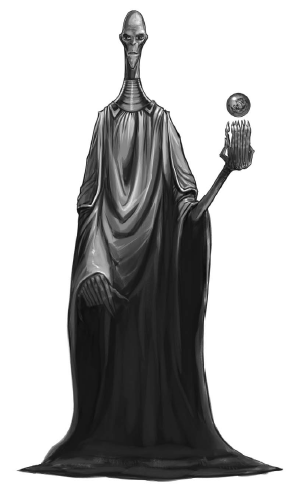
I am on a peaceful mission to study the lives of the Deutsche Marskorps. Please know that I kill you only to further that understanding.
What mankind has learned about Europans has only been revealed by what we can see and what we've been told. They have small ears, small noses, small mouths and big eyes. Each hand (on a long arm) has seven fingers flanked by an opposable thumb and each digit has five knuckles. They're hairless, three meters tall and come between blue-grey or light purple in skin tone with red or yellow eyes. Europans have genitals and they possibly have five genders: male, female, neuter and two unknown. What's really odd to humans about Europans is that they've never spoken Europan, they've always spoken perfect English/Spanish/etc and they've never been seen using their arms to lift. The majority of Europans are met under two conditions. First, there's the Europan Emissary, a wandering scholar who observes the races of the solar system to take notes and study. Second, there's the regular type of Europan one would meet around Jupiter. The second example will not tell you about their planet and their people while the first example actually can't. Emissaries can't seem to remember a single thing about Europa but they also tend to be more open-minded and willing to listen to other ideas.
Europans get +1 Awareness (max 7), +1 Coordination +1 (max 7), Ingenuity +1 (max 7), Presence max 6, Resolve max 6 and Strength max 5. For Traits, Europans get Alien Appearance (Minor Species Bad), Distinctive (Minor Bad), Hypnosis (Minor Good), Immortal (Major Species Good), Immunity: Disease (Major Species Good), Immunity: Poison, Psychic Training (Minor Good), Weakness: Lead (Major Species Bad). Because the majority of Europans are psychic and get training, they can take further psychic skills. Europans cost 10 points.
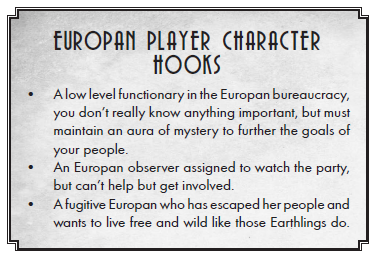
GANYMEDIANS
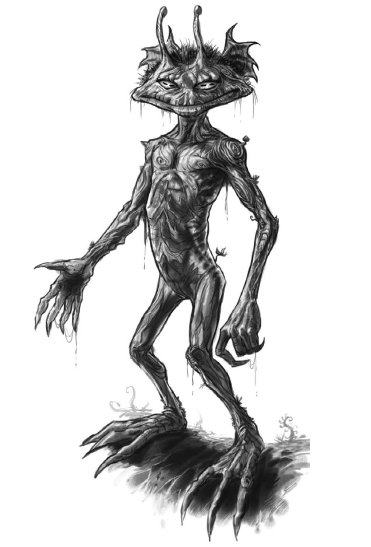
The forest may be our home, but we must venture to the sky beyond, and beyond that, to gain the power to defend it.
Ganymede itself is basically one big organism and the Ganymedians reflect that: they're mobile plant and fungal colonies that are like cells of the planet. They're bipedal with skin made of bark and wood pulp, three-toed and have rotating fan ears and antennae that act as scent organs. Ganymedians can see in the dark well and they have no hair, only leaves. Ganymedian skin has red-brown bark skin, dark black/brown patches of rough and hard bark and hair-leaves. The black patches of bark are actually a fungus that's a wound coagulant/stauncher, quickly growing over a wound and making it tougher until it fades away into regular bark. They even eat through photosynthesis.
What's truly interesting is that the only absolutely vital parts of the Ganymedian anatomy are the nervous, reproductive and circulatory system. Everything else (organs, skin) are plant/fungus symbiotes with universal compatibility. Ganymedian medicine boils down to harvesting the proper seed/pod for a replacement and putting it in their body until it grows or taking what's needed from another Ganymedian. The scavenging of replacement parts from injured Ganymedians was unfortunately misinterpreted in two ways. First, humans on Ganymede saw them doing this after battle and think the Ganymedians are cannibalistic savages when it's no more cruel than switching pieces on a Lego figure. Second, Ganymedians attempted to heal injured humans by stuffing pieces from other humans into them before realizing their mistakes (and this was also seen by humans as more proof of their savagery).
Ganymedian society focuses on the Sacred Grove, the tribe and the band. The Sacred Grove is the tree that they were born from, kept in a protected area with permanent houses, gardens and other luxuries like running water. The Grove is protected by the elderly before they're buried in the tree's roots for nutrients. A tribe is simply every child of a single tree and bands are collections of six or more Ganymedians born during the same season. Bands live and hunt together and only disassemble when there are less than six, the rest joining new bands. Bands keep things running smoothly on Ganymede; they make tools, prepare food (never cook, they fear fire despite having no natural weaknesses), make sure that the different creatures of nature do what they should. The most important part of Ganymedian society is the yearly flowering when flowers painfully push through a Ganymedian's bark over the span of 2-3 weeks and they're overcome with irritability, wanderlust and hunger. When the flowers are in full bloom and they're at the Grove, their flowers will spread pollen to the trees in a mass seeding so the Grove will drop seeds into the soil to grow new Ganymedians.
Ganymedians get +1 Awareness/Resolve (max 7), Coordination max 5 and all other stats at max 6. For Traits they get Alien Appearance (Major Species Bad), Alien Organs (Minor and Special Species Good), Alien Senses: Ultraviolet (Minor Species Good), Armor (Minor Species Special Good), The Flowering (Minor Species Bad), Photosynthetic (Minor Species Good), Keen Senses: Vision (Minor Species Good), Impaired Senses: Touch (Minor Species Bad). Ganymedians have not exhibited psychic powers to date. They cost 4 points to play.
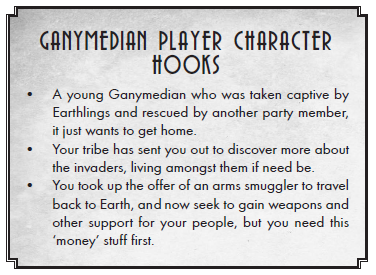
IOITES
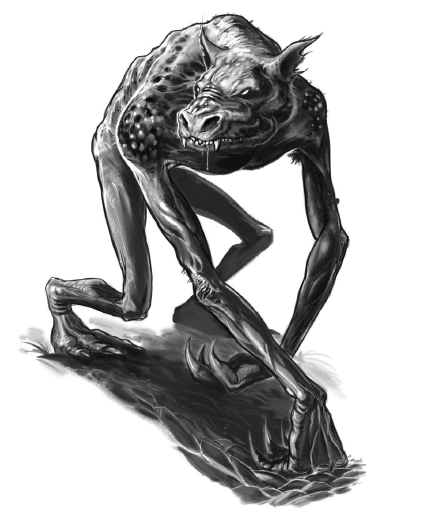
Are you going to just throw that away? Sure, I'll eat it, I don't care how long it's been left out in the sun, or what this "road kill" is that you speak of.
Ioites are quite striking in their appearance. They lope on their crouched legs and knuckles; their skin is grey with their skin conditions ranging the primary colors with the occasional patch of hair, lesions or bumps. Because their mouths have snouts, it’s their eyes that hold their expressions of emotions. Ioites are constantly “crying” (or constantly leaking liquids) from the corners of their eyes and each emotion is clearly defined in the ways their eyes widen, shrink, squint or shift. The most common emotions expressed are anger, fear, greed, lust or surrender.
They’re still sufficiently intelligent. Ioites use tools, they think, their language is a working hodgepodge of grunts, gestures and words. They are capable of compassion and emotion, especially towards members of their tribes. There’s no grand unifying society on Io; there’s only tribes of survivors living among claimed areas of the ruins.
Ioities get +1 Awareness (max 7), Coordination max 6, Ingenuity max 5, Presence max 5, +1 Resolve (max 7) and Strength max 6. They start with the Traits Alien Appearance (Minor Species Bad), Fast (Minor Species Good), Immunity: Poison (Major Species Good), Keen Senses: Smell (Minor Good), Night Vision (Minor Species Good), Quick Reflexes (Minor Good), Tough (Minor Good), Unattractive (Minor Bad). Ioites can be psychic and it’s more common than most species, but they lack the proper training. It costs 6 points to play an Ioite.
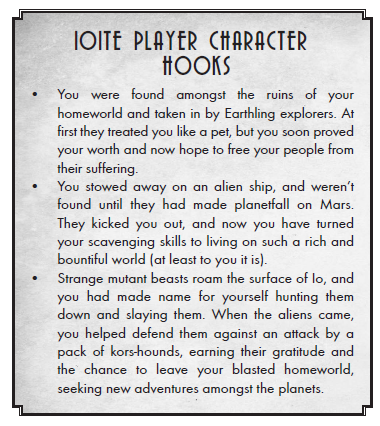
MARTIANS
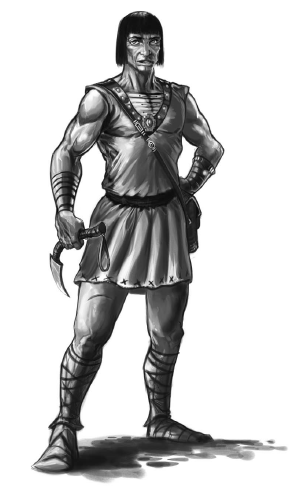
Since my freedom I have gone from turning a crank on an Ancient machine to building a new device to turn the crank for me.
Craftsmen: Imagine if the robot arms on a car’s assembly line were a race of people. Those are the Craftsmen of Mars. There is a dangerous ignorance on Mars for how things are made and actually work, for even though every step needs a Craftsman along the way they will only know their part. A Craftsman who lays brick for walls has no idea how to mix mortar, a Craftsman who mixes mortar has no idea how to bake the bricks, the Craftsman who bakes the bricks has no idea how to lay the bricks and so on. The entire Craftsman caste is made of subcastes on subcastes on subcastes, starting with a big industry (like masonry) and slowly breaking it down further and further (mix mortar, lay brick, bake bricks, etc). This is entirely by design of the Ancients and the Royals so that everyone in the Craftsman caste has something to do. You can’t marry outside of your subcaste; the best you can do is try and get transferred to a new principality. This is what it’s like for one of the biggest Castes on Mars, day in and day out. No innovation, no new creations, you do what you were born to do. Using tools not meant for you is punishable by death and innovation is heresy against the infallible designs of the Ancients.
Craftsmen are the closest to human of the Martians. They average around 6 feet, their build depends on their industry and have coppery-red skin with brown/black eyes with a slit and black hair that seems to only be on their head. Craftsmen wear tunics dyed in dark colors that have their family history and subcaste tailored on the hem in designs. They also like to fashion little articles of jewelry/adornments that indicate their specialty of work. Craftsmen are generally psyched as all hell for humanity because we’re more than willing to allow them to explore beyond their craft, especially if we can make money off of it.
Craftsmen get +1 Awareness/Coordination/Ingenuity (max 7) and Presence/Resolve/Strength max 5. They get the Traits Keen Senses: Vision (Minor Good), Technically Adept (Minor Good), By the Book (Minor Bad), Obsession: Choose (Major Bad) and Unadventurous (Minor Bad) but they can replace By the Book or Unadventurous with Outcast (Minor Bad) and/or Phobia (Minor Bad). Craftsmen are rarely psychic. They cost 3 points to play and as a side note, their Obsession should be Minor, not Major for reasons that will be explained later.
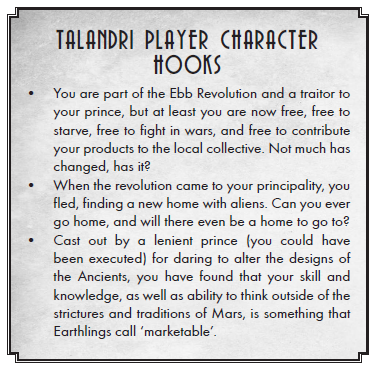
Feral: There are four broad subspecies of Chanari Martians. The Silt Sailors are the biggest tribe, sailing the Silt Seas and carrying passengers and goods. They’re considered to be the most approachable tribe. The Desert Dwellers are the ones crazy enough to live in the deserts and they enjoy raiding. The Desert Dwellers are what Martians and humans think of when they hear “Chanari”. Scavengers live in the ruins and pick through rubble of old principalities for things to sell, living somewhat comfy lives in the shadows of ruins. Finally, the Caravan Chanari dislike the Desert Dwellers and roam the roads helping Merchants.
The Silt Sailors are like Craftsmen but with long braided hair and a slightly shorter stature but with deep brown-red skin. Desert Dwellers are tall and lithe with the same type of skin, naturally hairless except for thick eyebrows and eyelashes. Desert Dwellers have a nictating third eyelid, broad and deep noses with big nostrils full of hair as natural sand filters. Scavengers are smaller with vertical slit pupils, weak/no chins, thick brows, big noses, short bodies, long arms and much more hair than is normal on a Martian (but that’s not really saying much). Caravaners? Well they’re kind of descended from Merchants, so…kinda like more swarthy Merchants.
Feral Martians get +1 Awareness/Resolve (max 7) and all other stats have max 6. They get the Traits Adversary: Rival Tribe (Major Bad), Friends: Tribesmates (Major Good), Keen Sense: Sight (Minor Good), Tough (Minor Good) and Unattractive (Minor Bad). Feral Martians can be psychic but it’s considered unlikely (as an interesting side note, a future book mentions that Chanari tribes have no problems with psychic power or homosexuality, considering the latter to be a sign of the former even if they’re not). It costs 3 points to play a Feral Martian.
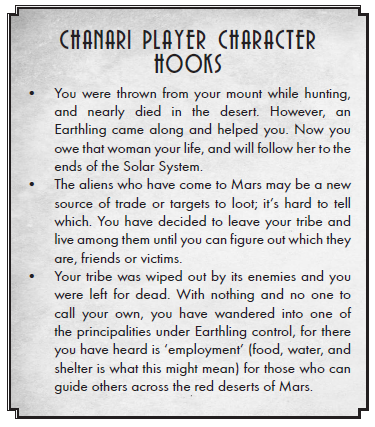
Tribute or blood, nobody passes our land for free.
Merchant: Answering the question of “what do the Merchants look like then?” is the fact that they have the same slender build as the Royals but with hair and more humanoid facial features. Merchants keep Mars running, going between principalities as needed to broker trade deals, get cargo moved and operate the thriving Martian black market. There’s not much too them, really; on a psychological level, they absolutely love what they do and the art of mercantilism.
Merchants get +1 to Awareness and Presence (max 7) but a max 4 in Strength (all others are 6 for stats). They get the Traits Brave (Minor Good), Friends (Minor Good), Indomitable (Major Good), Owed Favor (Minor Good), Obligation: Masters (Major Bad). Obligation can be traded for two of the following: Eccentric (Minor Bad), Impulsive (Minor Bad), Phobia (Minor Bad), Outcast (Minor Bad). If a Merchant is psychic, they need the Dark Secret negative trait; they might pick up the training for it but the Merchant caste isn’t trusted particularly well and the psychic powers are definitely a deal breaker. Merchants cost 5 points to play as them.
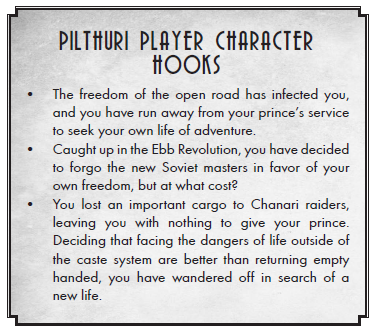
Here's the deal, five bahmoots, fifteen screaming Maduri mercenaries for a week, and fifteen fistfuls of gold.
Priest: Priests can marry between castes and climb the ladders of the subcastes. All Priests uphold the general principles of the worship of the Ancestors, which is like Buddhism/Hinduism mixed with Andrew Ryan’s Great Chain. The Ancients are at the top of the Ladder of Being with all life going down the ladder: Ancients, Royals, Priests, Warriors, Craftsmen, Slaves, Chanari, domestic animals and wild animals. Live a virtuous life according to the ideals of the Ancestors and when you die you’ll be bumped up the ladder. Everything besides that is open to interpretation and all that jazz, with some Priests being involved in somewhat heretical sects and some Priests living in a temple dedicated to the cleaning of Ancient Machinery for ascension.
The three most popular sects are the Orthodox Fellowship of the Transcendent Light, Order of the Sacred Hamaxe and Society of Eternal Bliss. The Orthodox Fellowship are your standard conservative Martian religious order: the Royals love them for maintaining the status quo, they do a lot of rituals on a daily basis and organize festivals, the High Hierophant is basically the Martian Pope, the temples run banks, political advancement is really only for men, you have to ascend the Ladder one rung at a time and anyone not from Mars is less than a wild animal in their eyes for religion as a being that did something really bad to be born not on Mars. The Order is a newer group that revolves around warbands of Priests who follow Warriors to protect Mars from wild animals, Ferals and “demons”. They do exorcisms, they fight wars and battles and they tend to treat everyone in their group as an equal (their warbands also include slaves, craftsmen, etc.). The Society boils down to “if you do really well in life, you might be able to jump a few rungs” which the Orthodox doesn’t like at all. There are rumors that the Society supports the Communist uprisings in some of the principalities but as a whole it preaches for general equality among the castes and among Martians who want to follow the teachings of the Ancients.
Priests get +1 to Presence/Resolve (max 7) and all other stats get max 6. For Traits they get Code of Conduct (Minor Bad), Psychic Training (Minor Good) and Voice of Authority (Minor Good). It’s common for Priests to be psychic. They cost 3 points to play.
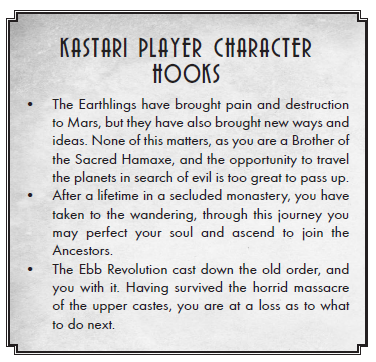
The Ancients command that we resist the coming of these Aliens, as they resisted all those who would come and defame their glory.
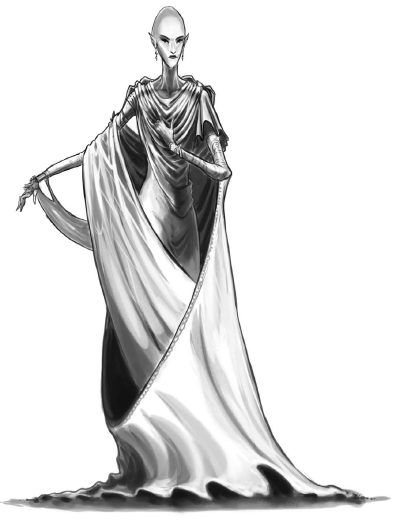
My word is nothing less than a command.
Royal: Even though a single Prince/Princess rules a principality, even though the Merchants keep the food moving, the Warriors protect them, the Slaves keep everything running and the Craftsmen make everything, pretty much every Royal has something to do. The Royal caste is heavily stratified with subcastes and if you want to be a Prince, you should’ve been born in the Prince caste. The best you can do in Martian society as a Royal is to be at the top of your subcaste if you’re not a Prince. An officer of the Military Caste can never be a Police captain, but the bureaucrat who checks passports might very one day be in charge of the Security Caste if they’re clever enough. The Prince rules but every Royal actually plays a part in keeping things running.
Royal Martians are two meters high with slight builds (the thinner you are, the better your breeding is presumed to be unless you might actually have to be on the field). Their skin is deep ochre to a light copper. Their eyes are slitted with purple/maroon irises and no hair grows on their body except for the head. Because it’s considered the ideal of Martian beauty to be bald, most of them are (if it grows it’s straight hair and blue-black). They love their clothing to an extreme, with only the Royal caste being allowed to wear white clothing. Most Royals wear bright, loose, airy clothing with it being common to have Slaves dedicated to keeping your outfit together.
Royals get Presence +2 (max 8) and Resolve +1 (max 7) but Strength/Ingenuity max 5 (with the rest at 6). Their Traits are Attractive (Minor Good), Friends (Minor Good), Psychic Training (Minor Good) and Voice of Authority (Minor Good). Psychic powers are common in Royalty and cultivated if they appear. Royals cost 6 points to play.
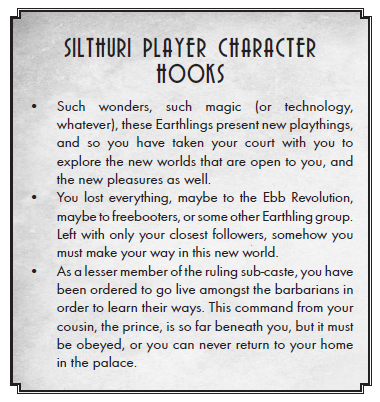
Slaves: Slaves are also stratified by sub-caste and purpose but are generally divided between Labor or Service. Labor Slaves carry things and perform dangerous tasks while Service Slaves are often used in higher society, sometimes as sweepers or watchmen or armor cleaning or more. Service Slaves are more purpose bred than Labor and tend not to do more than one specific job. Labor Slaves are big; large frames with muscles and height, hardy strength and endurance at the cost of intelligence and free will. Their skin is a dark red, their eyes shiny and devoid of spark, their faces brutal with heavy brows, thick jaws and long black hair. Service Slaves are generally copper-toned, little hair, black/brown eyes that may or may not reflect intelligence and a regular humanoid build. Courtesans are a different matter with being designed to appeal to the ideal of Martian beauty. Courtesans have long limbs, slender bodies with creamy copper skin, little to no hair and two striking features: natural pheromones and bright green/violet eyes.
Laborers get Strength +2 (max 8) but get Coordination max 5 and all other stats at max 4. Their Traits are Tough (Minor Good), Enslaved (Major Species Bad), Technically Inept (Minor Bad) and Unattractive (Minor Bad). Enslaved can be exchanged for two of the following: Forgetful (Minor Bad), Impulsive (Minor Bad), Insatiable Curiosity (Minor Bad) or Outcast (Minor Bad). Laborers are incapable of being psychic. Playing as a Laborer actually gives you 3 points, their cost at -3.
Courtesans get +1 Awareness/Coordination/Presence (max 7), Ingenuity max 6 and Resolve/Strength max 4. Their Traits are Attractive (Minor Good), Charming (Minor Good), Distinctive (Minor Bad), Empathic (Minor Good), Enslaved (Major Species Bad) and Technically Inept (Minor Bad). Enslaved can be exchanged for two of the following: Adversary (Minor Bad), Cowardly (Minor Bad), Insatiable Curiosity (Minor Bad), Obsession (Minor Bad) or Outcast (Minor Bad). Courtesans can be psychic but require the Dark Secret negative trait. They cost 0 points to play.
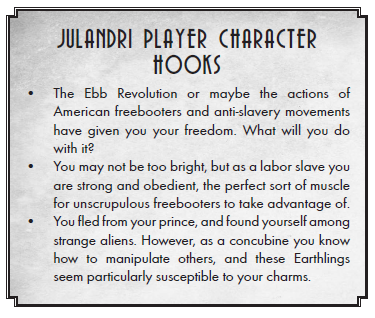
Laborer: I be free now, you want cargo move, you pay one dollar./Courtesan: Hello, is there something I can...do for you?
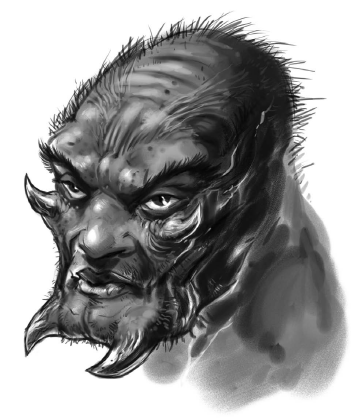
We fight because we are Maduri, we win because we are Maduri, we die because we are Maduri, there is nothing more to say.
Warrior: The Warriors of Mars stand around two meters tall with coppery red skin, red/blue/purple eyes, wiry black hair and two to four “tusks” that jut from their faces. A Warrior’s legion is their family and you’re born into a specific roll, drilled into it and made the master of it. Legions are broken into two cohorts and each cohort is broken into squads of 8-20 Warriors. You’re related to every last person in your legion. Men are trained for aggressive combat that focuses on raids and going to the enemy, women are trained in defense and managing support groups. This isn’t mentioned in this book, but the sexual dimorphism between men and women Warriors is quite large. The men are humanoid and average-sized while the women are bigger, tougher and stronger for playing defense. A legion either serves the state or a religious sect and their strategies and armaments depend on what role they play on Mars.
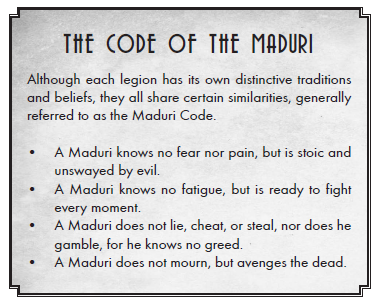
Warriors get +2 Resolve (max 8) and +1 Coordination/Strength (max 7) with all others at max 6. Their Traits are Alien Appearance (Minor Species Bad), Brave (Minor Good), By the Book (Minor Bad), Code of Conduct: Maduri Code (Major Bad), Fast Healing (Major Species Good), Fighting Man (Minor Good), Night Vision (Minor Species Good), Obligation: Master (Major Bad), Obsession: Order (Minor Bad) and Quick Reflexes (Minor Good). They can exchange Obligation: Master for two of the following: Adversary (Minor Bad), Argumentative (Minor Bad), Outcast (Minor Bad), Obsession: Order (Major Bad) or Unlucky (Minor Bad). Warriors can’t be psychic. They cost 5 points to play.
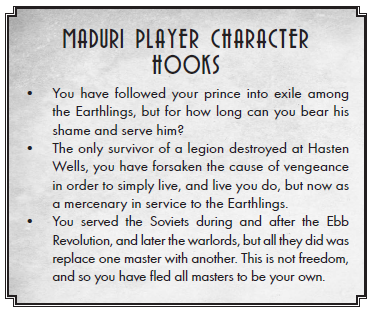
VENUSIAN
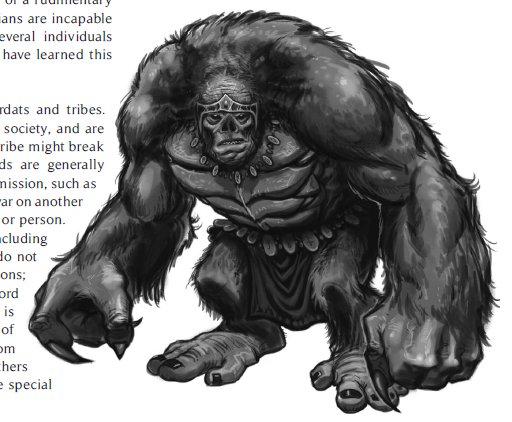
I came here to learn, to explore, not to kill, but if I must, I will.
Venusians are Erisians who survived the destruction of Eris to live on Venus instead. They’re two and a half meters tall and often walk like gorillas, their pelts coming in a wide range of color from white to dark grey. They also have thicker skin on their chests that coordinates with their pelts (pink for light hair, grey for dark). How do you tell a Venusian male apart from a female? The males have thicker chest plates that only get thicker with age and a male Venusian older than 30/40 will have their pelts start to turn silver like a silverback. They have six fingers plus a thumb on each hand tipped with claws, excellent night vision (with the general flaw of farsightedness not being uncommon) and heightened smell.
Venusian culture is tribal in nature with Concordats breaking down into tribes that live communally. Concordats are located around one place where the tribes can convene, a fortress full of food and seats for debates and politics. These places are old structures built by ancient Venusians. Venusians take very well to Communism, true Communism; all children are raised by everyone in the tribe, items are shared freely. They speak a complex language of vocalizations but don’t have a written language outside of carved pictographs/hieroglyphs and their word for “tool” is the same word as “weapon”. Venusian culture is incredibly social; peer pressure, condemnation and disapproval are strong enough that if enough in a tribe feel one way, the person they feel about is no longer part of the tribe. An isolated Venusian can die from loneliness and exile is considered one of the worst punishments to the person being ostracized tends to do their best to change and conform. Aside from this, there are no inherited positions of power in a tribe or Concordat; all power must be earned and it’s earned through respect and merit. A good Venusian will live their life according to the philosophy of the Thirty-Three Truths and with more respect the more your voice is heard, the more mates you get and the more power you get.
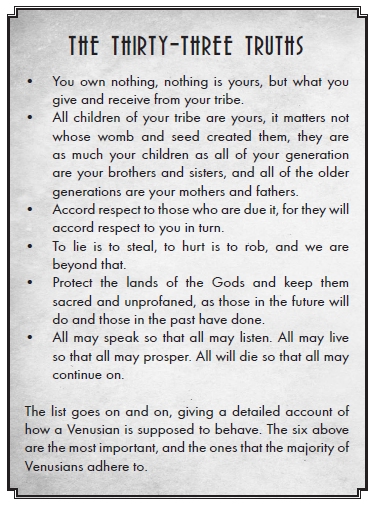
Public debate and philosophy is one of the key cornerstones of Venusian society and psychology. Venusians absolutely love to talk all the time about everything. Public speeches are often interrupted or heckled or challenged and it’s a sign of respect if a crowd of watchers is quiet enough to not question the merits of their speech or presentation. They love storytelling, they love gossip, they love taking a contrary opinion or talking about something controversial to get a topic rolling. This is why Speaker is one of the highest positions of authority a Venusian can aspire to. Even in the company of non-Venusians or other sapient creatures, a Venusian will still do their best to talk for the sake of talking to get more insight into the people they’re traveling with.
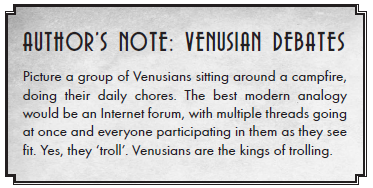
Sometimes there will be a matter all tribes of a Concordat must weigh in on. In that case, they’re all summoned to their sacred temple for the Speakers of each tribe to debate without interruption like lawyers presenting sides of a case. When the High Speaker feels enough debate has passed, they call a vote. Every fortress has a collection of colored stones that Venusians use to cast votes with each color counting as a different choice. Every man, woman and child gets a vote, picking a stone and placing it in the coffer with the Speakers casting two (one for themselves, one for the god they represent). Any public decisions made by concordat vote must be followed by all tribes at the cost of banishment.
Venusians get +2 Strength (max 8), +1 Awareness/Coordination (max 7) and all other stats at max 6. They get the Traits Alien Appearance (Major Bad), Climbing (Major Good), Empathic (Minor Good), Impulsive (Minor Bad), Keen Senses (Major Good), Natural Weapons (Minor Good), Psychic Training (Minor Good), Swinger (Minor Good) and Tough (Minor Good). Venusians can be psychic, especially their priests, and the presence of the psychic training trait means they have an in to start with psychic powers without having to buy training. Venusians cost 10 points to play.
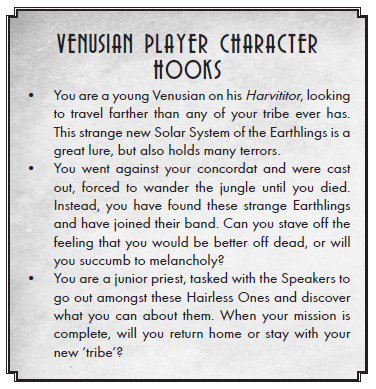
NEXT TIME, let's build some dang characters! I have an example from a friend of mine, but I'm looking for one or two suggestions for a character idea.
ATTRIBUTES AND SKILLS AND CHARACTER CREATION
Original SA post
ATTRIBUTES AND SKILLS AND CHARACTER CREATION
You know what attributes and skills are. I don't need to explain this, but I can elaborate on some new stuff. For starters, your attributes are also your health and you kinda don't want a 0 in certain skills. Let's get down to brass tacks. The game expresses that you should not just be a one-trick pony but a well-rounded PC with some areas you shine in.
The six Attributes are Awareness, Coordination, Ingenuity, Presence, Resolve and Strength. You have to have at least 1 point in each Attribute and they function as your health. When you take damage, it's directly applied to your relevant Attribute and it lowers it. I'll go more in depth later but damage isn't necessarily bullets and lasers, it also includes insults, embarrassment, getting drunk or flubbing your words. For humans stats range between 1-6 though some alien templates will change these parameters and the human average for an Attribute is 3. When do you use an Attribute with a certain skill? It's a little like Maid: it depends on the circumstances and your approach to the problem. Awareness+Technology is a good way to pin down what a machine's problem is, but it doesn't necessarily mean you're going to fix it; that might be Ingenuity+Technology.
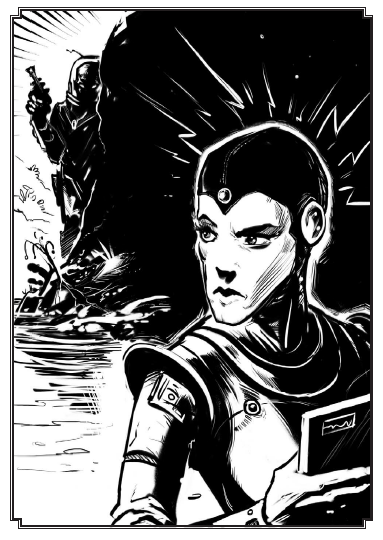
Laser tag like the Solar System has never seen before.
Awareness is for clue-hunting, perception, spotting enemies and seeing through environments.
Coordination is for shooting, jumping, balancing, piloting and dodging.
Ingenuity is raw talent at intellectual tasks, how well you can reason and how well you can apply your raw brainpower.
Presence is raw social talent and how well one can apply it in negotiations, fast-talking or intimidation.
Resolve is how strong your will and confidence is, providing you backbone while also giving you the strength to resist manipulation and psychic powers.
Strength isn't just strength but it's also physical fitness and endurance. Low strength can be from sickness but it can also be from being out of shape.
There are only 12 skills, which is honestly a relief compared to skill-heavy games. Skills are specific applications of raw ability and you can have skills range from 0-6 normally, but multiple skills with 4 are better than a few with 6+. If you have 0 in a skill, you can roll an Attribute only but you have no specific idea what you're doing. If you have a 3 in a skill, you can get an Area of Expertise, a tightly specific field where you also get +2 to the use of that skill (think Pistols or Ancient Martian Technology or Flying Rockets).
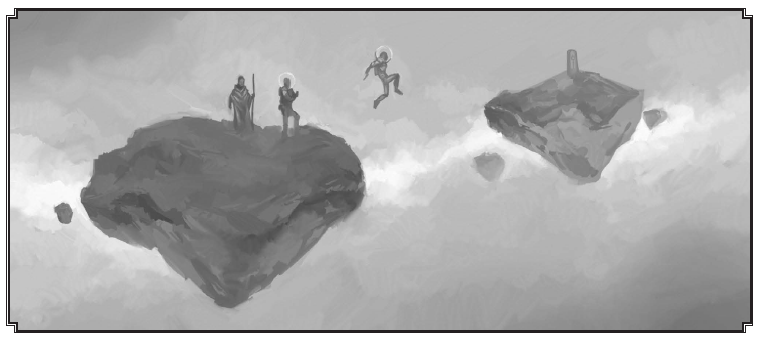
https://www.youtube.com/watch?v=6KK14lsnUyE
Athletics is used for specific types of physical activity or applying specialties beyond "lift" or "dodge". If it's not in a combat sense and it's physical, it's Athletics. You'll generally see it used with Coordination or Strength but I've watched plenty of anime where the protagonists use Resolve+Athletics or figure out an opponent's technique with Ingenuity+Athletics.
Convince is a skill that's generally resisted with Resolve or Ingenuity. It's used for fast-talking, intimidating, seducing or trying to talk your way out of a problem. Presence+Convince is pretty common, but Ingenuity+Convince would make sense for laying down a logical argument and Strength+Convince is good for browbeating someone with flexing.
Craft is for creating something that's less on the high-tech side of things and more on the artistic side of things. Craft is used for sewing, making Martian sand art and painting but it can also be used for performing dances, music or plays. A Martian Courtesan can get a lot out of Craft. Coordination+Craft is good for using your body to make art, Ingenuity+Craft is good for using your mind or using your head to think about someone's creation and Awareness+Craft is good for raw appraising.
Fighting is fighting. Yup. Fighting is resisted with Fighting unless they're just dodging your attack, that's Athletics. You're probably going to use Strength or Coordination for your own style and weapon unless you want to use Awareness or Ingenuity to read an opponent's style and find openings like Sherlock Holmes would.
Knowledge is learnin' that's not covered by Medicine, Science or Technology. Knowledge represents general education (or more specific) and you also get 1 free language for every level of Knowledge. Most of the time you're going to use Knowledge with Ingenuity or Awareness.
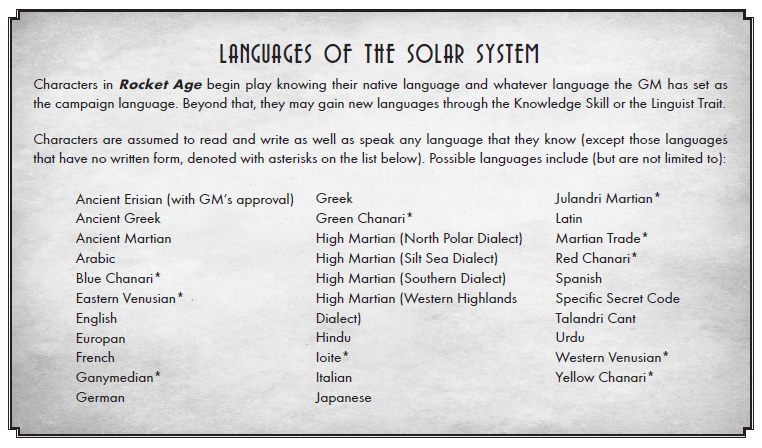
The color of the Chanari Tribes doesn't literally refer to their skin color like it would with John Carter. Chanari Tribes go by the Color Animal name scheme.
Marksman is for shooting real good or throwing things. You can resist with Athletics. You're probably going to use Coordination with Marksman but you could also use Awareness for bypassing cover/finding and reading your target or Ingenuity if you're going to try to plot a path through an area or use a high-tech weapon.
Medicine isn't just for healing the body. It's used for healing the mind and finding clues on bodies as well. Coordination and Medicine would be good for a surgeon, Awareness is good for finding clues but most of the time it pairs well with Ingenuity for first aid or psychotherapy.
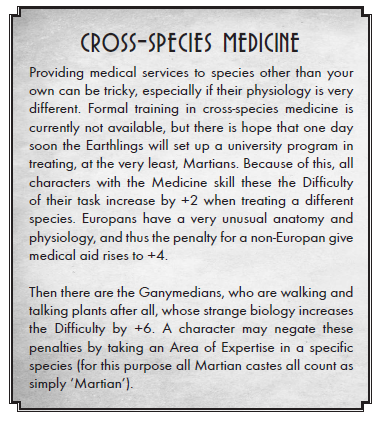
Science makes anything possible! There's a lot of overlap with Medicine and Technology but Science is generally used for theories and solving mysteries. Most of the time you'll be using Ingenuity or maybe Awareness with Science.
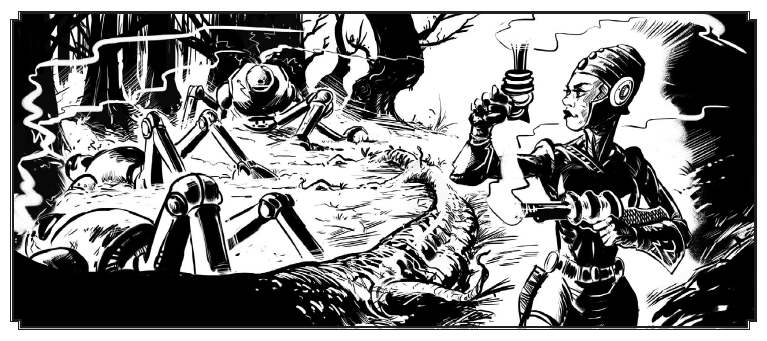
Looks like she got some War Walkers tickets to the gun show.
Subterfuge is for sneakin' and thievin' or for knowing how someone would do those things. The game notes it to be a rare skill because most of the people in space aren't likely to be a petty criminal...or maybe that's what you just think. Coordination is good for lock picking and sneaking, Awareness is good for finding traps and Presence is good for tapping the criminal underworld for info.
Survival is handy because the solar system is a dangerous place and you need food and water to survive. Awareness pairs well with Survival for tracking and reading the environment and Ingenuity is good for finding what you need to live.
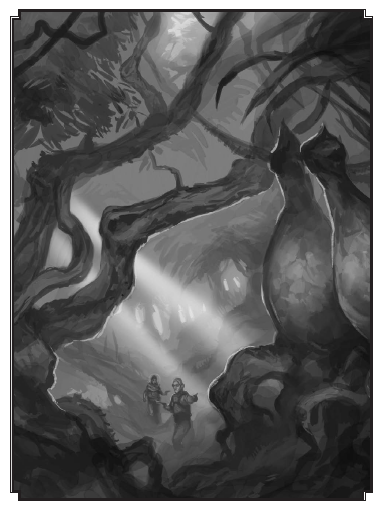
In search of food on Venus.
Technology is needed for repairing and using certain high tech items, like radium engines or radar. This doesn't cover invention, that falls under a Trait you can take. Most of the time you'll need Ingenuity or Awareness for Technology.
Transport is the driving stat and generally needs Coordination. Not too much fancy here, all the fancy stuff comes from being able to fly a rocket ship.
CHARACTER CREATION
There's a bit more to character creation that I haven't shared yet but that's because they're heavy on info and would require putting off character creation. Creation is a four step process and every character has a pool of 42 character points to spend on Attributes, Skills, Traits, Species Package and Occupation Packages. Species and Occupations have varying costs but it's always 1 point per level of Attribute, Skill or Trait and you can only get up to 6 points back from taking negative Traits.
1: Pick a Species.
2: Pick an Occupation.
3: Spend points on Attributes, Skills and Traits
4: Figure out equipment, background, personality, etc.
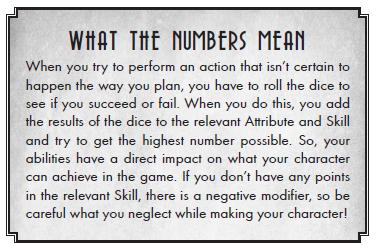
So James sits down with Caleb and they both crack open their books to figure out a character for Caleb to play. He wants to play a French archaeologist with an interest in the artifacts of the Crater so the first two steps resolve themselves quickly. Human costs 1 point and gives Friends (Minor Good), Explorer fits the archaeologist theme and gives +2 Awareness, +1 Resolve, +2 Survival, +1 to Knowledge, Marksman, Science, Technology and Transport and gives the Traits Brave (Minor Good), Insatiable Curiosity (Minor Bad), Keen Senses: Pick One (Minor Good), Lucky (Minor Good), Sense of Direction (Minor Good) and Obsession (Minor Bad) for 12 points.
Now it's up to him how he wants to spend the 29 remaining points. Characters have to have 1 in every Attribute, so that costs 4 points, but he wants them to have a minimum in 3 in each stat. Overall that costs 18 points and adjusts the cost to 11. Boosting Athletics to 2, Knowledge to 3 (with a specialty in archaeology), Marksman to 2 and Science to 2 costs 6 points total. To get an extra point, he gives his Explorer the Trait Argumentative (Minor Bad). With the remaining 6 points, he boosts Keen Senses to Keen Senses: All (Major Good), Resourceful Pockets (Minor Good), Fighting Man or Woman (Minor Good), Linguist (Minor Good) and boosts Coordination by 1 more point.
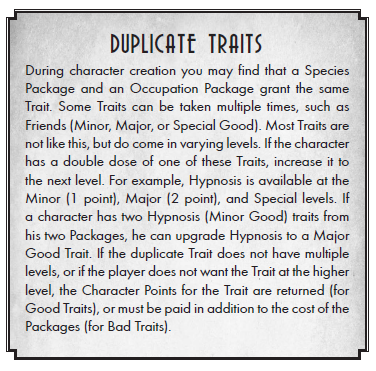
Caleb comes up with the name Sybille Dupree, two-fisted archaeologist with an interest in cutting edge technology. Normally, she would have her pick of the litter for equipment; the game offers player characters whatever would be reasonable for their characters to have for free. If she was to have a simple rifle, Caleb could just write the stats for a rifle on the sheet. You can spend Story Points in character creation to buy certain items, though. This doesn't reduce the total of them for good, it just removes them from the bank before they start play. For equipment, Caleb spends 1 Story Point to give Sybille a Light RAY Gun, Rocket Ranger Space Armor for 2 Points for defense and 4 Points for a Rocket Pack to get around Venus for a grand total of 7 Story Points. Let's see what Sybille Dupree looks like:
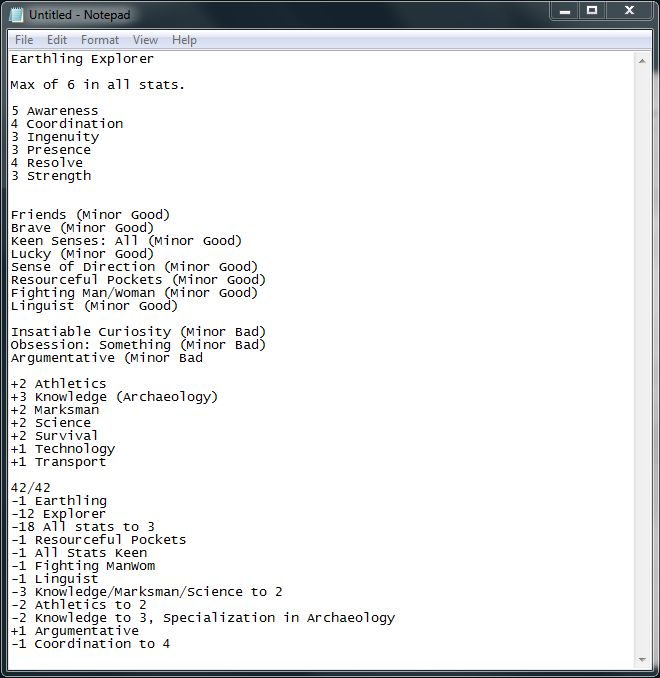
Not too shabby! She can hold her own in a fight pretty well and is well on her way to unlocking the secrets of Venus.
For a suggested character design, MJ12 said "Venusian Master Troll". Well you're in luck MJ12: the Diplomat Occupation recommends that if you play this Occupation as a Venusian, you're likely a Priest. And if you're a Priest, you got that way by being argumentative as hell. Let's put this character together, shall we?
First, pick your species: Venusian for 10 points.
Awareness: 1, Coordination: 1, Ingenuity: 0, Presence: 0, Resolve: 0, Strength: 2
Alien Appearance (Major Species Bad), Climbing (Major Good), Empathic (Minor Good), Impulsive (Minor Bad), Keen Senses: All (Major Good), Natural Weapons (Minor Good), Psychic Training (Minor Good), Swinger (Minor Good), Tough (Minor Good).
Second, Occupation: Diplomat for 14 points. Because Diplomats also get Empathic and it's not a Trait that has more than one level, one point gets refunded to 13.
Awareness: 2, Coordination: 1, Ingenuity: 1, Presence: 1, Resolve: 1, Strength: 2
Convince 2, Knowledge 1, Subterfuge 1.
Alien Appearance (Major Species Bad), Charming (Minor Good), Climbing (Major Good), Empathic (Minor Good), Friends (Major Good), Impulsive (Minor Bad), Keen Senses: All (Major Good), Natural Weapons (Minor Good), Obligation (Minor Bad), Owed Favor (Major Good), Psychic Training (Minor Good), Swinger (Minor Good), Tough (Minor Good), Voice of Authority (Minor Good).
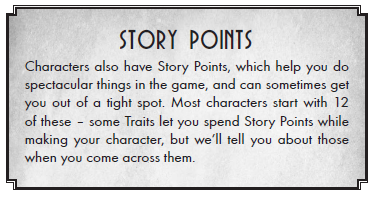
Third, let's throw some points around. The nice thing about character creation is that because you've picked an Occupation, you get some of the Traits you'll need to do what you need to do. I don't need to spend too much more of my remaining points on more Traits outside of personal preference.
Awareness: 3, Coordination: 3, Ingenuity: 2, Presence: 4, Resolve: 4, Strength: 4
Convince 3, Fighting 3, Knowledge 2, Subterfuge 1, Survival 2.
Alien Appearance (Major Species Bad), Charming (Minor Good), Climbing (Major Good), Empathic (Minor Good), Friends (Major Good), Impulsive (Minor Bad), Keen Senses: All (Major Good), Natural Weapons (Minor Good), Obligation (Minor Bad), Owed Favor (Major Good), Psychic Training (Minor Good), Swinger (Minor Good), Tough (Minor Good), Voice of Authority (Minor Good).
Fourth and finally, background. This Venusian Diplomat has been called Silverback enough times by visiting humans the name's sort of stuck for human visitors. He's a Priest and as such he's an accomplished, practiced speaker who can still gut a Thunder Lizard with the rest of his Tribe. Because he speaks English, he's a skilled go-between for humans and Venusians and his new French friend is in dire need of his help. She wants to explore the Crater with her new jetpack and she needs his help keeping the other Conclaves off her back so she needs Silverback's help. I'm not going to pick out equipment.
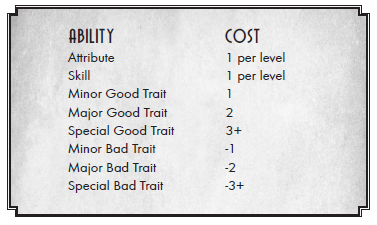
SILVERBACK
Awareness: 3, Coordination: 3, Ingenuity: 2, Presence: 4, Resolve: 4, Strength: 4
Convince 3, Fighting 3, Knowledge 2, Subterfuge 1, Survival 2.
Alien Appearance (Major Species Bad), Charming (Minor Good), Climbing (Major Good), Empathic (Minor Good), Friends (Major Good), Impulsive (Minor Bad), Keen Senses: All (Major Good), Natural Weapons (Minor Good), Obligation (Minor Bad), Owed Favor (Major Good), Psychic Training (Minor Good), Swinger (Minor Good), Tough (Minor Good), Voice of Authority (Minor Good).
NEXT TIME: OCCUPATIONS
OCCUPATION PACKAGES
Original SA post
OCCUPATION PACKAGES
Occupation Packages are actually somewhat optional; you can just take the points after picking your species and spend them however. The big benefit of the packages is to cover the basics of what you want and then use the leftovers to shape and nudge your character design. It does a pretty good job of that! Some of these occupations are restricted to species or origin.
Citizens are, well, citizens who have gotten access to the stars or are just the common populace of where you’re focusing on. For Earthlings, good examples would be journalists, the wealthy going on adventures or bums heading to the stars to find a new life. Human citizens might be making a life on Venus or Mars working at Roosevelt Station or stamping papers in a Martian principality. Most lower caste Martians like Craftsmen or Slaves make good citizen characters as well.
Citizens get +1 to any Attribute, +1 to Convince, Craft, Knowledge and Subterfuge and the Traits Face in the Crowd (Minor Good), Friends (Minor Good) and Owed Favor (Minor Good). The package costs 8 points.
Diplomats are anyone who leave their planet to make contact with the other worlds for peaceful purposes. Venusian priests can also count as diplomats, as can Martian Priests or Europans who aren’t necessarily Emissaries.
Priests get +1 to Awareness, Ingenuity, Presence and Resolve, +2 to Convince, +1 to Knowledge and Subterfuge and the Traits Charming (Minor Good), Empathic (Minor Good), Friends (Major Good), Obligation (Minor Bad), Owed Favor (Major Good) and Voice of Authority (Minor Good) for 14 points.
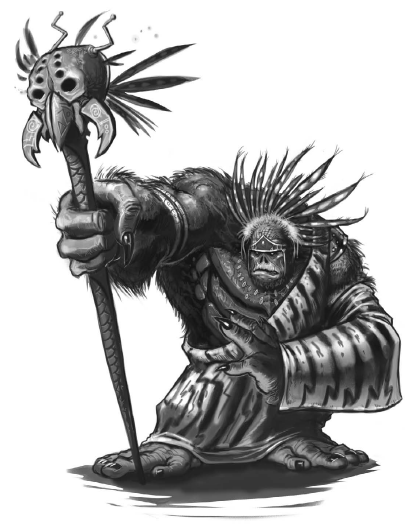
Venusian Priest up in this motherfucker.
Explorers are out there to find what needs to be found. This is one of the most common occupations in the Solar System, either backed by someone or paying out of their own pocket. Maybe you’re working for a corporation, maybe you’re working for a college or maybe you just want to discover the secrets of Mars and Venus.
Explorers get +2 to Awareness and +1 to Resolve, +2 to Survival and +1 to Knowledge, Marksman, Science, Technology and Transport and the Traits Brave (Minor Good), Insatiable Curiosity (Minor Bad), Keen Senses (Minor Good), Lucky (Minor Good), Sense of Direction (Minor Good) and Obsession (Minor Bad) for 12 points.
Merchants are going to get rich in the stars by selling fuel to people who need it, selling sneakers to the Martians and selling picks to the miners. There are a lot of big companies working in the stars already but there’s still plenty of space for small startups to carve out a niche to themselves. This is also the perfect occupation for Martian Merchants.
Merchants get +1 to Ingenuity, Presence and Resolve, +2 to Convince and Transport, +1 to Craft, Knowledge and Subterfuge and the Traits Charming (Minor Good), Empathic (Minor Good) and Wealthy (Minor Good) for 13 points.
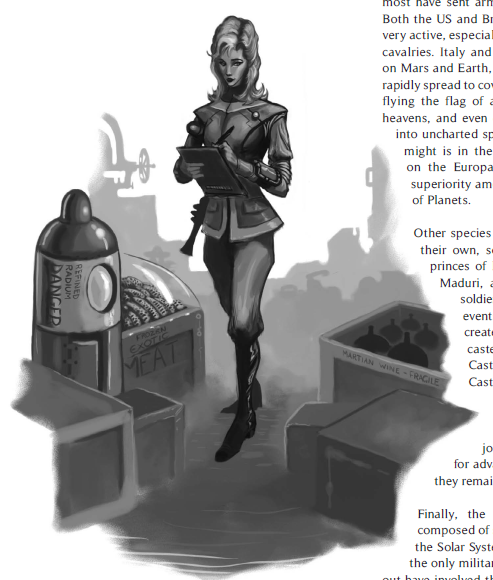
Sellin' sand to the Martians.
Military can be from any planet or any culture: Italian fascists soldiers, US Army, Martian Royals who have an officer rank or Europan officers. There are some more specific occupations that will be covered later: Rocket Ranger, Deutsche Marskorps War Walker, Martian War-Priest. The book claims that the Maduri Warrior occupation is included here but it, uh, isn’t! It already has info for playing as a Warrior and the Martian Warrior species just plain pairs well with Military.
Militaristic characters get +2 to Coordinate and Strength and +1 to Resolve, +2 to Marksman, +1 to Athletics, Fighting, Subterfuge, Survival and Transport and the Traits Brave (Minor Good), Friends (Minor Good), Fighting Man/Woman (Minor Good), Tough (Minor Good) and one of the following: Obligation (Minor Bad), Outcast (Minor Bad) or Phobia (Minor Bad) for 15 points.
Miners/Scavengers have some overlap in skills and abilities but they’re different roles. Miners are trying to make a buck while Scavengers are trying to survive *coughIoitescough*. You’re likely to see Martian (mainly Chanari), Ioite or Human miner/scavengers.
Miner/Scavengers get +2 to Awareness and Resolve, +2 to Craft and Survival, +1 to Technology and the Traits Gadgeteer (Major Good), Keen Senses (Major Good), Impoverished (Minor Bad), Outcast (Minor Bad) and Resourceful Pockets (Minor Good) for 11 points.
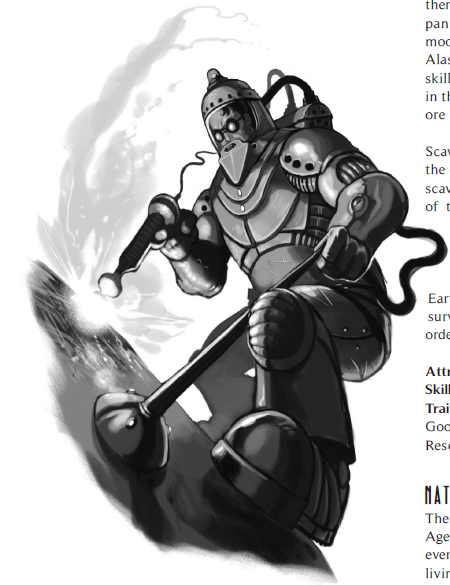
Mine now!
Natives are like citizens but with less of a coherent governmental system. The Chanari, Ganymedians, Ioites and your average Venusian are good examples of natives.
Natives get +2 to Awareness, +1 to Coordination and Strength, +1 to Athletics, Craft, Fighting, Marksman, Subterfuge and Survival and the Traits Brave (Minor Good), Fighting Man/Woman (Minor Good), Primitive (Major Bad) and Technically Inept (Minor Bad) for 9 points.
Scientists are here for Science!, the exclamation point mandatory. Go out and study some stuff in the field.
Scientists get +2 Ingenuity, +1 Awareness and Resolve, +3 Science, +2 Technology, +1 Knowledge and Medicine and the Traits Gadgeteer (Minor Good), Man/Woman of Science! (Major Good), Obsession (Minor Bad) and Technically Adept (Minor Good) for 15 points.
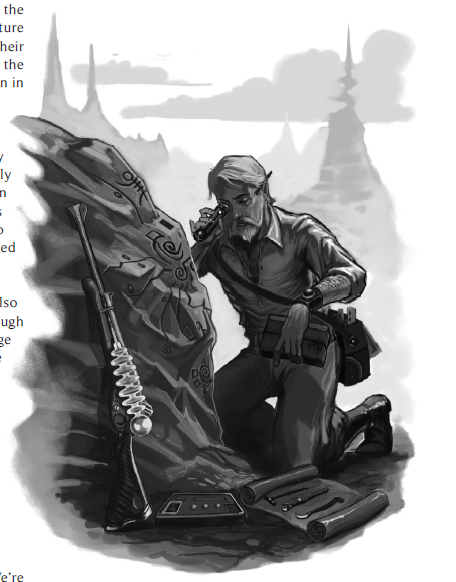
I have no idea what I'm doing.
Law Enforcement is for solving crimes but in space. Outside of Earth, policing among humanity comes down to military presence or frontier justice by marshal. Martian police are generally specially trained Warriors, Venusians don’t really have law enforcement asides from what the tribe will choose to do as a whole and the Europan navy might be their law enforcement but nobody knows. Generally speaking, if you’re going to play a Law Enforcement character, you’re either a sheriff-type or some kind of military officer if you’re human or a Martian Warrior Cop. Or maybe there’s Space Pinkertons, who knows?
Law Enforcement characters get +2 Awareness and Resolve, +1 Coordination and Presence, +2 Convince, +1 Athletics, Fighting and Marksman and the Traits Code of Conduct (Minor Bad), Empathic (Minor Good, Friends (Minor Good), Obligation (Minor Bad) and Voice of Reason (Minor Good) for 10 points.
Europan Emissaries are Europans who volunteered to be Emissaries, a job that’s a mixture of spy, anthropologist and diplomat. Your people altered your mind to make you forget/misremember the truth of Europa, gave you basic instruction on how to protect yourself and gave you info on the species of the solar system. You were then released into the world to collect data and retrieve it for your people and go amongst the lesser races. You also have a goo sac that records your memories and another goo sac that will destroy your body if you die. Both of these are installed in your torso.
Emissaries get +2 Awareness, +1 to Ingenuity, Presence and Resolve, Convince +2, +1 Knowledge, Medicine, Science and Technology and the Traits Amnesia (Minor Bad), Insatiable Curiosity (Minor Bad), Obligation (Minor Bad), Psychic (Major Good) and Telepathy (Major Good) for 10 points.
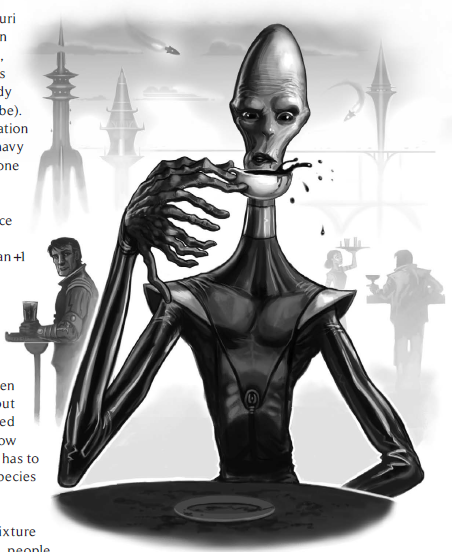
Not everything is Europan-friendly.
Deutsche Marskorps War Walker Pilots are Germans who survived being put in an Ancient Martian coffin machine that (without anesthetic) installed Ancient Technology into your body that lets you interface with gyroscopic Martian tech. You were one of the 60% who survived training (the other 40% wash out from not being good enough or from interface feedback) and you piloted for the Nazis for a while until you decided to leave the services of the Deutsche Marskorps and strike out on your own with your machine.
Let’s talk about the ramifications and implications of letting a PC play as an ex-Nazi! Rocket Age is aware of the seriousness of the war crimes of Nazi Germany and as a game where the PCs are generally good people think it’s not really acceptable for you to have been complicit in them. This is so you don’t make the other players uncomfortable and so your history doesn’t overshadow the plot/make the game world darker. So, from a PC perspective, find a reason for your War Walker Pilot to have gotten away from Nazi Germany that doesn’t involve you having a dark and troubled past. At the very least, you should talk about your character with the other players and the GM. Okay? Okay.
War Walker Pilots get +2 Coordination, +1 to Awareness and Resolve, +2 to Transport, +1 to Fighting, Marksman and Technology and the Traits Fighting Man/Woman (Minor Good), Item (War Walker: Panzerspahlaufer or Laufpanzer) (Special Good), Neural Interface (Minor Good), Obligation (Major Bad) or Adversary (Major Bad) and Quick Reflexes (Minor Good) for 14 points.
Martian War-Priests are basically any Martians who end up serving the Order of the Sacred Hamaxe in a war band, either as a Priest or as a hanger-on. So while the majority of War Priests are, well, Priests there's still a chance for a Laborer to count as one. The warriors of the Order are the knights-errant of Mars, believing that all Martians are equal (but your job is important) and that all evil should be destroyed. You might not be on the best terms with humans as a result.
War-Priests get +2 to Coordination, Presence and Resolve, +1 to Awareness and Strength, +2 to Fighting, +1 to Athletics and Survival and the Traits Code of Conduct (Major Bad), Fighting Man/Woman (Minor Good), Item: Hamaxe (Minor Good), Obligation (Major Bad), Psychic (Major Good), Quick Reflexes (Minor Good) and Tough (Minor Good) for 13 points.
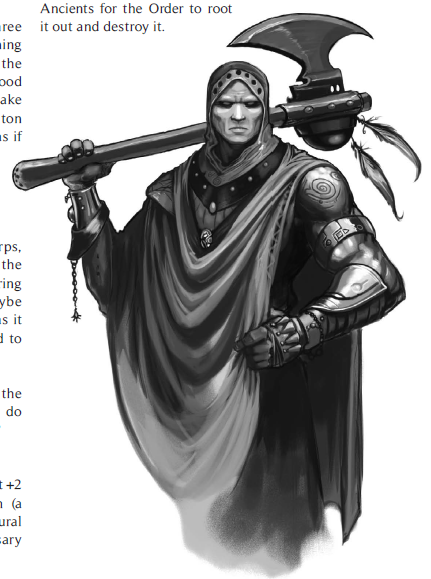
Yes, that is a Hamaxe on his shoulder. Yes, it's a hammer-axe. Yes, it belongs in Red Faction: Guerilla.
Rocket Pilots need a few qualities to be good at what they do: the ability to do complicated math quickly, nerves of steel, a keen eye and the kind of craziness reserved for people willingly piloting an atomic missile. You're the backbone of space travel and you don't let anyone forget it. The majority of rocket pilots are humans.
Rocket Pilots get +2 Coordination, +1 Awareness and Ingenuity, +2 Transport, +1 Marksman, Science and Technology and the Traits Impulsive (Minor Bad), Item: 3 points towards a ship (Special Good), Keen Senses: Eyesight (Minor Good), Quick Reflexes (Minor Good) and Rocket Man/Woman (Minor Good) for 11 points.
Rocket Rangers are the absolute best of the US Army, candidates who are under 25, American citizens, excellent bodies and minds, a good record in the forces and flying colors for a psychological/ethical screening. Then the hard part begins: learning to fly a rocket pack. They're in short supply and they have to learn to fight and survive in any environment but they're skilled at what they do.
Rocket Rangers get +2 Coordination, +1 Awareness, Ingenuity and Resolve, +2 Transport, +2 Transport, +1 Athletics, Fighting, Marksmen, Science, Survival and Technology and the Traits Code of Conduct (Major Bad), Fighting Man/Woman (Minor Good), Item: Mark III Rocket Pack (Special Good), Item: RAY Pistol (Minor Good), Item: Rocket Ranger Space Armor (Special Good), Obligation (Major Bad), Quick Reflexes (Minor Good), Rocket Man/Woman (Minor Good) and Voice of Authority (Minor Good) for 13 points.
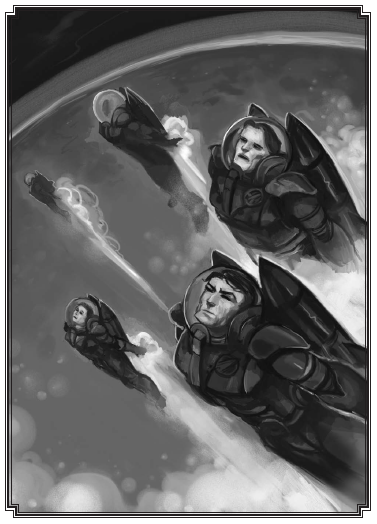
Mighty Flyin' Rocket Rangers.
Venusian Harvititoi are teenage Venusians in the throe of a natural occurrence. When they reach a certain age, they're overcome with an urge to explore and as a result have their own kind of Rumspringa. This can range from living with another tribe to wanting to explore the stars until one day they wish to return with their experiences and become adults. It's not a good thing for Harvititoi to never end in Venusian society.
Venusian Harvititois get +2 Coordination and Resolve, +1 Awareness, +2 Athletics and Survival, +1 Craft, Fighting and Subterfuge and the Traits Code of Conduct (Major Bad), Fighting Man/Woman (Minor Good), Insatiable Curiosity (Minor Bad), Item: Venusian Wood Axe (Special Good) for 10 points.
NEGATIVE TRAITS
Negative Traits are the lesser of the trait list but they have more of an impact on character and role-playing. You can only take up to six points worth in creation and they can also give story hooks. They can also get you Story Points if you give in to "what your character would do" within reason. Let's take a look.
Adversary (Minor/Major): Someone wants to hinder you or stop you and it's a very personal grudge, enough for them to butt in. On a minor level, they roughly appear in 25% of adventures and are built with the same amount of points you are. On a major level, they either are more powerful than you (+10 character and +4 story points for their creation) or they appear more often (about 50% of the time). This is something you should talk over with the GM, naturally.
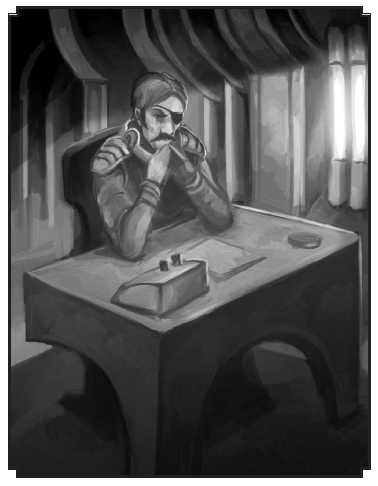
"How am I going to ruin my rival's day this month..."
Alien Appearance (Species Minor/Major): You look odd and have trouble interacting with prejudiced people or people who are unused to you. You can't hide your appearance with a disguise or a fake mustache either. You can still take Attractive or Unattractive. At minor, you have a -2 to social rolls with these people. At major, it's-4. Best way to get around it? Make friends!
Amnesia (Minor/Major): At a minor level, you're missing some period of time in your past (weeks, days, months). At major, you have total identity amnesia. The proper triggers might jog your memory which requires a Story Point and an Ingenuity+Resolve roll.
Argumentative (Minor): You like to argue. Not all the time, just when you think you're right or you think it's wrong to back down. This is a character flaw, not an actual disorder, and if you want to try to not argue it's an Ingenuity+Resolve roll.
By the Book (Minor): You feel like you have to follow instructions and order to the letter without deviation. You're not a completely inflexible machine, though: if you really need to say "screw the rules" and go against them, an Ingenuity+Resolve roll can help you and you get +2 to the result if people try to help talk you out of being by the book.
Clumsy (Minor): This is pretty under control most of the time unless it's kind of funny. In a stressful situation, though? Make Awareness+Coordination rolls to avoid knocking people/things over, tripping or bumping into people. Annoying, but I would totally say you could turn it into a good thing by barreling into an enemy.
Code of Conduct (Minor/Major): You live your life by a set of rules or guidelines. At minor, it's just a guideline that requires an Ingenuity+Resolve roll to break momentarily. At major, it's a code you live your life by, your bread-and-butter outlook, and requires a Story Point in addition to the roll to break it.
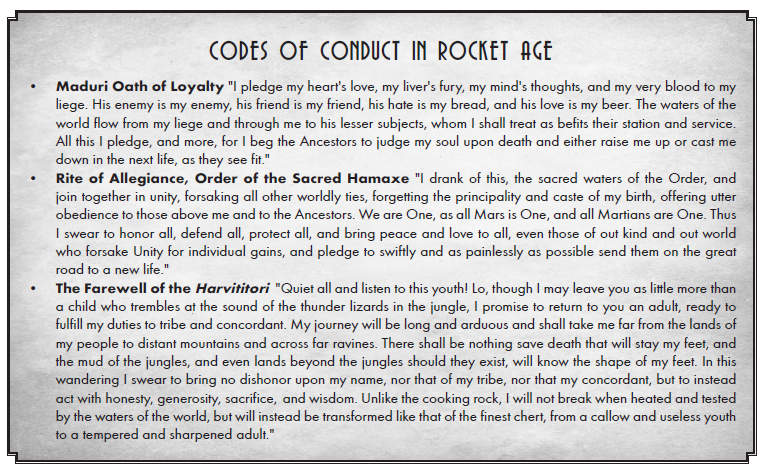
Cowardly (Minor): -2 to rolls when threatened with danger, injury or fear effects. You can still run away, defend yourself, call for help or otherwise try to get out of danger. So it might be -2 to crossing that rickety bridge, but if the bridge collapses and you're clinging to it, there's no penalty to climbing the thing and getting to safety.
Dark Secret (Minor/Major): This can't really be expressed mechanically, only through role-play and plot. If the secret is revealed, Minor means people may have bad opinions about you and Major may get in a lot of trouble. Sharing the secret doesn't make it go away either, it just makes it worse and makes it more likely to come back to haunt you.
Dependency (Minor/Major): You need something to live comfortably but it’s not necessarily an addiction, it could be something medical like insulin. At minor, it’s easily available and can be resisted with a Story Point and dice roll. At major, it’s a medical thing and you lose a point per Attribute per day until you can get it and then heal normally.
Distinctive (Minor): You stand out in appearance or behavior or mannerisms. Can’t be taken with the Face in the Crowd Trait. -2 to blending in a crowd or making a disguise and enemies have +2 to trying to find you.
Eccentric (Minor/Major): You’re quirky. At minor, you just have a certain way about you that doesn’t imply you have a mental illness. At major, you might appear crazy to people and it might inhibit your social interactions. TALK THIS OVER WITH YOUR GM IF YOU TAKE THIS, IT IS NOT AN EXCUSE TO BE A FISHMALK.
Enslaved (Major Species): You are/were being controlled by another as a slave (like a Martian Laborer). If freed, you have -2 to social rolls when asserting your own voice or opinion. Luckily, you can buy this off to signify your growth as a person.
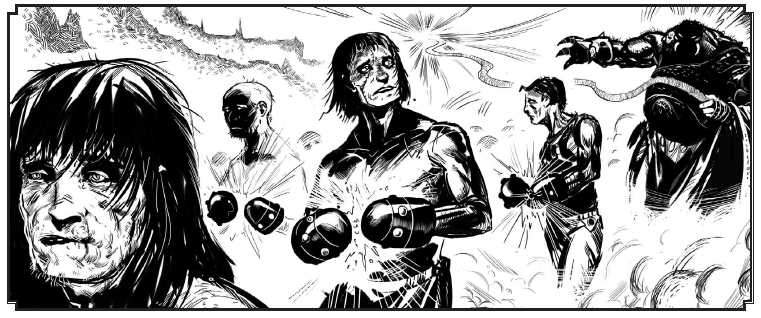
Life among the Laborer caste.
The Flowering (Species Minor): For Ganymedians only, this is what happens when you Flower. It’s normally tied to the seasons of Ganymede but hey, space is a weird place and there’s weather on other planets. To simplify, you get a Story Point for triggering this out of season, gain one personality Trait (Argumentative, Clumsy, Forgetful) for a little while and blossom (the pollen might trigger an annoying allergic reaction from your buddies).
Forgetful (Minor Bad): Make a roll to recall things when you really need to. If I remember more about this, I’ll add more later.
Frenzy (Species Minor): If substantially hurt or provoked and if the character fails a Resolve+Strength roll, the character rages. They will try to destroy/hurt the source of their pain and need to spend five minutes out of its sight to calm down. As long as you’re in frenzy, you are immune to pain unless you take enough to kill you. The hurt only takes hold when the frenzy wears off.
Immaterial (Species Major): Can’t touch this. Literally. You can only talk with telepathy or psychic powers and there’s not a lot of creatures who this Trait would apply to, so. You’re really good at hiding though.
Impaired Senses (Minor/Major): At minor, you have an impediment that can be overcome with corrective equipment OR a condition like color blindness or being unable to smell that gives you a -2 to Awareness with that sense. The major version is complete loss of a sense meaning it can’t be used for anything and should only be taken with GM permission. You can take Keen Senses but not Major and only if it’s for a different sense.
Impoverished (Major): You have trouble keeping money and even if you come into a windfall, debts or fate will keep you from keeping all of it. It’s a constant thing. You start play with your clothes and only a tool kit or a weapon or armor and you can’t buy the Item Trait.
Impulsive (Minor): You have behavioral issues and are, well, impulsive. If you give in to impulse at a dramatic moment, gain a Story Point. You can resist your urges with a Story Point and a roll.
Insatiable Curiosity (Minor): You can’t leave well enough alone. You have questions you want answers to and pursuing them is a good way to get Story Points. Or you can resist with a Story Point and a roll.
Obligation (Minor/Major): You’re part of a group and as a result you owe them your services. At minor, you have to repay a small debt or your duties aren’t so big or your whole party is part of the same group. At major, your membership impacts your free time, where you can go and what you can do.
Obsession (Minor/Major): You’re passionate about something, be it Ancient Martian Technology or Venusian Lizards. Minor obsessions are personality quirks/strong interests but you still might make some bad decisions to chase them (which you can resist with a Story Point and a roll). At major level, it’s more of a mad fixation and nothing can stop you which make it more fit for NPCs or villains. This is, uh, not something you should ever take on a major level and it should just be counted as minor if it’s assigned from your occupation.
Outcast (Minor): You’re not allowed in a certain group anymore and have -2 to social rolls dealing with them.
Owes Favor (Minor/Major): You’re in debt and it can be simple or complex. For minor, the debt is less than $3000 (probably not a good idea, roughly 50K in 2016 inflation) or a favor or aid. For major, the debt is bigger than that. It might not be resolved, it might not come up a lot, but the debt needs to be paid attention to sometimes.
Phobia (Minor): -2 to any rolls involving your phobia. You can still take the Brave trait, it’s just a crack in your armor and Brave doesn’t help against it.
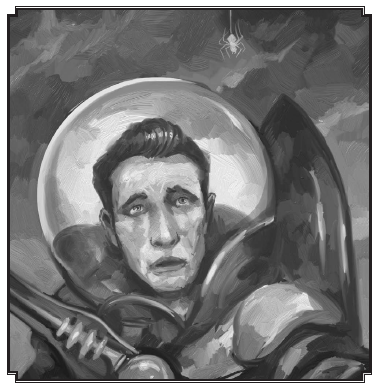
Look I'd be scared of space spiders too.
Primitive (Major): You’re Technically Inept plus you can’t take the Technology skill and -2 to any other skills using anything more advanced than Iron Age technology. Bows and arrows? Fine. Guns? Trouble.
Selfish (Minor): Less “fuck you, got mine” and more “what’s in it for me?”. You can use this (and use it properly, not to be a dick) to make the story more dramatic and gain story points but if you have to overcome it, you can with a roll and a Story Point.
Slow (Minor/Major): You’re out of shape, have an injury or just unable to go fast. As minor, your speed is halved and rounded down (minimum 1). As major, you can’t move without help (like a wheelchair). Maybe you’re paralyzed or just don’t have legs or something. There’s rules for using a wheelchair and you can get around normally except for combat or chase scenes.
Slow Reflexes (Minor/Major): This only applies for action rounds. For minor, you always go last in a round regardless of initiative. For major, there is a second action round after the primary round for people with Slow Reflexes. So it’s like “okay, all of the normal characters have Done A Thing. Now it’s time for the Slow Reflexes Round”.
Technically Inept (Minor): -2 to using or repairing high tech items and you can’t take Gadgeteer, Rocket Man/Woman or Technically Adept.
Unadventurous (Minor/Major): You shouldn’t take this during character creation, this is “you’ve been playing this character for a while and want to retire them/give them an out”. At a minor level, your heart’s just not really in it. At a major level, you’re only around out of obligation to your friends and take -2 to things that take enthusiasm or might put you in danger, a “one last job” sort of thing.
Unattractive (Minor): There’s just something about you. -2 to social rolls where your looks would matter.
Unlucky (Minor): Thematically, you’re just kind of unlucky but not in the "spank me harder, GM" sense. Mechanically and in actual execution, double sixes is normally an auto-success but instead you reroll and take whatever results. If it’s another double sixes, well then the success stands.
Weakness (Minor/Major): You have an allergic reaction to something. At minor, it’s -2 to all rolls when exposed or if it’s an active weakness. At major, take 4 levels of damage upon exposure.
You may have noticed that some of these Negative Traits are not worth getting 1/2/3 points back for other uses. You may have noticed that some of the ones you get assigned from your species or occupation are really either just personality traits or plot hooks. This is pretty intentional; the game is designed for your heroes to be more heroic than your average realistic character and they kept away from the types of negative traits that you can just ignore or are just wildly impractical. Because you can only take up to 6 points at character creation, you’re kind of limited from gaming the system by doing things like taking “Relative: Elderly Grandmother” and spending the first session putting her on a one-way boat to New Zealand. The major levels of these traits shouldn’t be taken so lightly either, so is it really worth the extra points or would you just want to get better and get more from actually playing the game? Hint: you want to just play the game and not get so hung up on min-maxing your character.
NEXT TIME: All the good traits.
POSITIVE TRAITS
Original SA post
POSITIVE TRAITS
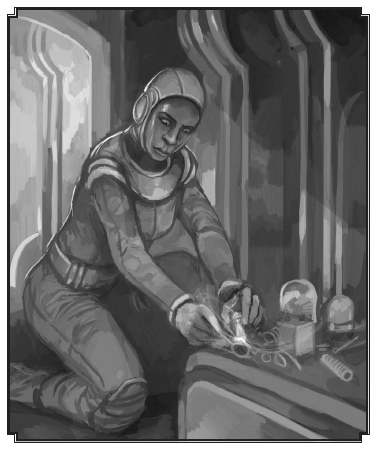
I dunno what this is but it's in this chapter so here.
Additional Limbs (Species Minor Good): You can take this multiple times for each set of limbs for the price of 1 point per limb set (and it can be tentacles, prehensile tails or whatever). Extra legs? +2 base speed. Extra arms? One extra free action in the Action Round. These bonuses can only be gained twice, so after 4+ arms or legs there’s no extra mechanical benefits.
Alien Organs (Species Minor/Major/Special Good): At minor, your guts are a bit different and lower damage taken from physical attacks, poison, disease or psychic attacks by 2. At major, that damage is lowered by 4 plus you can’t be targeted by called attacks to specific parts. Special level means that your alien biology gives you a bonus that isn’t covered by any other trait, like Ganymedian organ transplant shenanigans.
Alien Senses (Species Minor Good): +4 to awareness rolls with a specific sense like ultraviolet or infrared or sonar vision.
Animal Friendship (Minor Good): +2 to rolls to pacify animals that don’t know you or are afraid of you and general +2 to any skill rolls involving animals (except attacking them).
Astral Projection (Psychic Major Good): Requires Psychic, Psychic Training. Free your mind, man. It costs a Story Point to detach and become Immaterial. You know what Astral Projection is and you know you don’t want your comatose body to die while doing this.
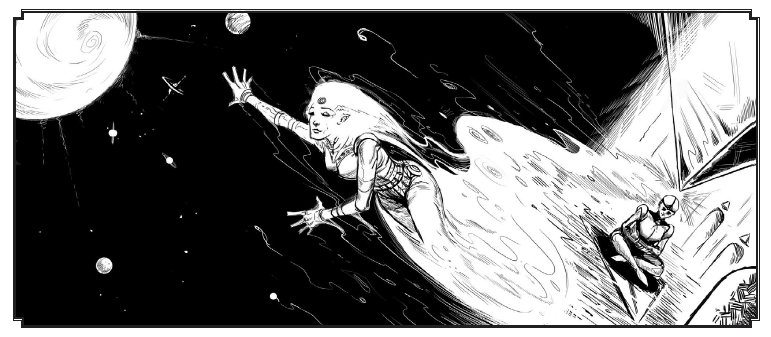
Psycho-astronaut.
Armor (Species Minor/Major/Special): Natural armor! 5 points at minor, 10 at major but -1 Coordination, 15 at Special with -2 Coordination and you can keep pumping points past Special to trade -1 Coordination for 5 more Armor. Note: natural armor does not protect against beam weapons.
Attractive (Minor Good): You just have a good way about you, not necessarily looks but just a physical sort of way. +2 to social rolls where how you look could help you.
Aura (Psychic/Species Minor Good): You have a strange feeling that emanates from your body and soul. You have to pick the feeling (besides fear) and people around you need to roll to resist feeling that feeling when you turn it on. You can totally pick [MENACING] if you want, I’d allow it.
Brave (Minor Good): +2 to any roll where courage plays a factor. You can still take this with Phobia. This may sound like it’s specific, like it’s for resisting fear rolls (which is true). But it takes courage to stand up for what’s right, or jump from a sinking silt skimmer or punch a Warrior in the jaw. This is a handy trait.
Burrowing (Species Minor Good): You can burrow at half of your speed through soft materials and you can keep your tunnels open with a Story Point.
Charming (Minor Good): +2 to any social interaction rolls.
Clairvoyance (Psychic Major Good): Requires Psychic, Psychic Training. Spend a Story Point to use Clairvoyance at a level dictated by your Resolve, but you can make a roll to increase range/direction. Normally it’s just sight but Story Points can be spent to add extra senses.
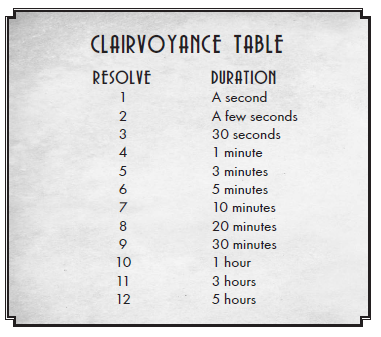
Climbing (Minor/Major Good): At minor you can climb things that shouldn’t have traction (glass) with +4 to Athletic and Coordination while doing it. At major you can just stick to stuff and climb horizontal surfaces or surfaces that shouldn’t be climbed (plus the +4s).
Dowsing (Psychic Minor Good): Requires Psychic, Psychic Training. Turn it on with a Story Point and then roll to find things.
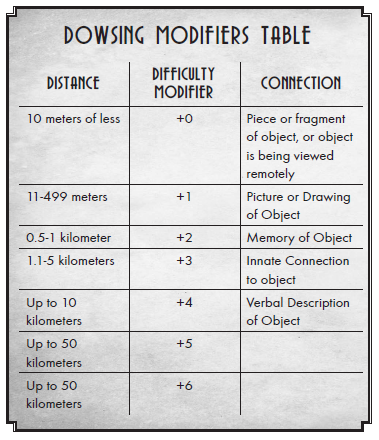
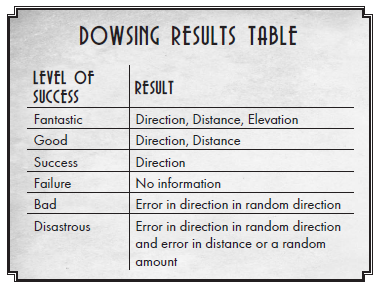
Empathic (Minor Good): +2 to reading emotions, detecting lies, piercing disguises or just providing a sympathetic ear.
Environmental (Species Minor or Major Good): At minor, you’ve got some weird alien thing that protects you from all harmful environmental circumstances in one type of environment (like space). At major you’re protected from all environmental hazards because of a suit or something.
Experienced (Special Good): Trade your max pool of Story Points for Character Points at character generation only, 3 Story for 4 Character. You can take it multiple times but it might just be worth it to keep it untouched and get the points through play because Story Points are useful.
ESP (Psychic Major Good): Requires Psychic Training. Detect psychic powers around you, spend a Story Point to detect all intelligent life forms around you or spend a Story Point to read a person’s species/history/mood/etc.
Face in the Crowd (Minor Good): Blend in as long as you act like you belong there or just play it cool. You also get +2 to Subterfuge to avoid detection.
Fast (Minor/Major Good): Minor gives you x1.5 to your speed and Major doubles your speed.
Fast Healing (Major/Species Special Good): At Major, you regain 1 lost Attribute point per hour with a plausible explanation (like being robust and healthy or having augmented abilities). At Species Special you regain 1 point per minute with no explanation because you’re an alien.
Fighting Man/Woman (Minor Good): You can take a free action or reaction in the Combat Phase in addition to your normal action. This can be an attack, dodge, parry or other combat thing. This is very useful to have if you break skulls and I’ll explain why later because there are Rules To Combat and this gives you a good edge in fighting.
Flight (Species Minor/Major Good): At minor, you can fly at half of your Coordination up to 100 meters high. At major, it’s 3xCoordination speed and the sky’s literally the limit.
Friends (Minor/Major/Special Good): Friends are contacts! They act as a source of research/intel to help investigate but won’t necessarily actually join the PCs. At minor, the Friend is a reliable, low-level source of information. At major, they’re more reliable and more powerful and can feasibly offer material help. At special, they’re probably running their organization and can be reliably used for info and resources.
Gadgeteer (Major Good): Make things! You can make a thing you need temporarily for the cost of the Story Points you’d need to buy it (so 4 to build a jetpack) but it’s temporary and it’ll break or run out of power and the Story Points will be returned. To build something existing permanently or a new item, it has more specific rules I don’t want to get into but you have to spend those Points permanently until you earn more.
Hypnosis (Minor Good/Psychic Major/Special Good): You don’t need training for Minor but Major/Special needs Psychic Training, Psychic and Telepathy. All levels need rolls to hypnotize people. Minor gives +2 to social rolls and calm people and implant a limited/short term suggestion for a few minutes. Major trait suggestions last for days and can be stronger/more dangerous suggestions. Special gives even longer suggestions and control over people that can become complete control.
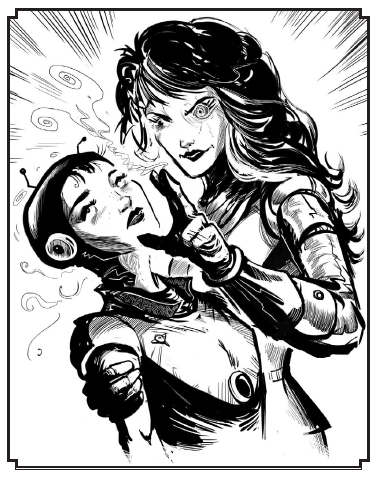
Mind-taking! Oooooeeeeeeoooo.
Immortal (Species Major Good): Never age or suffer the effects of aging! This also includes never getting cancer which is…interesting to say the least (also dementia). You can still die though, just not from age.
Immunity (Minor Good/Species Major Good): Do not take damage from a specific source. At Minor, it’s a specific substance like arsenic or spider venom. At Species Major, it’s a broad category like Poison.
Indomitable (Major Good): +4 to resisting possession, hypnosis, psychic suggestions or social scenarios trying to get you to do bad things.
Infection (Species Major/Special Good): Infect beings with a condition that changes them into your species. There are rules for the infection but at Major your infection will just turn them into your species and at Special (4 points) they’re your species but you also control and dominate them mentally.
Item (Special Good): Spend Story Points and shrink your max pool to get items.
Keen Senses (Minor/Major): At minor, +2 to perception for one specific sense. At major, +2 to all senses.
Linguist (Minor Good): Start play knowing your language, the campaign language, two other languages, two languages per point of Knowledge and you can learn new languages by spending Story Points.
Lucky (Minor Good): If you roll double ones, get a free reroll. You have to take the second roll, even if it’s double ones again.
Man/Woman of Science! (Major Good): +2 to any Science skill roll. More importantly, you can spend a Story Point to substitute your Science skill for any other skill for one roll. Quite handy, feel free to technobabble your ass off.
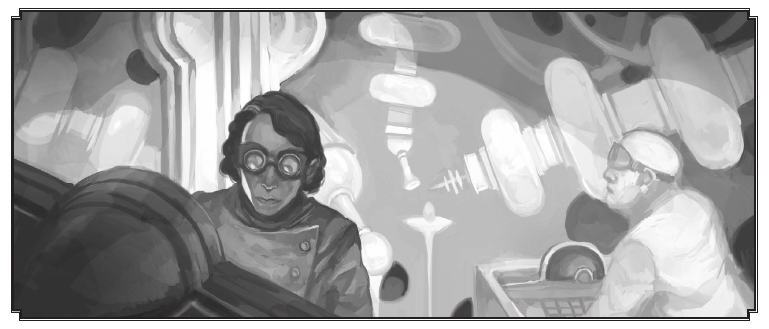
Science!
Natural Weapon (Species Minor/Major Good): Minor can be taken multiple times and give you a new weapon each time that deals +2 damage or increases the existing weapon’s damage by 2. For major, the weapon becomes ranged, gaining a 2/4/7 damage spread and a range of 10 meters. Taking major multiple times can either add a new weapon, increase an existing weapon’s base damage by 5, or add 10 more meters to the range.
Networked (Species Minor/Major Good): Hive mind! With minor, the character can sense anyone linked to them within 100 meters and they can all coordinate to act on the same Action Round. At major they can actively communicate with each other, know plans, status, senses within 100 meters and get +2 to all rolls when they’re 10 meters next to 2 other networked members.
Neural Interface (Minor Good): You got Ancient Martian tech installed in you by a German scientist or a scientist in general. This is mainly used to pilot War Walkers because otherwise you just can't but it may also have some other uses with other Ancient Technology.
Night Vision (Species Minor Good): See in the dark with no complications.
Owed Favor (Minor/Major Good): You can cash in on debts owed, small amounts for minor and big efforts for major. The game recommends using Owed Favors as adventure rewards, which is a pretty nice idea actually.
Photographic Memory (Major Good): Perfect recall, aka "you can ask the GM to repeat some pertinent plot info if you said that your character memorized it". If you don't memorize it, it costs a Story Point to recall.
Photosynthetic (Species Minor Good): You need a minimum 4 hours of sunlight exposure a day and water to be satisfied.
Possess (Psychic Special Good): Take over people with your Special Brain. I won't go into the mechanics. Requires Psychic, Psychic Training, Hypnosis and Telepathy.
Postcognition (Psychic Major Good): Requires Psychic Training, Psychic, ESP. Use Story Points to read the pasts of items.
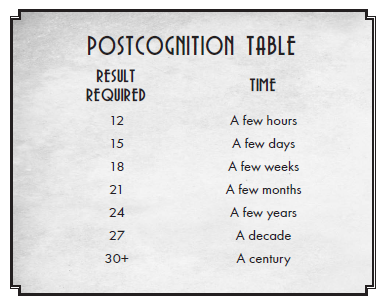
Precognition (Psychic Minor Good): Requires Psychic Training, Psychic, ESP. You get random glimpses of future events or can actively have a vision for 1 Story Point. No mechanics here, refreshingly straight-forward.
Psychic (Major Good): Requires Psychic Training. Read minds with a Story Point and a roll, learn and develop psychic powers, +4 to resisting psychic attacks/abilities.
Psychic Training (Minor Good): This is basically learning how to protect yourself from psychic powers. +2 to resisting psychic abilities. This bonus is replaced if you become Psychic.
Quick Reflexes (Minor Good): If you're not surprised in an Action Round, go first in your phase. If you are, act normally and then act first in your phase. This will make more sense later but it's a good thing to have, Quick Reflexes are always a good thing.
Regeneration (Species Minor/Major/Special): Heal physical damage faster and better. Why does this exist when Fast Healing exists? Because this is a trait for species only. Minor heals 1 damage per day and 2 for total rest. Major heals 1 damage every 12 hours, 3 per day of rest and can regrow lost limbs in days. Special heals 1 damage every Action Round and regrows limbs in hours.
Resourceful Pockets (Minor Good): This is the "pretend I prepared for this scenario and it's just in my character's backpack" trait. Pay 1 Story Point or roll the dice and get a useful item on doubles.
Robot (Species Special): Beep boop! It's meant as a gateway trait to buying Equipment Traits for yourself and you're immune to biological effects and psychic powers plus you can raise Attributes over 6, but you're inhuman, you have to be repaired to heal and you can't be psychic. There's more about playing robot characters in Heroes of the Solar System but those are Martian robots, this is just for general robots.
Rocket Man/Woman (Minor Good): +2 to any rolls involving flying/driving any kind of rocket-powered vehicle.
Run for Your Life! (Minor Good): When you gotta beat feet, +1 to speed.
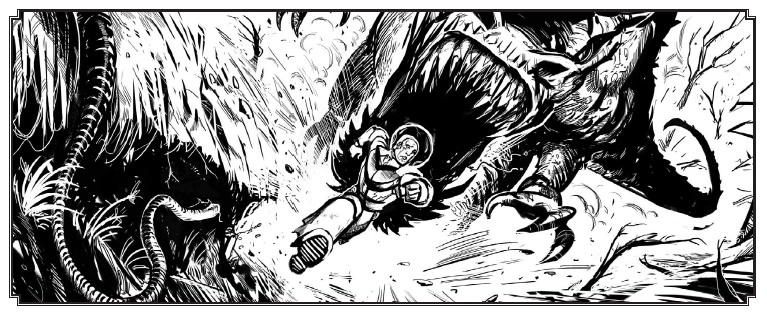
Thunder Lizards are a lot less scary from miles away.
Screamer! (Minor Good): When you're scared or threatened, you can flex your lungs and scream hard enough to stun everyone in the room for a round, giving them -2 to all actions. You can't ever take the Brave Trait or gain bonuses to resist fear, though.
Sense of Direction (Minor Good): +2 to rolls involving all forms of navigation.
Shapeshift (Species Minor/Major/Special): Anything with Major or Special are the result of Ancient Martian, Erisian or Europan technology or science. At minor level, you can mimic the physical form of another species, but it can be seen through and you can't do anything special they can do. At major, the mimicry is perfect and you can do stuff like fly, but getting cut open will expose the ruse. At special level, you can mimic specific people and nearly any species.
Size (Minor/Major Good/Bad): At minor good, you're bigger than a Venusian. At major good, you're bigger than a T-Rex. At minor bad you're as big as a big dog and major bad makes you as small as a rat.
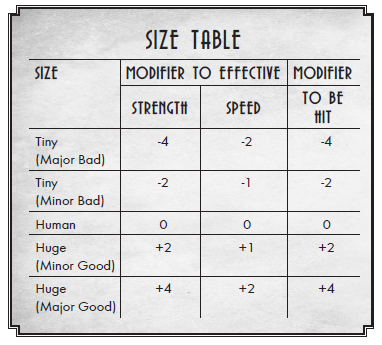
Swinger (Species Minor Good): +2 to swinging from place to place.
Technically Adept (Minor Good): +2 to using or repairing high technology items or Gadgeteering.
Telekinesis (Psychic Major Good): Requires Psychic Training and Psychic. You can lift things with your mind with ease (your Resolve acting as your Strength for lifting), but using your mind to attack people requires the expenditure of a Story Point.
Telepathy (Psychic Minor Good): Telepathy transmits thoughts. Words can only be conveyed if you share the same language and it's tricky to share what you're thinking to people who don't understand your worldview.
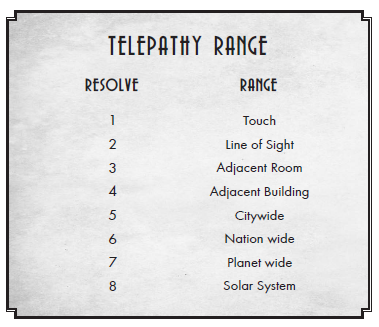
Tough (Minor Good): After damage dealt to you is calculated (after armor and all that), subtract 2 from the final total.
Voice of Authority (Minor Good): +2 to rolls involving Presence and Convince when you're giving orders, asserting authority or trying to get people's trust.
Wealthy (Major Good): You can reasonably afford most items on the item list PLUS you get 3 Story Points worth of items. This Trait generally means that you're going to be well-off for play and regain it through means if it goes away, and if you ever have to lose your money permanently you get a Character Point refund, which is nice.
So you might have noticed that some of these Species traits don't line up with any other alien species thus far. Well, there's plenty of room in the Solar System for new creatures so they're there to help you build your own or help the GM build them. Plus, as previously mentioned, if you take an Occupation you normally get a bunch of Traits that will help you do what you want to do right off the bat. There are still plenty of other handy traits to take though.
NEXT TIME: The equipment chapter! I'll pretty much be going over everything you don't see on Earth.
EQUIPMENT
Original SA post
EQUIPMENT
There is quite a lot to the equipment of Rocket Age, so I’ll mainly go over the things not native to Earth. Let’s begin!
Melee Weapons
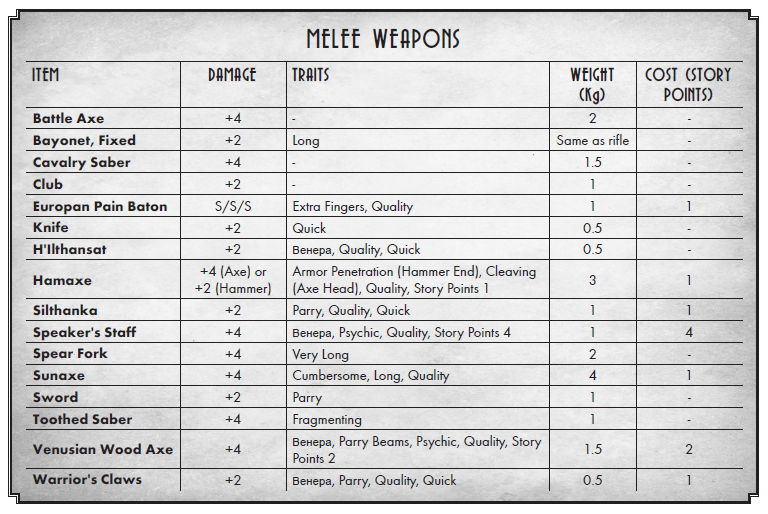
Europan Pain Baton: When Europans have to engage in hand-to-hand, the pain baton is what they go to. It’s a collapsible baton that goes from pocket-sized to a meter and a half long with a flick. In addition to the physical pain from a strike, the baton stimulates the pain neurons from the point of impact to encompass the whole body.
H’Ilthansat: This unpronounceable weapon is a dagger carved from a horn or fang or tusk from a Venusian beast and given to a Venusian on their wandering. It’s a symbolic weapon in addition to being functional; non-Venusians should not have one without a good reason, a Venusian carrying one is granted hospitality by rival tribes and they can ask their hosts for help. At the end of their wandering, the dagger is destroyed in a fire. It’s dishonorable to return home without it.
Hamaxe: The Hamaxe is a combination hammer and axe held in high regard by Martian Priests and Warriors that focus on ceremony and tradition. It’s a wooden staff with a heavy metal head that looks somewhat like Red Faction Guerilla sledgehammer, a true weapon for Martians/space assholes.
Silthanka: The Silthanka is a traditional Martian Priest weapon. It’s a precious-metal inlaid sword like a cavalry saber that is passed down from Priest to Priest.
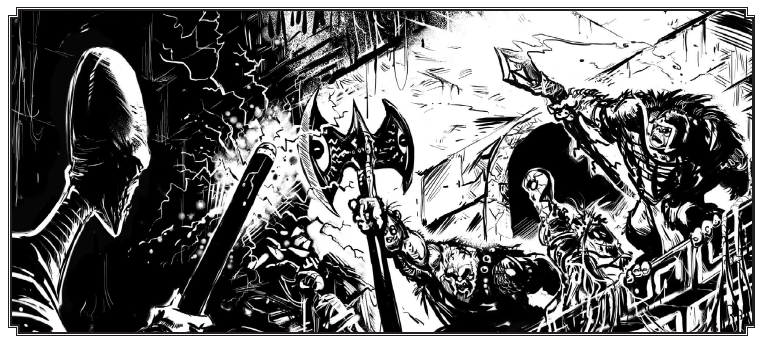
Speaker’s Staff: The staff is a carved Venusian branch that has a blue-green Venusian crystal tipping the branch. The crystal is capable of storing and releasing energy generated by swinging the staff or absorbing sunlight. The energy is released by striking the crystal in a series of tones, the release depending on the cut of the crystal or its composition. Exploring the tones of your crystal is vital for the growth of a Venusian Priest.
Spear Fork: The Spear Fork (not to be confused with the Spork) is a Martian Warrior cavalry weapon or a traditional female Warrior defense weapon. The two tine spears flanking the main spear can be customized depending on need. Female Warriors act like squads of pikemen with the spear fork while cavalry ride bahmoots and use the spear for charges and guerilla strikes.
Sun Axe: A Martian Warrior weapon, a gigantic dual-headed axe used by Warriors who will go on to be palace guards or traditionally holy warriors.
Toothed Saber: A Martian weapon carved from scrub brush wood turned into jagged wooden swords that break off splinters into their enemies and cause infection and aggravated wounds. Normally a Warrior weapon, it’s been leaked to the rest of Mars and is now used by Chanari raiders or pirates.
Venusian Wood Axe: A Venusian axe made out of wood decorated with Venusian crystals that attract or deflect energy beams like a magnet.
Warrior’s Claws: Stone Wolverine claws for the Venusians. Very hard to make.
RANGED WEAPONS
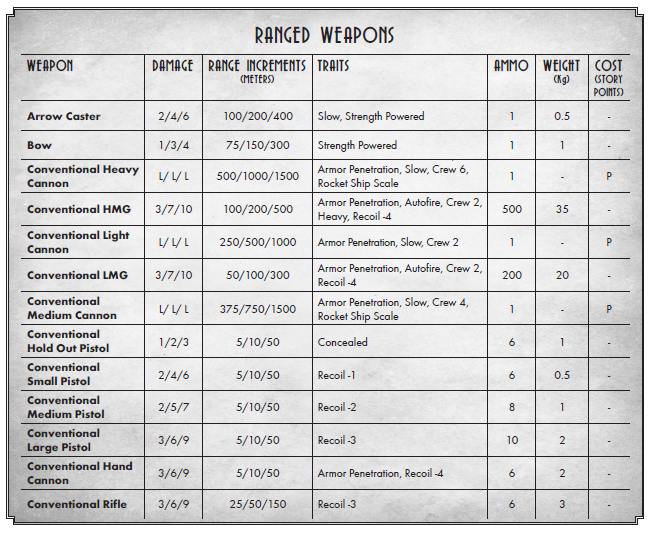
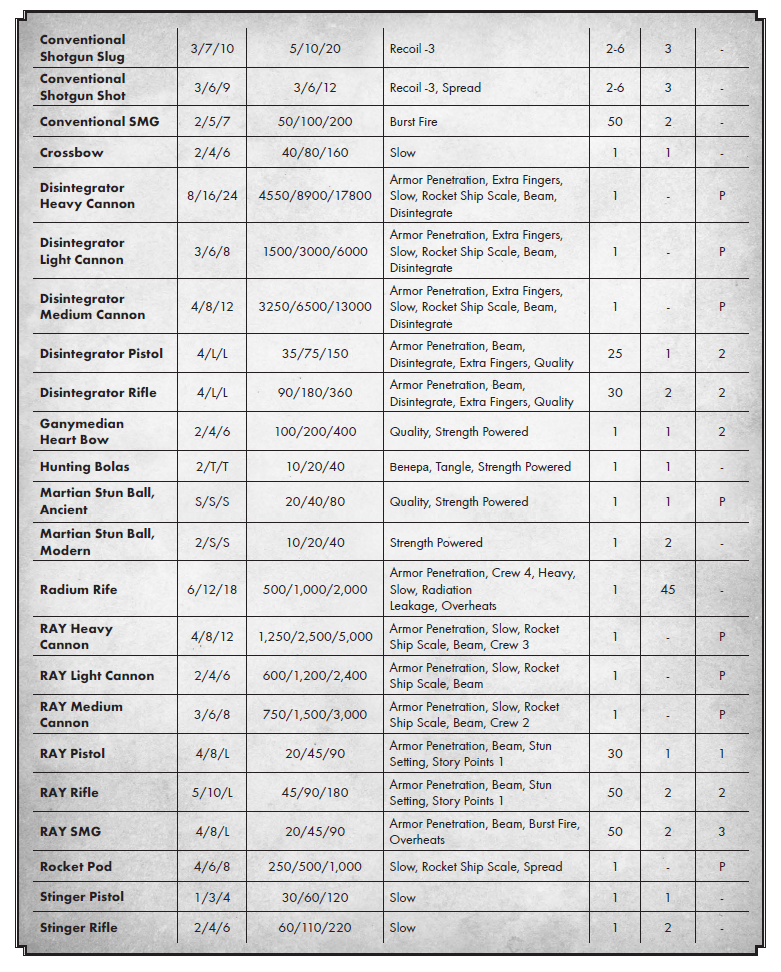
Arrow Caster: A ranged Warrior weapon made to replace bows due to the scarcity of wood. The Arrow Caster is a treated leather band that you step on and use your body as a frame for a bow and draw wooden arrows back with your free hand. Basically imagine making a C with your foot as the bottom and your off-hand as the top.
Europan Disintegrator: Lose a limb on a glancing shot or totally evaporate on a sure hit with a shot from a disintegrator beam. Pistols cause bits of flesh to disappear; a direct shot is survivable with medical attention. Rifles kill and take limbs. Cannons are ridiculously dangerous and easily destroy buildings and vehicles.
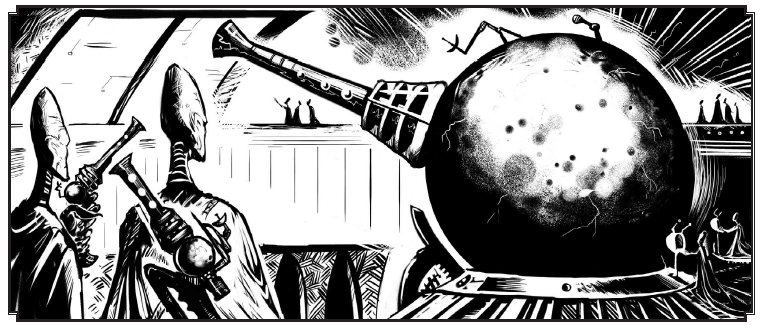
Ganymedian Heart Bow: A heart bow is created when a Ganymedian refuses the normal funeral process and is instead converted into a bit of solid wood. This bit of wood is then carved into a bow, an accurate and deadly weapon.
Martian Stun Ball: Imagine a jai alai scoop mounted on your arm, your arm inside of the scoop. Imagine whipping a grapefruit-sized ball at someone with your arm-scoop and both the ball and scoop track the target to make it home. That’s the Martian Stun Ball. It also comes in a non-powered version with a wooden scoop and rubber balls.
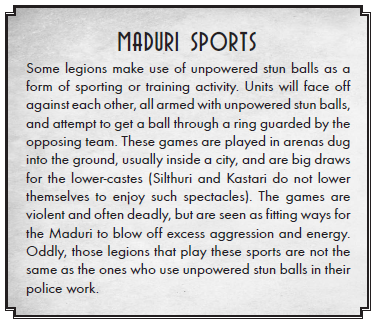
Radium Rifle: The Radium Rifle is a semi-scavenged half-remembered conglomeration of Ancient Martian technology and Martian duct tape keeping it running. The radium rifle is an artillery weapon that needs two Warriors to operate and carry it or a bahmoot to pull it and a fast Warrior who can dismount and fire the gun. It fires an accelerated slug that lands with a hard thud. They also bleed heavy heat in between shots, making them more suited as defensive weapons that deal crazy splash damage.
RAY Guns: Tesla’s RAY weapons are reverse-engineered from Ancient Martian technology into phasers, basically. They can stun or kill and the color of the beam indicates what’s being shot. They come in Pistol, SMG, Rifle or Cannon designs.
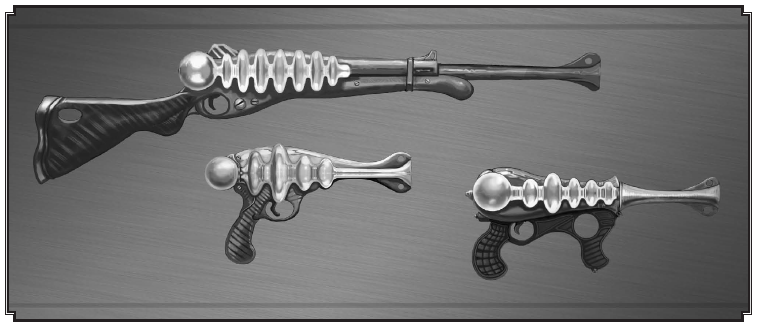
Stinger Weapons: Gas-propelled weapons designed for fighting in Jupiter. Stingers fire either short arrows or crossbow bolts.
BODY ARMOR
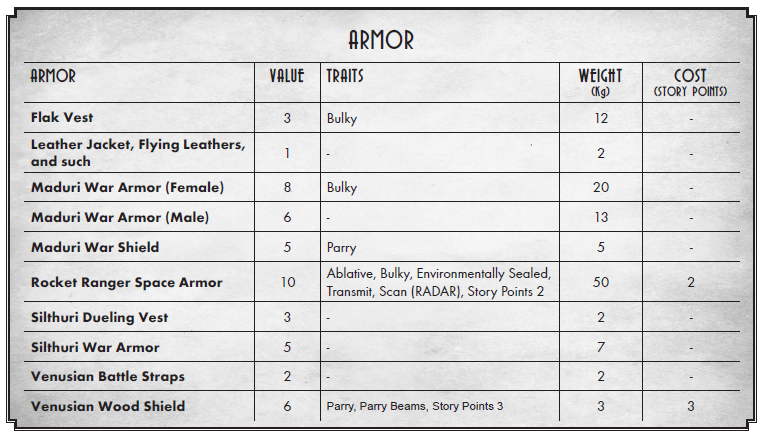
Maduri War Armor: War Armor is made out of plasteel, essentially. It’s weak to heat but strong to blunt, piercing or sharp attacks. War Armor is traditionally melted down and reworked and poured to make new armor for another Warrior. It’s also ended up in the hands of a lot of humans who’ve looted the dead or traded with Warriors for their armor. Generally they don’t like to see humans wearing it.
This same material is also used to forge Maduri War Shields and Silthuri Dueling Vests (for non-lethal duels) or Silthuri War Armor.
Rocket Ranger Space Armor: Made of Martian War Armor material and aluminum, the RRSA is hard to puncture or damage and light enough to get out of in a jiffy (but still sort of clunky).
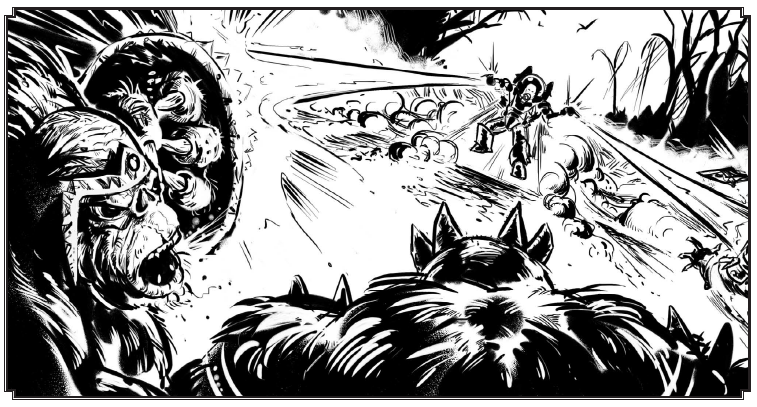
Venusian Battle Straps: Leather straps that go around their torso for protection and to harden their skin. They can come with shell/plate armor but that’s not really honorable.
Venusian Wood Shield: A small buckler with crystals studding the wood that acts like the axe does.
VEHICLES:
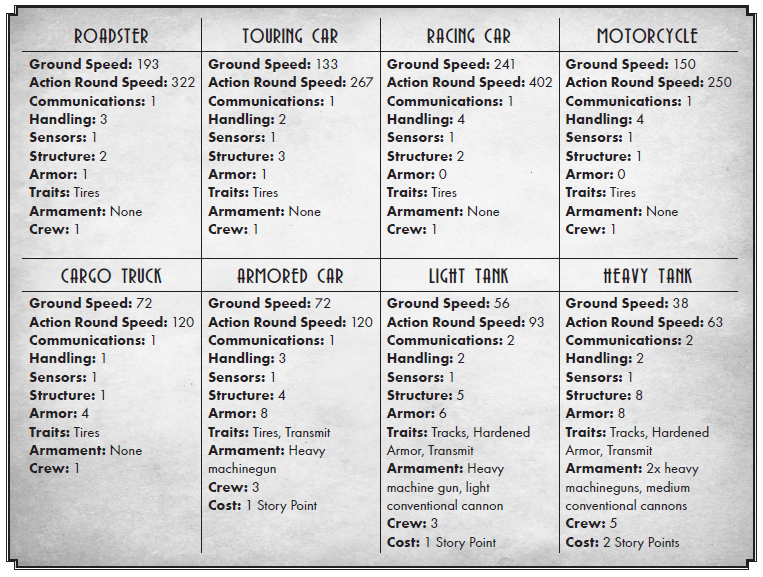
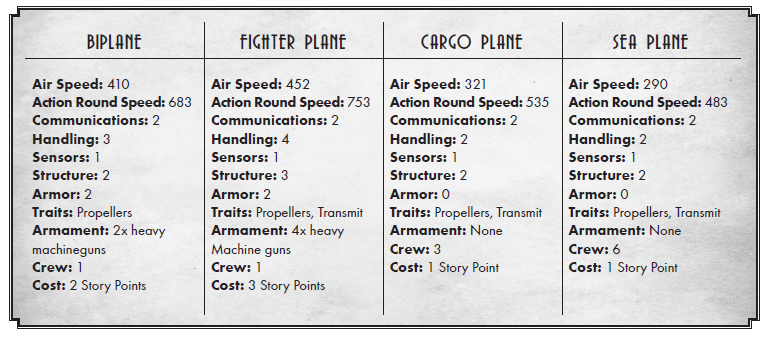
Rocket Car/Sled: The Rocket Car is a rich man’s toy. It looks cool, it goes fast, it’s completely impractical to actually use. They’re car-shaped rocket ships. The rocket sled, on the other hand, is a lot more useful especially on planets with low oil content. It’s a platform on a rocket with a cab, no atmospheric/flight capability but good for going from asteroids back to the ship or skimming the Ore Fields of Venus.
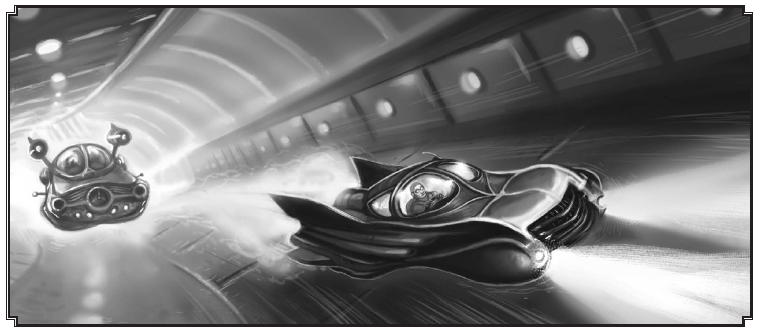
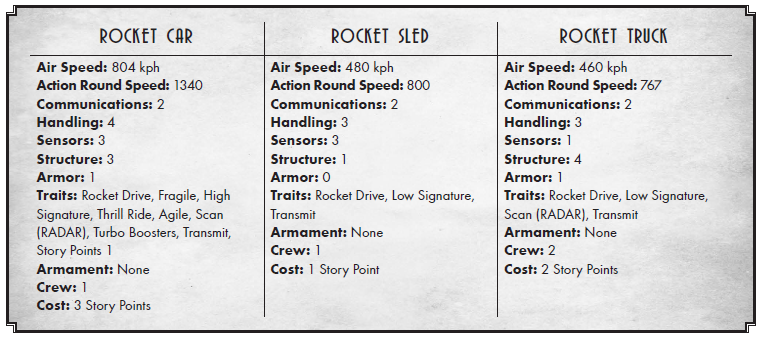
Rocket Pack: The Mark III is the gold standard for personal flight, developed in Los Alamos from Martian technology. The Mark I and Mark II were failures and their test pilots will be missed. You absolutely need a suit to protect you from flying because you absolutely can fly in space and to planets. It’s bulky, it’s fragile, it’s fast and it runs on a special radium fuel.
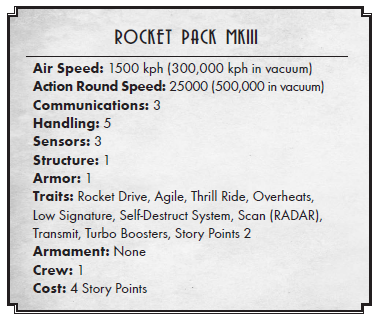
War Walker: The Deutsche Marskorps War Walkers come in four variations but they all need a pilot with neural implants to function. Without that integrated pilot, it can and will fall over if it takes more than a step. The first two are meant for PC use if they choose the War Walker occupation. The Panzerpahlaufer is the two-legged military humvee of the War Walkers. It seats the pilot, two crewman and a radio operator/gunner, armed with four machine guns and has a glaring weakness in a front glass canopy. Perfect for ferrying the other PCs around! The Laufpanzer is a one-man War Walker, a four-meter-tall humanoid walker with two arms that can be equipped with guns or other tools. The Panzerschreiter is four-legged and the workhorse tank of the Nazi forces, equipped with a RAY cannon, rocket pod and machine guns. It seats five: driver, commander and three gunners. The Sturmschreiter is a weapon to surpass Metal Gear, an eight-legged spider tank that requires a crew of ten soldiers: two drivers operating in sync, a commander and seven gunners. It has four 45mm cannons, two rocket pods and a buttload of mounted machine guns. It’s also slow and awkward and has two gigantic weaknesses: the legs are weak and can only be so armored and killing one pilot will either kill the other from psychic feedback or the strain of piloting an ungodly huge Nazi war machine alone.
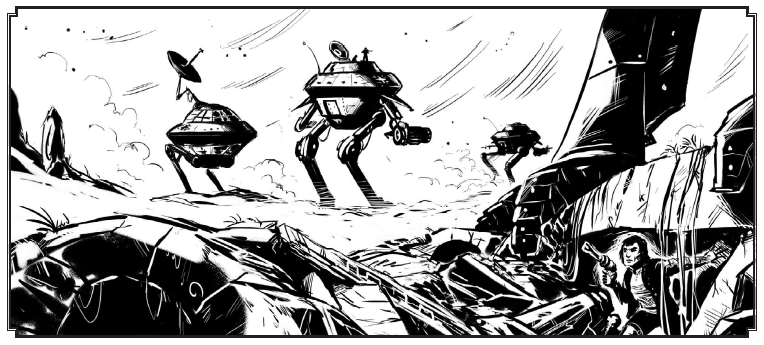
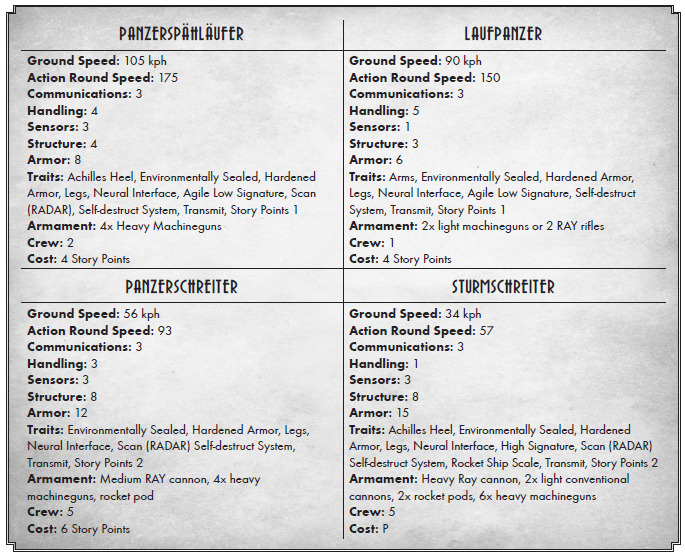
ROCKET SHIPS
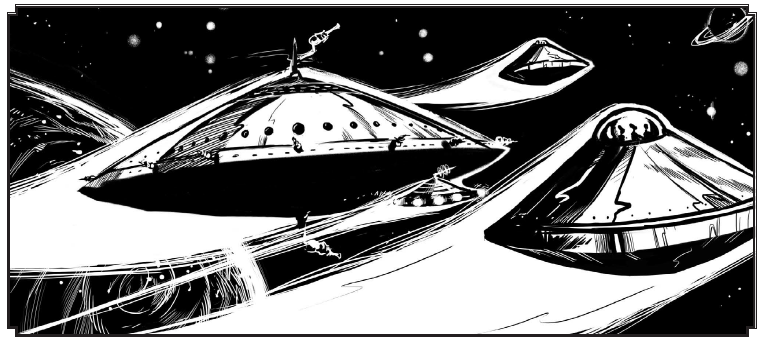
I’m going to be giving you a quick overview of the rocket ships because goodness gracious there are a lot created by country or planet. I’m sorry, I really do not want to just bog this down with all of the info about rockets. If they’re not an Europan Flying Saucer, they run on a radium drive engine. The Europan Flying Saucer most likely runs on rainbows, haughtiness and bear farts. They need life support, a good hull, communications gear, landing gear and a place to sleep. Also weapons (mostly RAY cannons). Yeah. Uh. I can’t go deeper into this; that would be madness. I will provide some details for some ships.
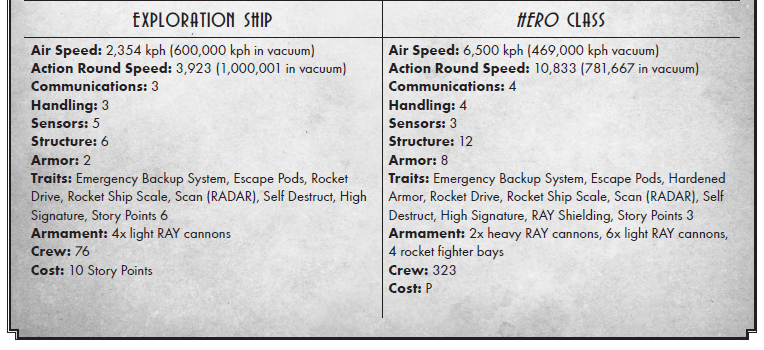
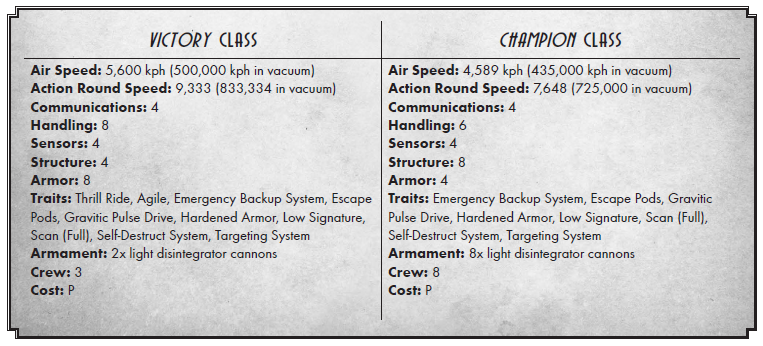
ANCIENT MARTIAN TECHNOLOGY
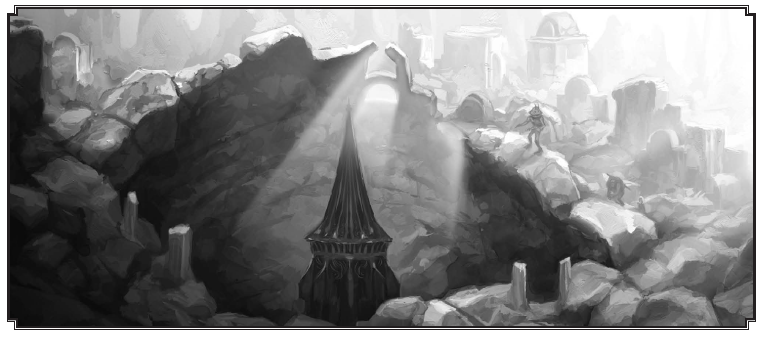
Ancient Radium Rifle: No horrible heat problems, no venting, oh no. The old radium rifle also came in the form of semi/fully automatic rifles, pistols and rapid-fire artillery weapons that used magnetic coils to shoot bullets. Quite a deadly beast.
Climate Control System: Most of them are offline that simply control the climate. They can make it rain or snow or storm by creating an area of effect. If enough of these systems were found and restored and used to create a network of effects, Mars could be saved and restored. It doesn’t actually make plants grow, though. It only provides circumstances for them to grow, so start planting.
Electronic Text: A mixture between a LCD screen and a holoprojector used to store and display things.
Energy Converter: A gigantic, immovable creation used in certain labs that needed a crazy amount of energy. It turns matter into electricity by putting matter in a centrifuge and turning it into slurry and fed through a technobabble field that creates a lot of energy from some matter.
Freeze Ray: Drops the target to -40 celsius. Stupidly lethal, very hard to find but whoever finds it and reverse-engineers it will be rich.
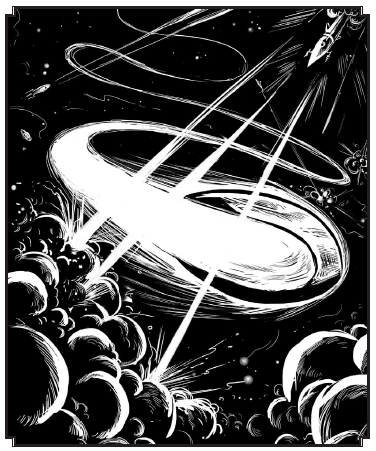
Genetic Modification Machine: The GMM is a coffin bed that puts the person inside into a coma as nanomachines and retroviruses change the species or gender of the occupant. You can augment the person inside or even add traits. However, it has limits. First, no cloning. Second, it only works on humanoids and can only turn you into a humanoid. Third, it only works flawlessly on Martians, armed with knowledge of Martians or Erisians/Venusians. This device could be used to recreate the Ancient Martians or remove breeding restrictions. The side effects for other species can be bad, ranging from sterility to other bad traits.
Heat Ray: A classic Martian weapon that agitated sub-atomic particles. Normally you can just shoot people with it, but it was used as an anti-air weapon as well because prolonged exposure to the radioactive heat beam will cause targets to violently explode.
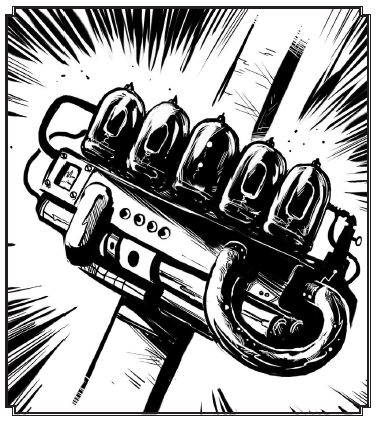
Mental Projection Device: The MPD is a throne attached to a fusion reactor and computer bank that gives the user psychic powers as long as they’re relaxing in the throne. Big caveat? You need neural interface plugs in order to use it. Because of the chemicals used to maintain a trance and because it was made for Ancient Martian minds, users either get a skewed outlook or damage and a skewed outlook as long as they’re in the machine and until the drugs wear off. The big exception is if a Venusian tries to use a MPD, which overclocks the reactor and sets it to a 15 minute self destruct.
Orbital Defense System: The ODS consists of a collection of spheres floating around Mars that can only be detected by the eye. If someone finds the control center on Mars, they can wake up the spheres which have reactors inside of them and the control center allows the operator to control them and fire RAY beams from the sky.
Planet Killer Rocket: The Ancients actually built two in case the first one failed or missed. Now, the first rocket managed to do the job and blew up Eris. There’s still the second rocket and it’s been missing for millennia somewhere beneath the sands of Mars and whoever finds it better be careful with it.
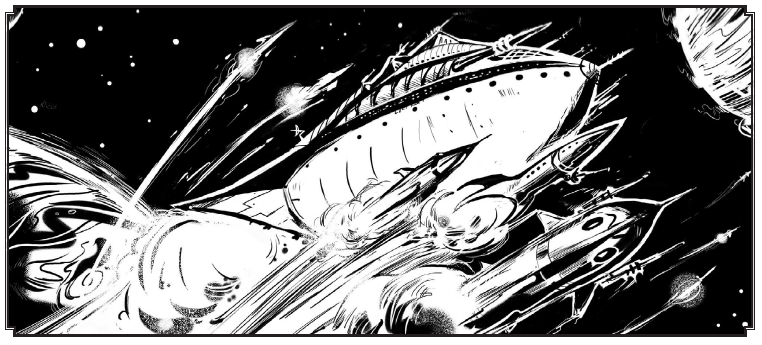
Remote Communicator: I’m not joking here when I say it’s literally a cell phone/smart phone but the network is down. They need close communicators or line of sight to work with each other.
Solar Powered Devices: This is less a specific type of technology and more that sometimes things on Mars have solar cells. They’re either broken from wear, tear and weather or inactive due to loss of light.
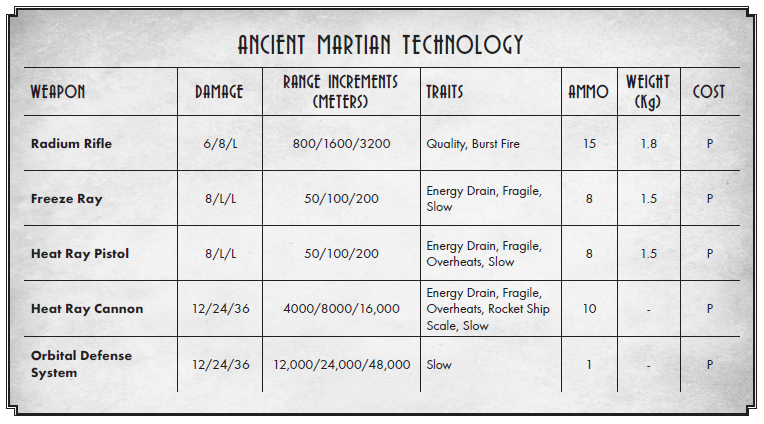
Finally, there are equipment traits which are used to change how equipment and items operate. There are a lot of them and I don’t find them as interesting as character traits but you can look at the example statblocks to get an idea what it is they influence. I feel a little bad that I didn’t go nearly as in depth as I could have, but I had to do it to preserve my sanity.
NEXT TIME: How to actually play Rocket Age!
GAME SYSTEM
Original SA post
GAME SYSTEM
Rocket Age’s system comes around kind of late in the book, which is a bit annoying but not a problem. The rules are somewhat simple and use a d6 system. Basically, if you need to do something and there’s a reasonable chance of failure/dramatic failure and you’re under pressure, you should roll.
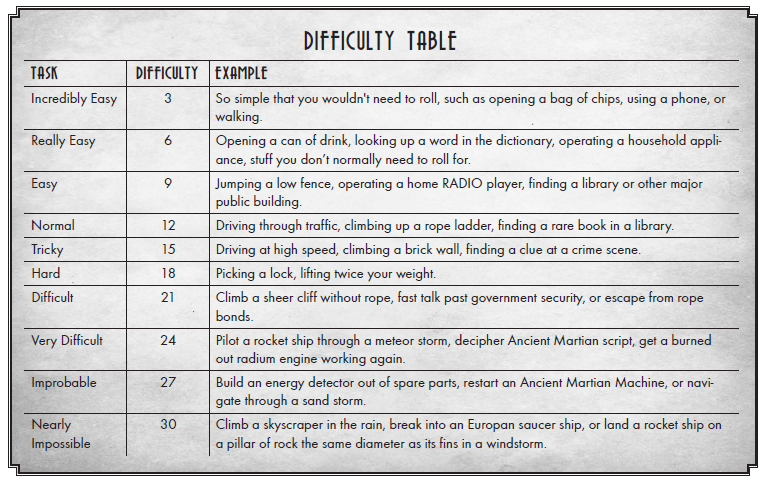
2d6+Attribute+Skill(+/-Modifiers)=Result matched up against a Difficulty number. There are varying degrees of success or failure depending on how over or under you roll. You can choose which Attribute and Skill you use to roll but it has to make sense. Go with your gut feeling but the GM has final say.
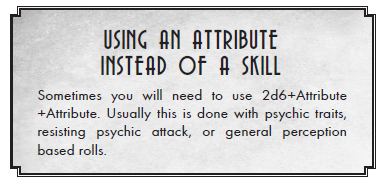
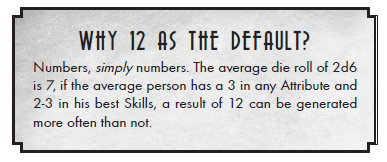
Contested rolls are a recurring thing you’ll see in these games. Basically one person is an acting character and the other resists. The one who resists rolls first and the result sets the difficulty for the one who acts. You can also Cooperate and help someone out if you have one rank in the same skill and all you do is add a +2 bonus to their roll (up to a reasonable limit of helpers).
Did you lose a conflict? That’s bad but you’re not necessarily going to get hurt. Depending on what’s at stake, you may get hurt or you may lose an argument or you may fumble a gun. There should be a sort of loss and sometimes you take damage. So what is damage? You may have noticed that there is no health pool or health track. All damage is deducted from your Attribute scores. You can split up the damage you receive and spread it across Attributes that make sense.
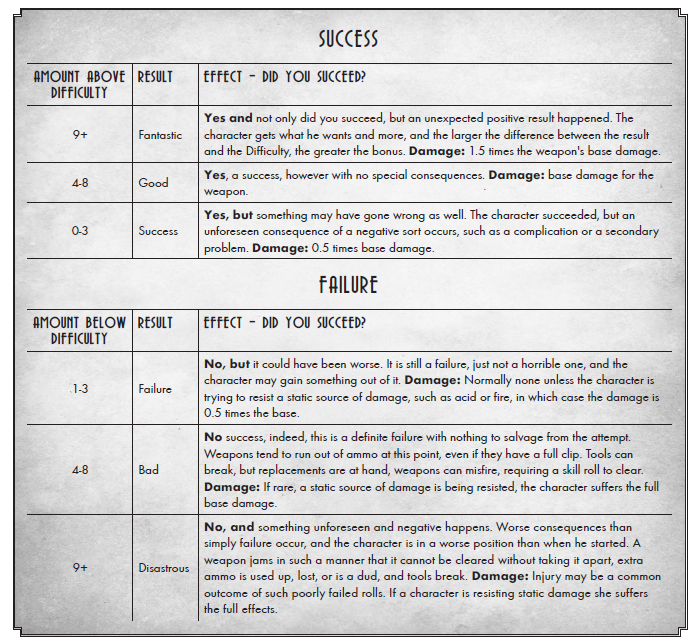
Injury comes in three forms: Stun, Normal and Lethal. Stun damage knocks the victim out for the rest of the scene or 1d6 minutes and deals 4 damage against armor (if it doesn’t penetrate, it’s shrugged off). Normal damage hurts Attributes and can be reduced by armor. Lethal damage outright kills and one point of Lethal is enough to kill a character. Lethal damage is marked with a L instead of a damage ranking and counts as 8 physical damage for armor or inanimate objects. Damage dealt is stable per weapon or item and increases or decreases depending on levels of success: normal damage, good damage and fantastic damage. For example: A RAY Pistol has 4/8/L for damage when not on its stun setting. A regular shot deals 4 damage, a good shot deals 8 and a really good shot instantly kills the enemy. If you remember the equipment charts for weapons, you'll see a lot of these attacks deal Lethal damage on the higher end of things or are just generally good at dealing damage. This is because physical injury is, well, dangerous and the game reflects that.
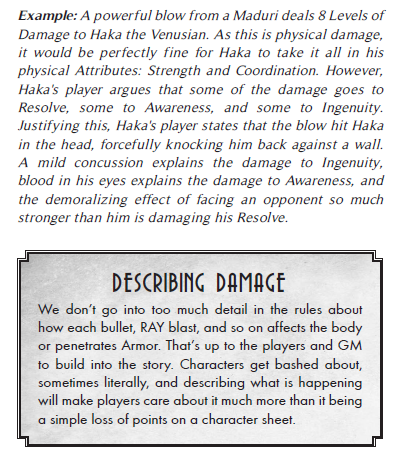
Reduced Awareness means that the character is dazzled or distracted or concussed. Reduced Coordination is exactly that, able to still stand but having trouble moving or coordinating. Reduced Ingenuity means that the character has lost their cool and is thinking irrationally or is confused. Reduced Presence means that the character's is feeling scared and timid and unable to speak. Reduced Resolve means that the character is close to giving up, feeling defeated or overwhelmed. Reduced Strength means that the character is weakened. When one Attribute is reduced to 0 from damage, it can't be used for rolls, the character is staggered and they take -2 to all rolls. Two Attributes means that the character is incapacitated somehow. Having Resolve and Strength incapacitated means that the character is beaten down and unable to muster the strength to continue without a rest. Having Presence and Awareness at zero means that the character is dazed and confused and unable to communicate, dumbfounded until they get their wits back. If three Attributes are at 0, that's really bad. This means that the character is severely injured or impaired in some way and will require the cost of a Story Point to keep them in the story and put them on the road to recovery. Insanity, fatal injuries, devastating emotional trauma and heavily impaired limbs are examples of being on the threshold of being kicked out of the story. At three Attributes at 0, the character can even be near death.
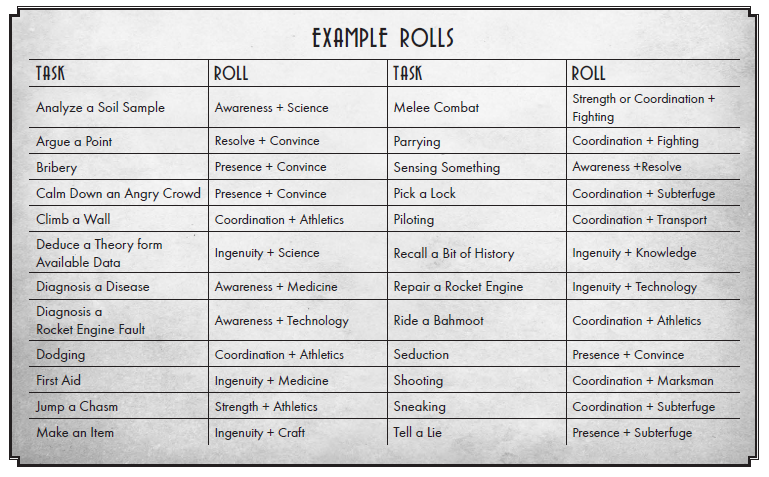
Mental damage is normally the result of a psychic attack, emotional damage or fear. Most of the time this targets Resolve to weaken the character and make them more susceptible to control.
Social damage is caused by arguments, debates, seduction attempts or intimidations. Social damage has some different rules compared to the other forms. Social damage is only limited to Resolve and Presence and any injury is recovered immediately when the scene ends. Losing both Resolve and Presence means that the character is worn down and concedes. Because social damage only targets these two, you can't put a character out of a story through social combat, only impair them.
Physical damage targets Strength and Coordination and might spill over to the other attributes. There are some specific rules for physical damage:
- Falls: 1 point of damage for 3 meters fallen, 10 damage max. If you fall from a failed roll, it's 3/5/8 damage for Failure/Bad/Disastrous.
- Crashes: take 1 damage per level of movement of the traveling thing.
- Drowning: 8 damage every 10 seconds, modified by how badly you failed the roll (4/8/12).
- Fire: 4/8/L damage depending on how badly you failed putting out/fighting the fire.
- Extreme Temperature
- Radiation
- Vacuum Exposure: Treat it as Drowning in Extreme Cold with 500 REM exposure. 30 seconds exposed to space is Lethal but can be resisted.
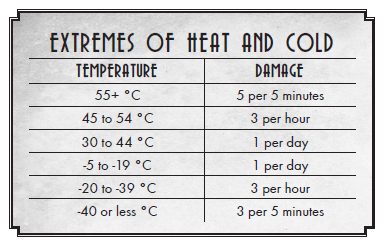
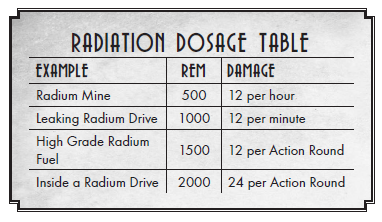
Disease gets its own table and list and actually these diseases are interesting! Resisting disease is Strength+Resolve and requires a flat amount of successes (+/- 1/2/3 depending on success or failure). Ingenuity+Medicine can be used to add to the patient's successes (or subtract if you're a bad doctor).
- Bahmoot Fever: skin rash from a virus commonly carried by Bahmoots, generally transmissible to other mammals. Causes fever, spreading rash and lethargy. Not generally lethal, just annoying. Try and take care of your Bahmoots to avoid it.
- Canal Choke: Bacteria that grows in stagnant Martian water or is caused by poor filtration. Common in more rural principalities, requires the water to be treated. Symptoms: burning throat, trouble breathing/swallowing, abdominal pain/cramps, stomach/throat rupture. Until recovered, a patient can only whisper.
- Europan Mind Burn: Bacteria that targets psychics. Symptoms: loss of psychic abilities, fever, headaches, bleeding from the eyes and nose, cerebral hemorrhaging, paralysis, coma and death. Europan Mind Burn is rare but nasty without medical care.
- Flowering Sickness: Allergic reaction caused by exposure to Ganymedian spores during Flowering. Coughing, sneezing, runny nose, rashes caused by Ganymedian spores taking root in the skin. Cure: limiting exposure around Ganymedian in question, anti-fungal medication followed by exfoliation of the skin.
- Io Ick: Cocktail of pollutants and microorganisms around Io. Setting foot on Io exposes the character to Io Ick, also carried by Ioite bodily wastes/fluids. Symptoms are mild but long lasting: headaches, lethargy, sinus swelling, running nose, hair loss, blurry vision, nosebleeds.
- Jovian Lung Mist: airborne gribbly found in the atmosphere of Jupiter. Lungs are basically the ideal place for the critters to live. Infection is quick and fatal: heavy breathing, chest pain, internal bleeding.
- Martian Red Sand Fleas: Blood-drinking arachnid critters that everyone on Mars knows about and hates. They're pests that ruin crops and hassle animals. Chanari remedies are the best for repelling them second to Earthling clothing and smells and such. Symptoms: fatigue, itching, rashes. Sand fleas aren't fatal but they might kill weakened animals.
- Space Madness: the cause is unknown but it seems to affect people confined to a rocket or space travel for a prolonged period of time. Space Madness eats away at mental attributes over time and doesn't actually impair the character, it just tracks the progress of Space Madness. Symptoms: headaches, paranoia, rashes, violent behavior. One attribute at zero: paranoia. Two attributes: homicidal urges. Three: suicidal compulsions. Cure: psychotherapy or getting off the rocket and getting your wits together.
- Venusian Bloat Worm: Larval parasite form of the Jade Winged Bee, an important pollinator. The wasp lays eggs in the orifices of large animals which hatch in three days and burrow into the soft tissues before forming a cyst and hatching. The worms hatch in a week. Symptoms: intense pain, disgust from having worms in you, rash, infection in egg site.
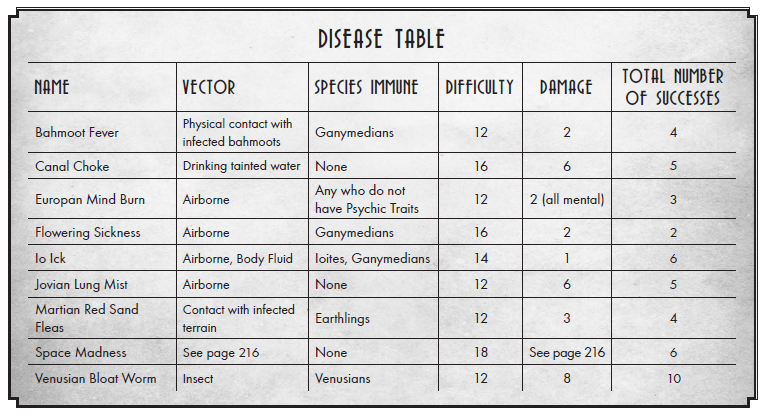
Poisons: Strength+Resolve to fight the poison and medical help can add successes to the patient's attempts to fight off the poison.
- Brain Slug Juice: Distilled from the Brain Slugs of Venus, the poison is effective against psychics. Venusians like to coat their weapons with the poison before fighting Europans.
- Death's Head Mushroom: Venusian mushroom, a white shroom with brown mottling that looks like a grinning skull. Eating it causes abdominal pain and internal bleeding. Making a syrup out of boiled mushroom causes all of the wounds inflicted to bleed without clotting and cause muscles to cramp and spasm.
- Io's Tears: Refined from toxins in the soil of Io. When eaten, the victim is paralyzed and damaged.
- Jeweled Scorpion Venom: Found on Martian scorpions and prized by assassins for its necrotizing properties. Runs roughshod through the blood stream when injected.
- Mustard Gas: mostly used by the Nazis and Italians on Mars because the Geneva Conventions don't apply against Martians.
- Succession: an Ancient Martian poison, rare and deadly and only found in ruins. Odorless, colorless, tasteless and leaves no telltale traces. In actuality, Succession is a deadly nanobot poison that destroys itself when the job is done.
- Tear Gas.
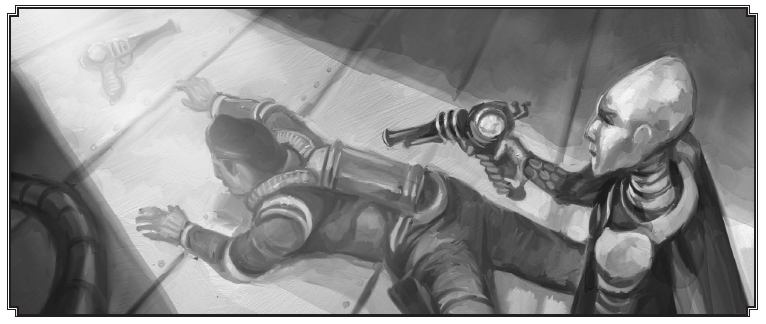
Armor is simply subtracted from the inflicted damage. Anything that penetrates armor halves the armor reduction. Hardened armor protects against all physical damage that doesn't have Armor Penetrating.
HEALING
So you caught the Space Madness, got kicked around by a bunch of Martian Warriors and fell off a large rock for good measure. Let's get better! As previously mentioned, social damage heals instantly. Without medical attention, recover 1 Attribute point of damage per day of taking it easy. With medical attention, heal 1/2/3 Attribute damage (depending on success level). All damage is healed at the end of an episode. You can never take so much damage that an Attribute is permanently reduced; you might get a Bad Trait but losing a limb won't make your Strength go down for good.
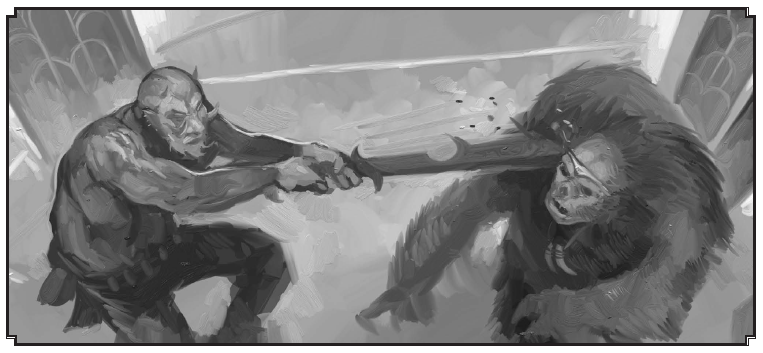
STORY POINTS
Story points have specific uses and using them doesn't lower your max total. Story points are gained for heroic actions, humorous roleplaying, self-sacrifice and overall driving the plot and engaging in the game. You should get 3-4 per 6 hour game session and your pool is totally refreshed at the end of a whole story. You can also add complications to the story to get story points. Example: you may be a rocket pilot but you can claim you've never flown this rocket before. The complications can only affect your character, so you can't force another character's Foe to show up to benefit you. Uses of Story Points:
- Get a hint or a clue from the GM, not a solution. Don't let the players rely on this.
- Defy death/bad things from having three Attributes at 0. There's still a price to pay in the form of Bad Traits or recovery time.
- Increase a roll by +2d6 in a life-or-death situation or when the needs of the plot need the PCs to succeed.
- Spend 1 point to lower the impact of a roll's failure or turn a failed roll into a minor success, one point per degree of success.
- Lessen the severity of your wounds during downtime and recovery, recovering half of your lost Attribute points with a story point to realize that the injury wasn't as bad as you thought.
- Improve reacting to an attack by an enemy to increase your dodge/parry/resistance.
- Suppress a Bad Trait for one action.
- Use a Story Point built into a Gadget to use it.
- Borrow the Skill level of someone telling you to do something to do it exactly as they tell you (with your own Attributes and Traits though).
- Give a story point to an ally that needs it.
- Activate a Trait.
- Bend the plot.
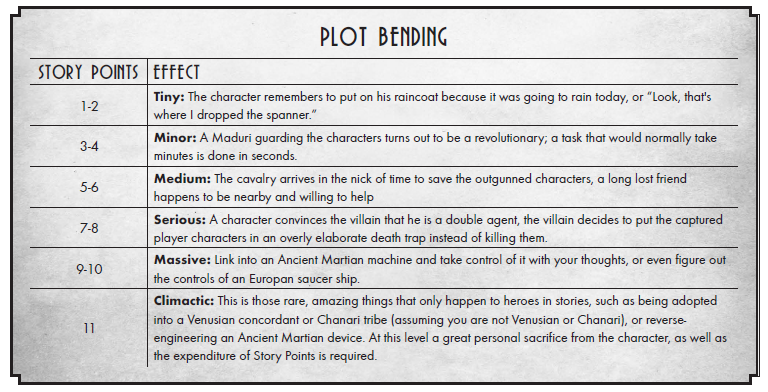
ACTION!
Rocket Age uses the Vortex System which was not developed for this game, just adapted. Originally it was created for Cubicle 7's Doctor Who Adventures in Time and Space. What does this mean? Well you might have noticed that physical combat is pretty lethal and the damage system means that when one person has an advantage, they will probably keep that advantage and keep pushing the advantage. Because it was originally developed for Doctor Who, the main purpose of the system is to start with talking and escalate to violence as a last resort. This is best shown by how action and combat goes down.
An Action Round is the amount of time it takes everyone to do something. Action Rounds range between two and ten seconds and is broken down into four phases: Talking, Moving, Doing, Fighting. The GM should set the scenes and sights and sounds and players and make it clear to the players what they're doing. Initiative is calculated by 1d6+the Attribute the character wants to use for their action that round. Each phase takes place in order of presentation.
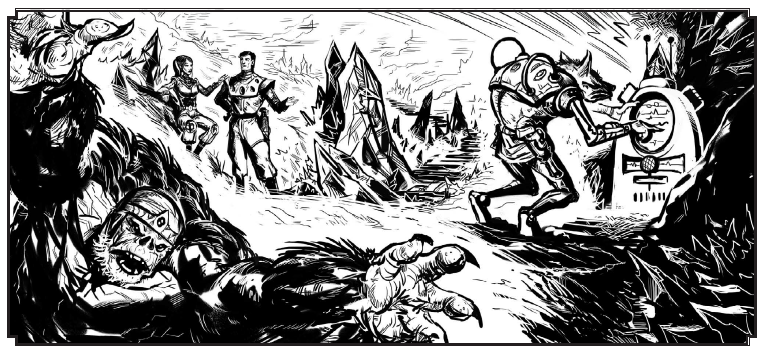
Talking: Debate, diplomacy, bluffing, using your words. You can tell someone commands for their phase or try to talk enemies out of their actions before the other players open fire.
Moving: Each phase can have a little bit of movement but the Moving round is for when your main action is going to be moving, jumping, running, dodging.
Doing: Anything not covered by the other phases, like repairing a Gadget under fire, treating a wound, picking a lock.
Fighting: Inflicting harm and damage on someone.
Characters can take one action per Action Round with no issue or spread a complex action across multiple phases. When a phase passes, it passes; you can't use a non-combat skill during the Fighting phase. You can also take one free Reaction per round to dodge or parry. Multiple actions can be taken but with a cumulative -2 per action past the first.
Combat goes last to emphasize other courses of action before killing people and solving problems with bullets. Attacking is generally Strength/Coordination+Skill vs. the Defender's Coordination+Skill roll to react. No reaction? It hits. The only defense beyond armor is staying out of the way of the enemy's weapons or aim. Damage depends on the Attacker's result vs. the Defender's.
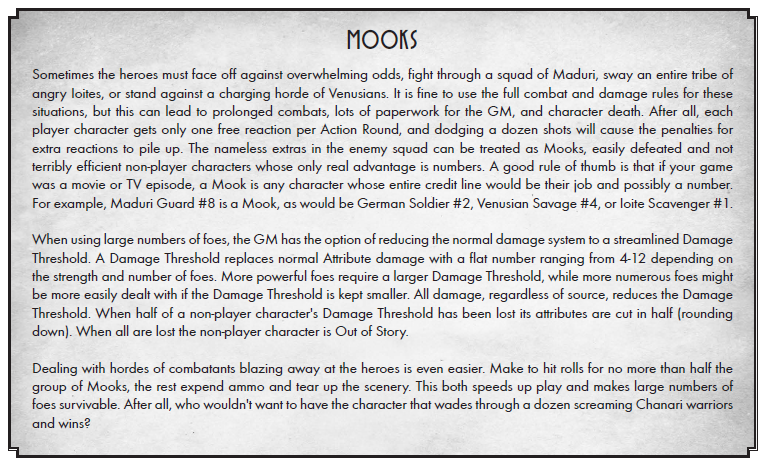
Range has three increments in meters: close, medium and long. All attacks at medium range are at -2, all attacks at long are -4. You can also attack at extreme range at -6 which is double the long range. Double the ranges in a vacuum, cut them in half if it's higher gravity. Aiming a weapon requires spending the entire Action Round aiming without doing anything else then makes a roll against a DC of 12, giving +2/+4/+6 to the next attack. You can only aim for one round but can fire the aimed shot at any time in the next round.
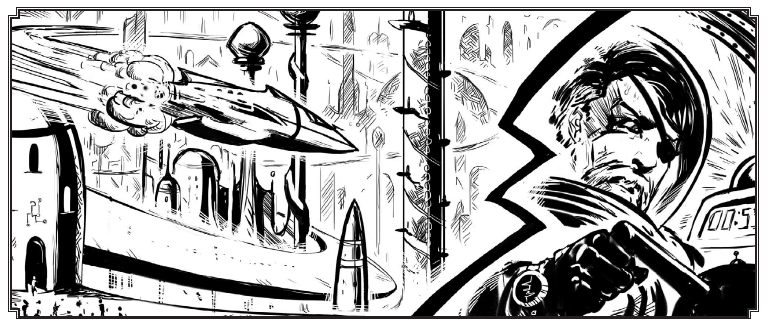
Chases are contested rolls and you can move equal to their Speed in Areas. Being on foot is way different from being in a rocket. Chases and pursuits are somewhat abstract in their execution; the important thing is trying to catch up or get away. There are rules for doing things during chases but I don't want to split hairs too much. Vehicles work the same was as people but with things like Handling and Sensors acting as their Attributes. Vehicle Attributes limit the relevant Attributes of the drivers, so if it has shit handling there's only so much your own Transport skill can provide. Vehicles have Handling, Communications, Sensors and Structure.
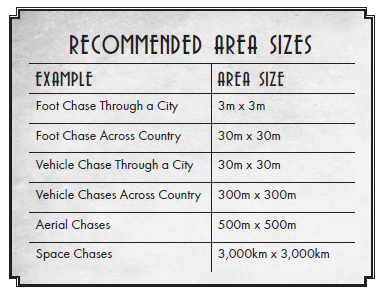
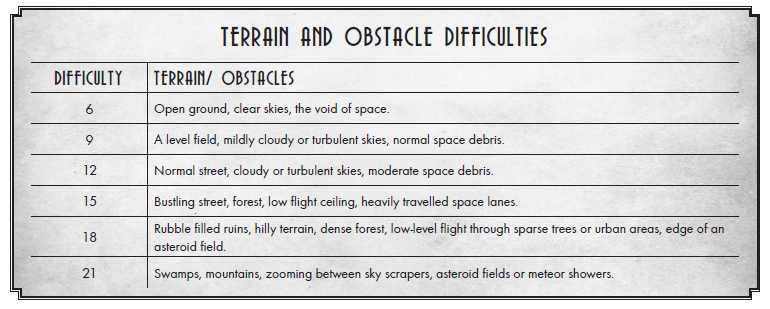
Psychic Powers are in a league of their own, barely understood by anyone but the Europans. Most psychic powers are only line of sight and requires Resistance by the target.
Gadgets are only available through purchase and permanently cost Story Points but have their own point pool.
And that's it for the mechanics chapter! This really did take me quite a while to do, it's a bit hard to chew through and digest but it's interesting. I dig the fact that it allows you to be a person of action but there's a place for negotiation and using your words over killing. Your job is to fight to make the solar system a better place and if bloodshed can be avoided and minds can be changed, great! You can save fighting for when words won't work.
NEXT TIME: the GM advice chapter.
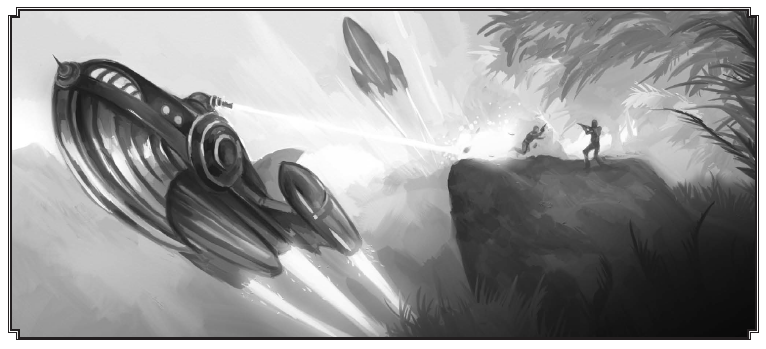
GM ADVICE, ALIEN BEASTS, ETC
Original SA post
GM ADVICE
Rocket Age keeps the GM advice nice and simple with four rules/recommendations.
0: Have fun and help enable fun.
1: The GM is always right. Translation: the GM can change parts of the rules and the settings if they want to fit the needs of your group.
2: The GM should be consistent, especially if they’re going to change things.
3: Be fair. You’re not the enemy of the players; you’re just putting obstacles in their path and the one who has to manage the flow and the action. Also don’t favor PCs or NPCs.
SERIES TYPES
Agents: Cloak and daggers adventures across the Solar System for popular organizations.
Explorers: Go out there and find you an Ancient Martian temple to explore!
Natives: Playing as alien species and dealing with the presence of humans and other races. Alternately, leaving your home planet to go to the stars and explore.
Pirates: Pirates!
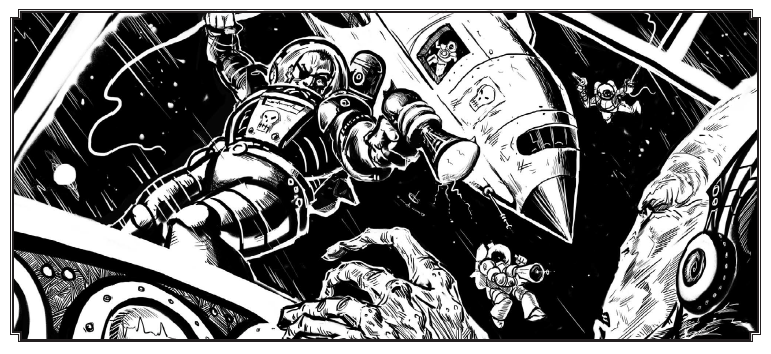
PIRATES!
Soldiers: Action and adventures, maybe even the beginning of a very different World War II.
A Ship and Her Crew: The classic staple of “you have a vehicle and the world is your sandbox”.
How do you play any of these types of campaigns? Frame them as reels like old serials called Episodes and break it down into first reel, rising action, climax and denouement. Don’t rely on cliffhangers but a good dramatic point is a great place to stop per reel. The book includes five example episodes. I won’t include everything to each story but you’ll get the gist.
BEYOND THE RINGS OF SATURN: Wealthy industrial magnate Jonas Hollingsworth is wheelchair-bound thanks to childhood polio, but he loves to have people travel on his behalf and expand his mind with their stories. The PCs are commissioned to be officers on his new ship the Argos. The Argos’ mission is to explore beyond Saturn and bring back information to share with the world. This mission is designed to be a sampling of the solar system while also including other elements as spice. Buy radium from Mars, Jovian politics to get past Jupiter, deal with a Nazi spy sneaking onboard the ship and find a sinister Nazi research base in the orbit of Neptune. In the end, poor Hollingsworth has died when they return but bequeathed the ship to the PCs. On the other hand, the Nazis are quite mad at the PCs and are likely raring for revenge.
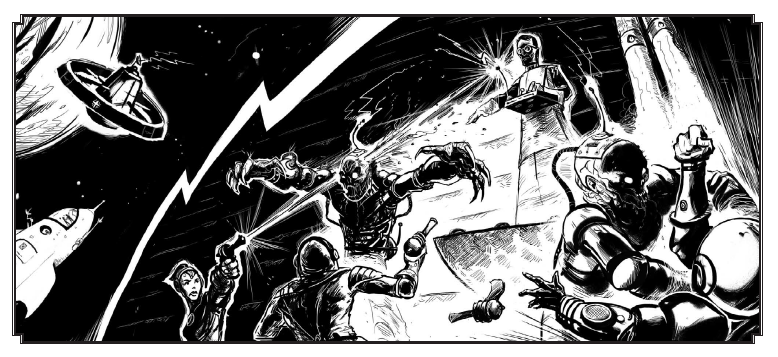
Weird undead Nazi monsters!
CRASH DOWN ON TITAN: Exploring the rings of Saturn goes terribly awry when the ship’s radium drive cuts out and the ship is forced to crash on the water planet of Titan. The H’ykar and Sivaan will be curious about the crashed PCs but don’t have anything to offer them in the way of industrial resources to help them repair the ship. Tensions might rise between species while a literal storm brews on the horizon. What will happen from the PCs being the ones to make first contact with undiscovered alien races?
DRUMS IN THE JUNGLE: Venusians have been attacking the Ore Fields. What’s worse is that they’re using human weapons. The Stony River Tribe is not a tribe local to the area around the Ore Fields. They have been infiltrated by Soviet-aligned Venusians who have tried to turn them into guerilla fighters. The plan was for them to strike and scatter. Unfortunately, the Stony River Venusians would rather push the fight and stand. The other Venusians are standing against them, the Rocket Rangers are trying to stop them and Major Reginald Stratford-Collingham is leading hunting parties against the Venusians. What will you do to stop the Stony River Tribe and will you dare take the fight to their Soviet agitators?
HAUNTED RUINS OF THE RED DESERT: The lost Ancient city of Atharnal has been abandoned since the destruction of Eris. In reality, it’s an abandoned research station full of the Robomen who were told to defend the facility. The combat Robomen used their heads and activated the repair and maintenance Robomen to construct a protective barrier. It still has power to this day and is a hive of Robomen defending and repairing the facility. And everyone wants a piece. The Nazis, a Prince’s army, a band of Warriors sworn to the Hamaxe lead an Orthodox Fellowship Priest, a Soviet exploration force and the PCs are all looking for the facility to get their hands on the technology. But nobody knows where the facility is. This isn’t even mentioning that it’s out in the desert past the Canal Zone and in the middle of the territory of three Chanari tribes.
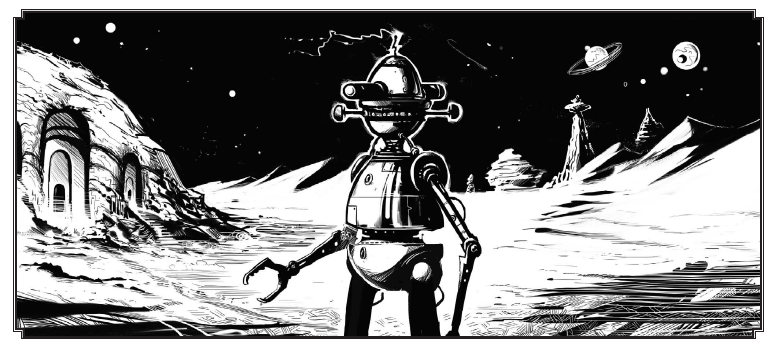
Martian robots!
MISSILE X: Dr. Everett Foster is a genius. A madman, but a genius. He believes that it’s the human right to rule the solar system, and to that end he thinks all of the Europans should die. He’s seized control of a deserted Ancient Martian city to establish a secret research lab. In this veritable evil genius lair, full of henchmen and assistants, he’s trying to build a planet-buster rocket to explode Europa. The mad doctor has kidnapped a British expedition force that was surveying the area and is holding them hostage until the launch. Are you bad enough dudes to stop the evil scientist?
ALIEN BEASTS
Arthur’s Dragon: Named for the late Dr. Arthur Wesley (who studied them for years), Arthur’s Dragon is a six-legged lizard with a meter-long tail and two meters long. They’re deep red and live out in the sands of Mars, hunting in the sands of the desert. The dragons are social creatures that live in female packs with female dominance. Males are chased out when they’re old enough and live solitary lives except for when mating season rolls around.
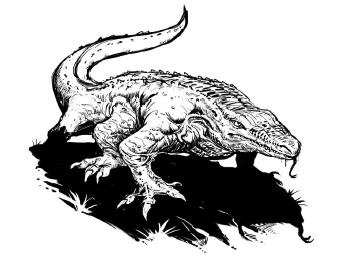
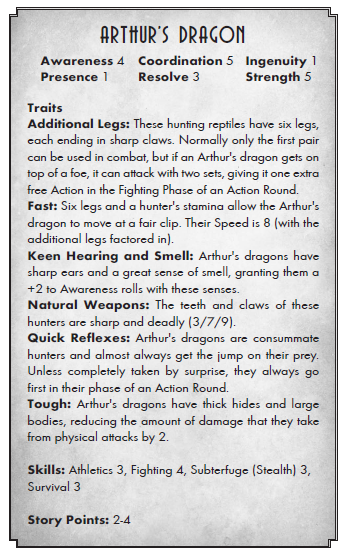
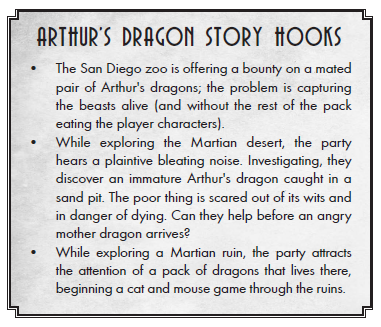
Bahmoot: The humble Bahmoot is the backbone of the Martian animal economy. Intelligent, loyal and hardy, you can ride one or they can pull a plow or cart. They’re slender with powerful legs and are mostly carnivorous, needing veggies and greens every few weeks. They come in many colors and have different markings and sometimes you can catch critters from them if you don’t keep them clean.
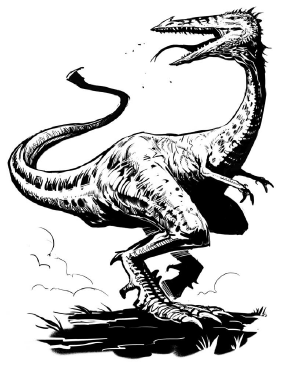

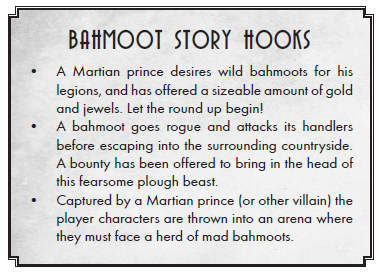
Callisto Yeti: The Callisto Yeti is four meters tall, three hundred kilos and only found on Callisto. The men have horns, the women do not. They are crazy strong and live in packs with single men having harems of females and defending a territory. If two territories overlap, the men fight to the death and the females will join the new male or wander off. Teen male yetis leave the pack and wander for a while until they form their own harem.
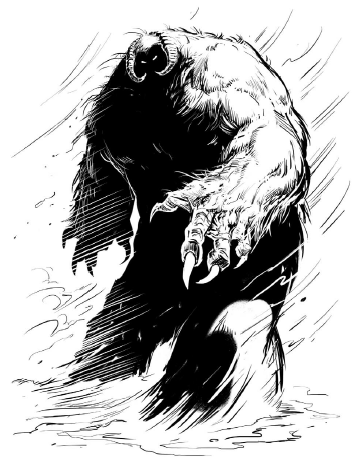
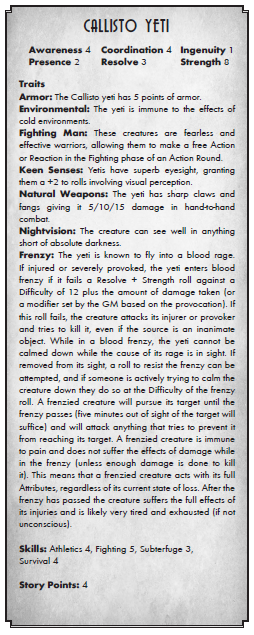
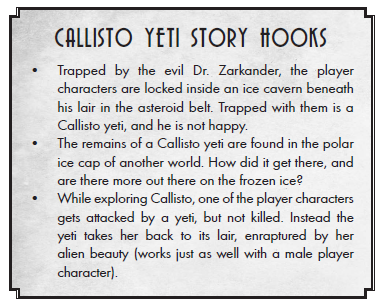
Darters: Darters are two meters long and live in the atmosphere of Jupiter. They’re kind of stupid and love attacking anything that flies. Their lamprey-like mouths are used to suck blood from targets and they fly in Vs.
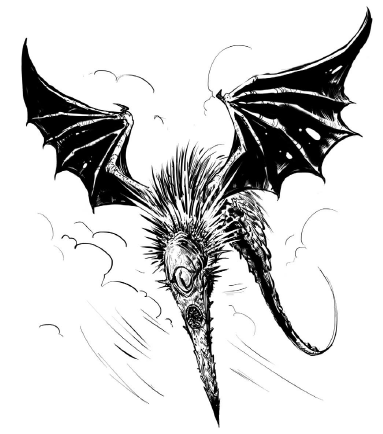
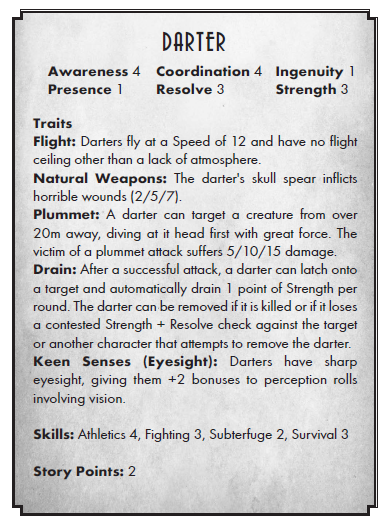
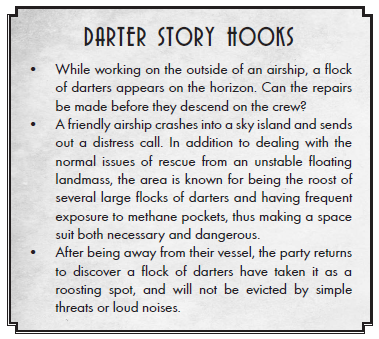
Jovian Gasbag: A cross between a jellyfish and a whale, a Gasbag is at least a kilo across and covered in wiggly tendrils and tentacles. They cruise the skies and eat anything their mouths scoop up or use their sticky tendrils to ensnare prey. They’re big targets for Darters and they’re not really intelligent or hostile, they’re just there.
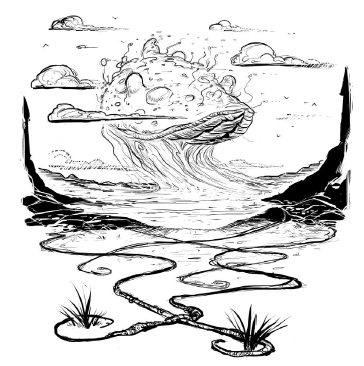
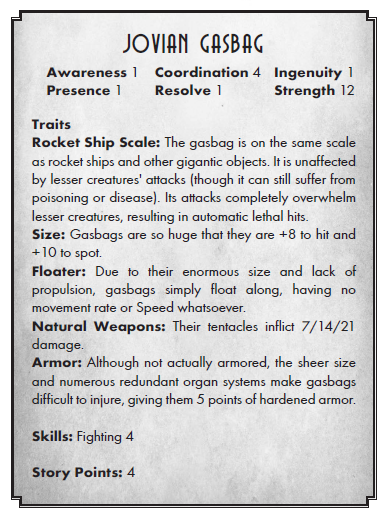
Jungle Tortoise: They’re four meters long, their tails are three meters long and they’re about 24 tons. They’re strict vegetarians and slow…but very good at charging at surprising speeds and heavily armored and quite strong. Unfortunately they’re gigantic targets for the hunters of Livingstone Lodge.
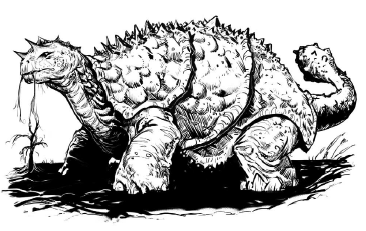
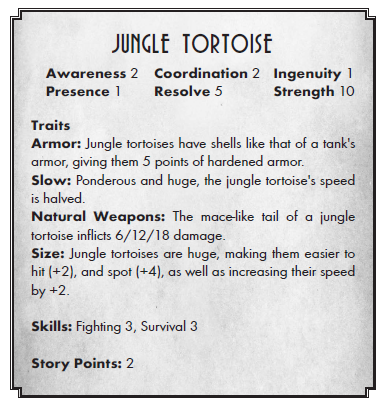
Trip Line Spider: A meter-tall with a meter-long leg span, the Trip Line Spider is crazy intelligent. They use their webs as literal trip lines, using the vibrations to track prey in the area and using the silk as triggers for pit traps, swinging logs and other dangerous complex traps. When the prey is incapacitated, the spider can take its sweet time to give it a venomous bite.
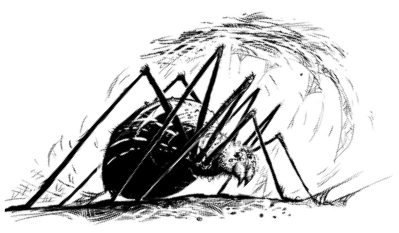
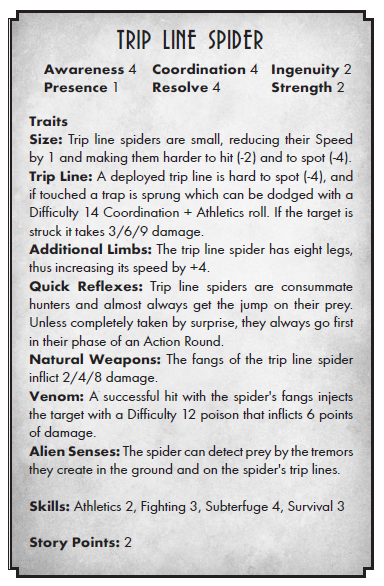
Sky Sponge: Jovian barnacles, except these barnacles emit an acidic spray when sufficiently provoked and they’re surprisingly resilient and immune to Earthly poisons to get rid of them. It’s a major hazard for flying on Jupiter, they’re tenacious.
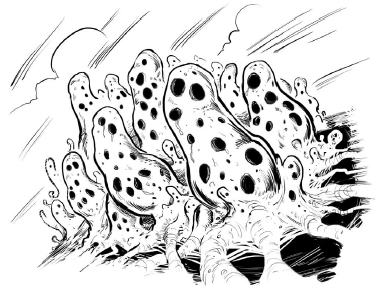
Thunder Lizard: The apex predator of Venus. Its eyesight is okay, its hearing isn’t good, it has no concept of stealth, but the Thunder Lizard is fast, full of sharp teeth and stunningly strong, strong enough to bite through a tank. They’re territorial except for a yearly mating season when they violently rampage around the jungle to find a mate, knocking down trees and openly fighting each other for mating rights. If you have to fight one, bring a big enough gun and then run when it still tries to kill you despite being mortally wounded because it doesn’t know it’s already dead. Thunder Lizards are hard to track, though: they’re naturally camouflaged with black, brown and green stripes.
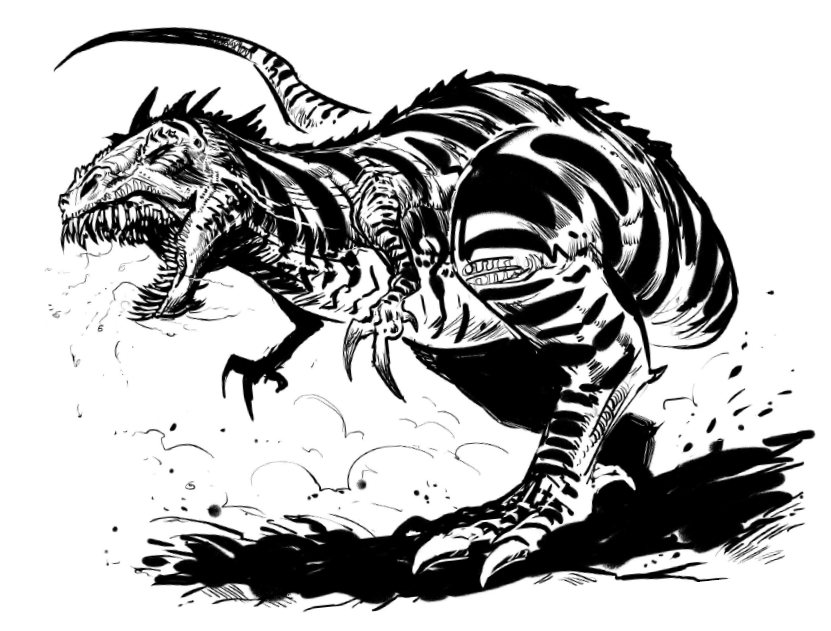
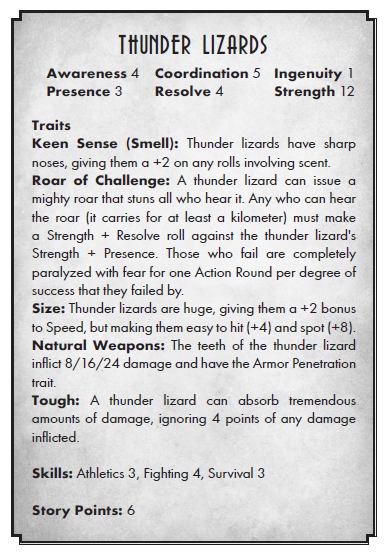
Quilled Lizard: A cross between a porcupine and an Ankylosaurus, the quilled lizard has a temper for a herbivore. It loves to club things with its tail and impale things on spikes, eagerly swinging away when provoked and capable of feinting attacks before going for a big strike. They’re yellow with red markings and their club tails are red with markings.
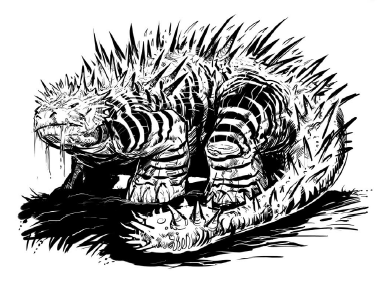
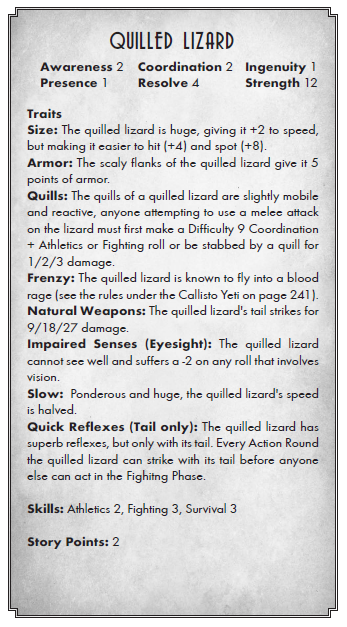
Tesselon: The Martian Tesselon is a cross between a baboon and a lizard, six-armed and dangerous. They’re smart, they’re excellent trackers and if you treat one with respect and training they make an excellent ally or pet. Priests and Warriors raise them as guards, fighting animals or household assistants, trying to breed them towards various traits.
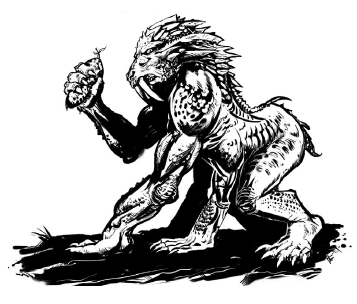
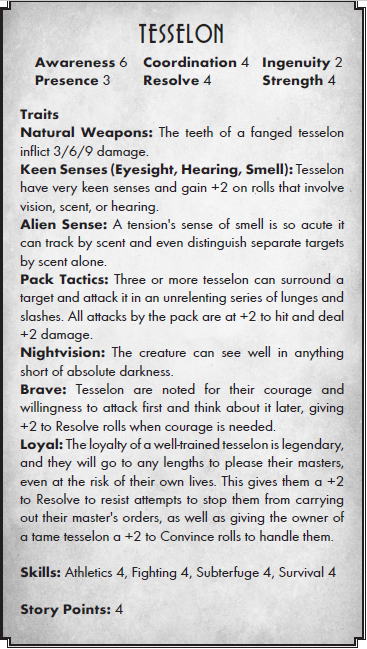
Ulodont: The Ulodont is a Martian beast of burden, six meters from nose to tail and incapable of going faster than a brisk walk. They can store water and fat for weeks on end, pulling things across the desert or being a form of transportation as you ride them.
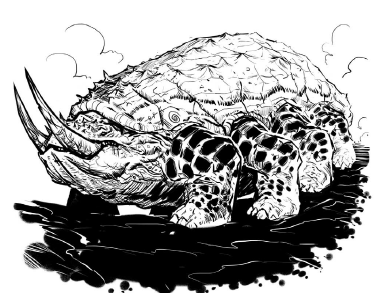
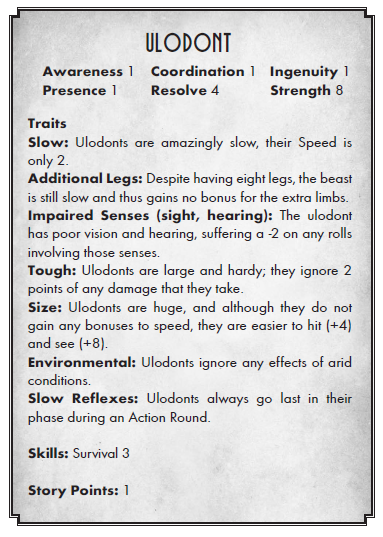
Winged Devil: Three meters long and ten meters wide, the Winged Devil is a terror of the Venusian skies. They ambush prey and hunt with stereoscopic vision, their jaws strong enough to crack bone with a good squeeze.
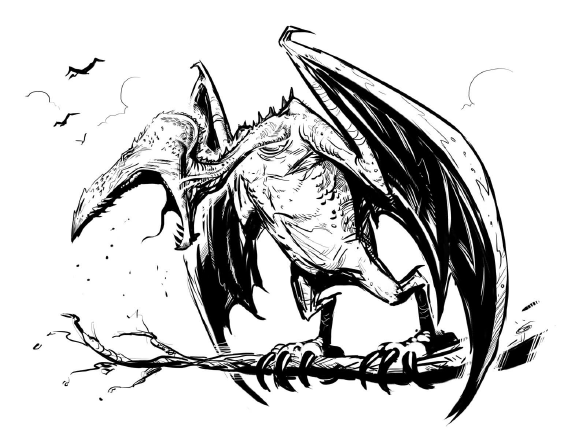
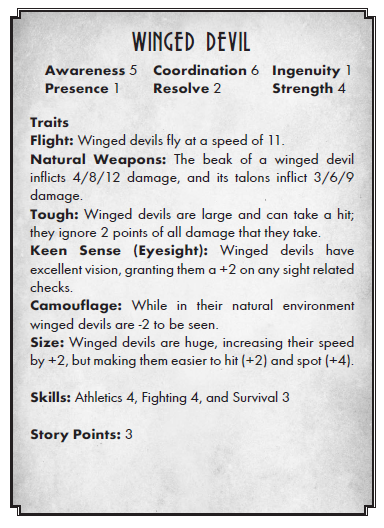
And that's it for Rocket Age! I still enjoy it quite a bit and I don't have much to say about it. I love the setting to pieces and I'm interested in the mechanics having an emphasis on talking first. They have four other books out as I type this: a sourcebook for Venus, a sourcebook for Mars, a species book for the old species and some new ones in one book and an adventure series book involving system-wide crime. I don't know if I'll approach them, maybe some time in the future. Anyone else can call dibs if they'd like. But thanks for reading and following and I'll let this end with the author's afterword.
